Learner Support at Korea National Open University and the Open University of China: a Comparison
Sun Hongfei1, Ji Ruifang2
Abstract: Learner support involves guidance for autonomous learning provided by distance-education colleges and universities, and plays a significant role in the success of distance learners. This paper compares the experiences and practices of Korea National Open University (KNOU) and the Open University of China (OUC) in terms of learner support, including tutorials, counselling, financial assistance, student mutual aid, and student organisations and activities. It analyses the similarities and differences of the various kinds of learner support offered at the two universities. The research shows that the two universities have a lot in common in terms of the contents and overall forms of service, but also that there are significant differences in their specific practices. Suggestions are finally made for changes in learner support at colleges and universities providing distance education in China based on the analysis provided.
Keywords:Korea National Open University; learner support; tutoring; student counselling; student mutual aid
Learner support can improve the quality and effectiveness of distance education, and is an important element of successful learning. With more and more attention being paid to the quality of degree continuing education, distance-education colleges and universities have made many reforms to teaching and to learner support. The OUC has made changes to online teaching, teacher management, and student-affairs management in an effort to provide better learner support and to improve the quality of both teaching and services.
KNOU was founded in 1972. It was the first distance-education university in Korea, and is the only national open university there now, offering degree education at the undergraduate and postgraduate levels, and comprising 13 provincial schools and 35 learning centers nationwide. It employs about 3,873 staff, including 2,990 part-time assistant teachers (Wang Xueshuang, 2015), and has about 137,000 students (KNOU, 2017), with over 90 percent of them being on-the-job students. It offers diverse, individualised, flexible and meticulous learner support that helps students complete their schooling and enhances their overall performance, abilities, and social responsibility.
Scholars such as David Sewart and Alan Tait have proposed that learner support should include collective teaching, tutoring, self-help groups, counseling, question–and-answer sessions, peer support, social activities, financial assistance, and student associations (Ding Xin 2008, pp. 101-110). Investigation has shown that tutoring, counselling, financial assistance, student mutual aid, and student organisations and activities have achieved a mature level of involvement in learner support.
KNOU and the OUC have a great deal in common in terms of educational purposes and teaching models. This paper looks at six key connections in the learner support at the two universities, summarises their common experiences and practices, and analyses the differences, and reasons for them, in an effort to help open universities in China offer better learner support.
I. Tutoring
Tutors are especially important as a means of learner support in distance education (Richard Freeman et al., 2008, p. 130). This paper analyses tutoring and its management at both universities, and compares them.
KNOU employs three kinds of tutors: tutors at provincial universities, online tutors, and tutors who are on university faculties (Yao Laiyan et al., 2015, p. 149). Tutors at provincial universities are mainly responsible for face-to-face tutorials; online tutors give online tutorials, and are similar to teaching assistants; and faculty tutors are usually part-time teachers from other universities, and conduct face-to-face and offline tutorials. Recently, provincial and faculty tutors have been increasingly interchangeable, and a new category, “academic tutor”, has come into being. Details are given in Table 1.
Table 1
Job Descriptions of KNOU Tutors

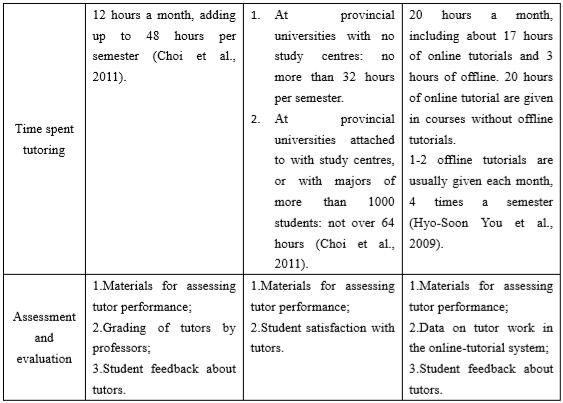
In line with the division of labour in teaching, educational units at various levels of the OUC employ teachers with different roles. For each specialty, course leaders are assigned to the headquarters, course coordinators are assigned to the branches, and course tutors are assigned to the learning centers (China Central Radio and TV University, 2006). Tutors are mainly employed at regional learning centers, and are the main group responsible for direct tutoring. They give face-to face tutorials at learning centers, answer questions online, and evaluate assignments. The online aspect of their work is becoming more and more central throughout the OUC.
Table 2. Job Descriptions of OUC Tutors
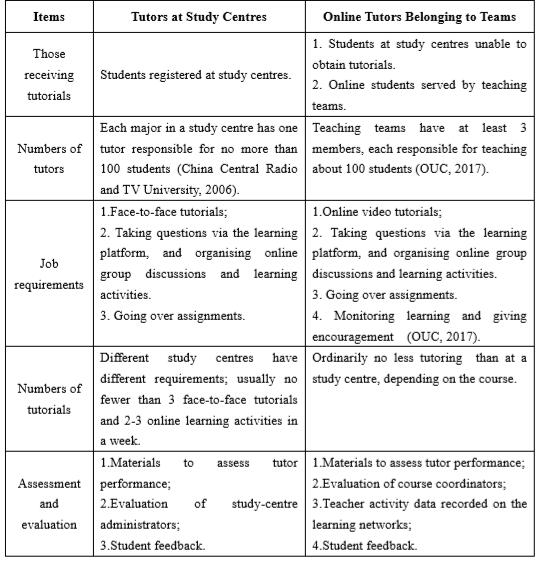
It can be seen that the two universities have a lot in common when it comes to tutoring. Both offer online and offline instruction; both offer face-to-face tutorials at the learning-center level; both assign online tutors to educational units above this level; in both tutors give tutorials, answer student questions, organise learning activities, and so on; and both monitor the performances of tutors and administrators, as well as the satisfaction of students.
In addition, however, there are some differences in the job responsibilities of tutors at the two universities based on their situations and operations.
First, they serve different target groups. Each category of tutor at KNOU serves a specific student group, such as new students, transfer students, online students, or students with greater general-education needs. In contrast, the two categories of OUC tutors generally serve all the students of a given major or course without more specific classification.
The second difference is in the courses they serve. The tutoring at KNOU is strongly related to the course categories; for example, online tutors and provincial-university tutors are assigned to online courses, and general-education and specialised courses, respectively. At the OUC, on the other hand, the connection is not so direct.
The third difference lies in the tools used to give online tutorials. The online tutors at KNOU give direct tutoring on the online platform, while faculty tutors give tutorials through a special tutoring system. In contrast, the two categories of tutors at the OUC both give tutorials via questions and answers on the learning networks.
The fourth difference is in the job requirements. Due the differing tutorial workloads corresponding to different students and courses, each tutor at either university has different numbers of students and time requirements. Each tutor at KNOU is in charge of more students than his peer at the OUC, with more specific requirements in terms of tutorial time and frequency. At the OUC, however, there are no unified requirements when it comes to work time and frequency.
The fifth difference is in job requirements. The tutors and lecturers at KNOU are clearly classified. The tutors have no responsibility to give lectures; this is up to professors or part-time teachers. Moreover, tutors do not usually go over assignments (Hyo-Soon You et al., 2009). In contrast, the tutors at OUC learning centers give face-to-face lectures, and the course coordinators of the teaching teams give online video lectures, and usually grade assignments.
Ⅱ. Student Counselling
The Student Services Centre exists at KNOU to deal with a variety of student affairs, not just academic ones, and give corresponding support. Attached to this centre is a call centre which offers telephone counselling. It takes and makes calls, monitors student satisfaction, and so on.
KNOU’s counselling services cover enrolment, registration, courses, examinations, graduation, career development, health, information technology and other topics over the phone, online, and face-to-face. Of these, career development offers information on job searches and career planning, gives training lectures, and helps students via both online and offline counselling. Students can either access online consultations through the university website, or get them offline by participating in psychological testing given at the university’s headquarters in Seoul, at a psychological-counselling workshop, or in group consultation. Health consultations offer information and services related to health and medical care, and cover basic health information, as well as assistance with first aid, such as cardiopulmonary resuscitation. Students can obtain information for free by logging onto the university website.
The Distance Reception Centre can be found in the OUC headquarters to answer student question about distance education. Some provincial branches have also set up call centres to offer their own consultation services. These offer information and receive complaints concerning enrolment, admissions, registration, course selection, assignments and examinations by telephone, email, BBS, and instant messaging. They also gather and analyse data on learning processes and return visits (Hao et al., 2011).
Both universities have established relatively complete consultation services, and have a lot in common in terms of how these services operate. However, the student-counselling services at KNOU are more diverse, covering consultations on career development, health care and information technology. The OUC does not yet offer services on career development and health care, while information-technology services are the responsibility of the technical-support department.
Ⅲ. Financial Assistance
Scholarships exist for a variety of student groups at KNOU. They include internal and external scholarships, depending on their sources, and the internal scholarships are further divided into the three categories: tuition exemption, tuition reduction, and cash awards.
The reduction or exemption waive part or all of the tuition fees and school supporting association fees1 , and are awarded for excellence or to members of the student union, social-security recipients, welfare recipients, members of low-income families, and graduates returning for more schooling. Cash awards include student assistantships and university development-fund or press scholarships, with certain amounts of cash being distributed at regular intervals. External scholarships are funded by the government or other institutions, and mainly consist of national scholarships. Some of these scholarships are set up by the university in accordance with the requirements of the funder.
Table 3. KNOU Scholarships
(KNOU, 2017)
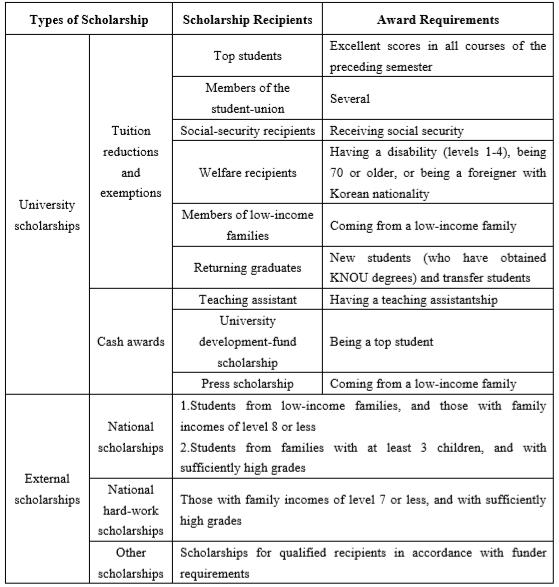
The OUC has set up four types of scholarships, and financial aid for students in the “Long March Belt” educational poverty-alleviation project, with university funds. Corresponding scholarships and other financial aid exist in all branches and learning centers. The names of the OUC scholarships and other financial aid, as well as the qualifications of recipients, are specified in Table 4.
Table 4. OUC scholarships and other financial aid
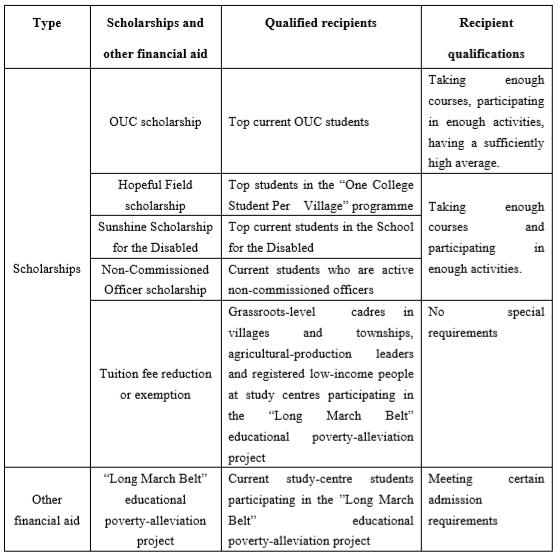
Both universities offer scholarships to a variety of students. KNOU has more sources of scholarship funding than the OUC; they include governments, enterprises, and other institutions outside the university, as well as the university itself. Its scholarships are more diverse, and have more recipients. The prize winners also include student-union leaders, social-security recipients, members of low-income families, and others, but are not offered for academic excellence. More OUC scholarships involve cash as opposed to tuition-fee reductions or exemptions, and some students receive student subsidies.
IV. Student Mutual Aid
KNOU maintains that most of the difficulties students face are ones they can help each other with, and because of this it has given older students responsibility for helping younger ones. This has become one of the most outstanding characteristics of the university’s learner support.
The older students help the newer ones get accustomed to the environment and educational approaches of the university. Those who have completed two years of studies, or graduated from the university, are qualified to become student tutors, and only students who have been at the school for less than one year, as well as transfer students, can be paired with them. Usually each student tutor has about 10 students to mentor, dealing with any questions they may have about courses and campus life. Provincial universities and learning centers also give face-to-face tutorials, and organise student activities (Kinee, 2011). A student tutor meeting certain conditions can get two volunteer credits and related certification.
Such guidance enhances the quality of support services, and is popular with all the students involved. Investigations have shown that the service enhances the interpersonal skills of student mentors, enables new students to quickly adapt to university life, improves performance, and builds friendships. Above all, it has significantly reduced the dropout and suspension-of-studies rates of new students (Kinee, 2011).
No such service is offered at the OUC, and there is less interaction among students of different years. On the other hand, each learning centers offers channels for student in the same class to help each other. For instance, the head teachers of the learning centers set up QQ or WeChat groups to facilitate this, and course tutors organise group-study activities during face-to-face tutorials or after class, or arrange online group discussions via BBS.
V. Student Organisations and Activities
Both KNOU and the OUC have a variety of student organisations to organise both curricular and extra-curricular activities, and to create a positive, friendly and harmonious campus atmosphere by relying on the autonomy and self-management capabilities of their students.
1. Student organisations
The student organisations at both universities include student unions, student associations and study groups (KNOU, 2017). Details about the three categories of students organisation are given in the following table.
Table 5. Student Organisations at KNOU and the OUC
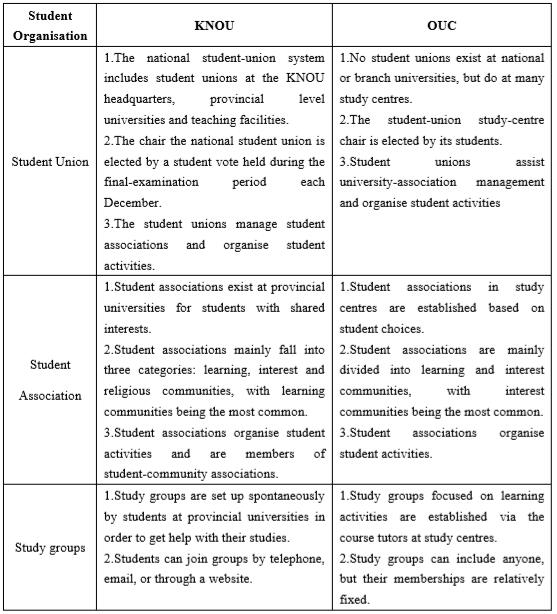
As Table 5 shows, both universities have established three categories of student organisation, each with roughly the same objectives. However, there are still differences. First, KNOU has established a student-union system that covers the headquarters, provincial universities and teaching facilities, while the OUC student unions mainly exist in local learning centers; second, learning communities account for the largest proportion of student associations at KNOU, while interest communities do so at the OUC, which has no religious communities; and third, study groups at KNOU are organised by students, who are free to join them, while those at the OUC are organised by tutors and have relatively fixed memberships.
2. Student activities
Both universities encourage and support diverse curricular and extra-curricular activities to promote student interaction and their all-round development. What’s more, both offer online and offline activities, with the provincial universities and learning centers organising more offline activities and the headquarters more online ones, and both support student activities by providing venues, guidance, funding, and computer technology.
There are also differences in the student activities that take place at the two universities. First, the organisers are different. Most of the student activities at KNOU are organised by the student unions or associations; some are launched by administrative departments, but organised by student unions. Meanwhile, activities at OUC headquarters and branches are usually carried out by administrative departments, while activities organised by learning centers are carried out with the help of student unions. Second, KNOU encourages students to participate in social activities and services by giving them up to two credits per semester for doing so. At the OUC, academic-prize-winning students are given credit for academic activities, but not for volunteering. Third, KNOU headquarters provides funds to outstanding community activities, while funding comes mainly from learning centers at the OUC, and only rarely from the headquarters and branches.
VI. Causes and Lessons
We have seen that KNOU and the OUC are both similar and different in terms of learner support. For the major aspects of this support their services are similar, with both paying attention to integrating online and offline services via information technology. However, KNOU pays greater attention to enhancing its operations, and makes use of information technology to a greater extent to provide students with diverse and individualised services. The tutoring is more targeted, the counselling more diverse and meticulous; the financial assistance is more extensive, and the use of older students as mentors is a well calibrated system. The system of student organisations is more sophisticated, more support is given to student activities, and the university offers new students more diverse services.
The root causes of these differences are the different management systems and operations of the two universities. KNOU’s provincial universities are its internal departments, and the headquarters has direct control of them; there are fewer educational levels. Therefore, the headquarters has more responsibility to coordinate tutoring, and is able to participate directly in services. A review of the OUC has shown that the headquarters, branches, schools and learning centers cooperate in running the school. The headquarters is unable to manage the human, financial and material resources of its lower levels directly, given the vast number of schools spread over a vast territory and with many different levels. For a long time, the headquarters has been mainly responsible for the planning, guidance and design of support services, and less so for their day-to-day operations. Support is mainly the duty of learning centers. As a result, the university service teams do not have a unitary mandate. The support services of the OUC differ from those of KNOU in terms of diversity, individual character, and degree of meticulousness.
Neither distance-education nor open universities in China usually manage or operate their learning centers directly; they mainly cooperate in running the schools. The support services in the headquarters of these universities are similar to those at the OUC. Therefore, lessons can be learned for future support services at distance-education and open universities, and the OUC in particular, by contrasting key support-service areas of KNOU and the OUC.
The first is to integrate standard services and offer them online.
Distance-education universities should promote coordinated management of support services by standardising learning centers services. The universities should set up online support-service portals that give students access to the services each learning center offers, including tutoring, counselling, and information about student activities. At the same time, service standards must be laid out, and compliance with these of every learning center ensured.
The second is to provide diverse and individualised services.
Distance-education universities should tailor their services to the different student groups they serve in terms of tutoring, counselling, funding assistance, organising community activities, promoting student mutual aid, and helping to solve learner difficulties. Furthermore, they should assist students with their needs in terms of professional development, first aid, social services and leadership training. In particular, universities should focus on helping students adapt to their new environment in all the aspects mentioned.
The third is to offer diverse and standardised tutoring services.
Distance-education universities should provide online face-to-face targeted tutoring to different categories of student groups and covering a variety of types of course, with particular focus on new and online students. They should set up web-based tutoring teams to make up for tutor shortages at rural learning centers. Furthermore, they should formulate standards to help determine who is to be tutored, the number of students, and how often and how long online face-to-face tutoring sessions should be.
The fourth is to integrate online and offline services via information technology.
Distance-education universities should optimise their services through information technology and the integration of online and offline services. They should provide both online and offline counselling by telephone and other means to give immediate in-depth mental-health and career-development advice face-to-face. Moreover, they should design online and offline activities to facilitate student participation in activities. In addition, they can provide ways to bring students together, both online and offline, for mutual aid and other purposes.
The fifth is to enhance student mutual aid.
Distance-education universities should encourage student interaction and mutual assistance. Universities should establish student unions, extend them to each learning center, provide student associations with financial and venue support, and encourage the students to manage themselves. They should borrow the practice of having senior-grade students or graduates give guidance to new arrivals via information technology. Furthermore, they should set up special scholarships for student-union members, offer credits to seniors giving guidance services, and encourage students to interact and engage in mutual aid.
About the Authors:
1. Sun Hongfei, a Master’s-degree holder and research assistant, is deputy director of the Academic Affairs Department at the Open University of China, No. 75 Fuxing Road, Beijing, 100039, 13811053897, This email address is being protected from spambots. You need JavaScript enabled to view it.
2. Ji Ruifang, a Master’s-degree holder and research assistant, is on staff at the Learning Resource Centre, Beijing Open University, No. 4 Zaojunmiao Road, Haidian District, Beijing, 100081, 13693323827, This email address is being protected from spambots. You need JavaScript enabled to view it.
Note:
1. The school supporting association fee was initially established to have parents assist in the construction of the university, with the fee as a financial back-up. Later this fee became one that students had to pay (Yang, 2000).
Works Cited
Ding Xin. 2008. International Distance Education [M]. Beijing: Higher Education Press.
The Open University of China. 2017. Open University of China Pilot Online Teaching Teams [Z].2016-12-30
Korea National Open University. 2017-10-10. Korea National Open University Data [EB/OL].
Korea National Open University.2017-10-10. Korea National Open University Scholarships [EB/OL].[2017-12-10].
Korea National Open University. 2017-10-10. Korea National Open University Student Activities [EB/OL].[2017-12-10].
Hao Heli, Feng Liguo. 2011. Open and Distance Education Call Centres [J].The Chinese Journal of ICT in Education (23):23-27.
Hyo-Soon You, Wei Yaping, Li Fanghong. 2009. Effectiveness of Blended Tutoring at a Large Distance University: A Case Study of Korea National Open University [J].Farmers’ Training in Science and Technology (1):11-14.
Richard Freeman, Chen Li, Feng Xiaoying. 2008. Planning and Implementing Open and Distance Learning: A Handbook for Decision Makers [M].First Edition. Beijing: Publishing House of China Central Radio and TV University.
Wang Xueshuang. 2015. Current Status and Development of Korea National Open University [J]. World Education Information (16):37-41.
Yang Jincheng. 2000. Analysis of Tuition Policy at Private Universities in Korea [J].Studies in Foreign Education (6):49-54.
Yao Laiyan, Sun Hongfei, Huang Shengtian. 2015. Korea National Open University: a Study [M].Beijing: Publishing House of China Central Radio and TV University.
Publishing House of China Central Radio and TV University. 2006. Teacher-Management Standards at Radio and TV Universities [Z].2006-10-30
Choi, H. S.,& Sung, J. H. (2011). Development Planning for Tutoring Systems [Z].
Kinee.(2011). KNOU Support of Freshmen and Transfer Students: a Mentoring Programme [Z].
Strategies and Logic for Continuing Education Reform in the New Era
Wang Yongfeng, OUC
The year 2018 marks the 40th anniversary of reform and opening up in China. Great changes have taken place in the education field in China over the past 40 years and Chinese education has now entered the middle and upper echelons of education around the world. Great progress has also been made in continuing education. However, we must also acknowledge that problems still exist in continuing education and that its position as the weak link of education remains unchanged. In a recent special interview with a journalist from People’s Daily, minister of the Ministry of Education (MOE) Chen Baosheng underlined that “Preschool education, special education, online education, and lifelong education are still weak links, and there are still gaps in education between rural and urban areas and between regions, schools, and groups.” Minister Chen’s statement is a reflection of the status quo and problems in the continuing education field. Throughout the history of the 40 years of reform and opening up, reform has been the power behind the development of, and a consistent topic for the practice of, continuing education in China. As far as degree continuing education is concerned, the reform of continuing education has always been a work in progress, from the establishment of the Radio and TV University and the system of “self-taught examination” to the implementation of “modern distance education project” and the establishment of the Open University.
Today, continuing education is at a new historical starting point where it is faced with a new situation, requirements, opportunities, and challenges. This paper makes fundamental propositions for continuing education reform in the new era in order to explore the relevant logical starting point, core path, and preconditions for reform by focusing on the logic and strategic issues of continuing education reform for the new era. It aims to establish “the proper access” to advance reform and explore a new path for continuing education reform. It also aims to share and learn from peers in academic circles, as well as act as a reference point for relevant decision-makers, researchers, and practitioners.
I. “Developing high quality continuing education that people are satisfied with” is the fundamental proposition for continuing education reform in the new era
Reform is the key to solving all problems in continuing education and implementing the decision of “improving continuing education” raised in the report of the 19th National Party Congress. Reform is necessary in order to develop high quality continuing education that people are satisfied with as part of the pursuit of “people-centric” value. Only reform can help continuing education to realise quality development.
1. “Improving continuing education” is a requirement and logical principle for the reform and development of continuing education
The report of the 19th National Party Congress stated that, “We will improve continuing education, step up efforts to build a learning society, and promote the well-rounded development of all our people.” This is the first time that the word “improvement” has been included in the Party’s top documents concerning continuing education; previously, the wording was a variant of “develop continuing education” or “step up efforts to develop continuing education.” The proposal of “improving continuing education” indicates the Party and the state’s new understanding of and requirements for continuing education. It is the logical principle and strategic direction to promote continuing education reform in the years ahead, and also marks that continuing education in China has since entered a new development period. The core feature of this development period is achieving the transformation from multiple and large scale development to high quality and intensive development.
A review of the history shows that 1978 was the start of the first “new era” for the development of continuing education in China. A radio and TV university system covering urban and rural areas all over China came into being after 1978 and plays an important role in continuing education in China to this day. The new decision made about continuing education at the 19th National Party Congress in 2017 has initiated the second “new era” for continuing education in China. “The second new era” of continuing education presents both opportunities and challenges. It kicks off against a background in which China has become the world’s second largest economy, when China is moving closer to the world’s central stage, when China is stepping up its efforts to transform itself from a large country to one with powerful human resources, and when mass higher education has become universal. Whether in terms of meeting the need for lifelong learning for all in order to promote balanced development in education, and improve human capital and the overall performance of the nation or in terms of the strategy of building a powerful education market in response to the people’s desire for a better life and to serve the Chinese dream of realising the great rejuvenation of the Chinese people, continuing education has embraced the new situation and requirements. It is faced with new missions and tasks.
2. Realising “high quality development” is the key to making rational choices and a scientific plan for the strategy of continuing education reform
In order to answer questions such as how to advance continuing education reform in an effective way, how to make a plan, what to start with, where the problems lies and what the difficulties may be, it is necessary to touch upon the design, choices, and implementation of the strategy of continuing education reform. The plan for and choices surrounding the reform strategy are a strategic issue in and of themselves. The strategy is closely related to the success and failure of the reform in terms of its results. A realistic reform strategy can achieve the expected results, whereas an unrealistic reform strategy may affect the results and progress of reform and even cause losses. Therefore, the issue of reform strategy needs to be taken into consideration from the perspective of strategy.
The most important factor in the scientific design and rational choice of the reform strategy is to choose the right focus, foothold, and starting point. “Quality” is the core “key word” for all the topics of today’s reform and also “the strong note of the era” and strategic base point for the development of continuing education reform. We should adhere to the principle of “high quality development”, establish the idea that “only high quality is really good”, and enhance the collective sense that “continuing education should be high quality education.” This is the fundamental standard by which we should judge and choose specific reform measures, and it is also the way for us to write effective article of continuing education reform. The realisation of high quality development should be the core objective of advancing continuing education reform. We must insist on quality first and make it a core part of our evaluation. The outstanding problems and systematic obstacles that restrict the quality development of continuing education must be accurately identified and solved. This is a shortcut for evaluating and making decisions about the reform strategy of continuing education.
II. The logical starting point of reform is to understand continuing education as “a separate type of education”
The advancement of continuing education reform should begin with establishing a logical starting point. The first is to understand and grasp the concept and meaning of continuing education, in order to clearly understand its positioning and boundaries. In the past, reforms swung without positioning and they were left as they were without much progress. This may be related to the failure to grasp the inherent characteristics of the object of reform from the very beginning or the failure to establish the boundaries of reform.
1. Continuing education as an independent “education type” has been defined from a legal perspective
Article 17 of the Education Law of the People’s Republic of China states that “China practices an education system comprised of preschool, primary, secondary and higher education.” Article 20 states that “China practices Vocational and continuing education and the development of various forms of continuing education is encouraged by the country in order to give citizens the chance to receive proper education in politics, economics, culture, science, and business, to promote the recognition of different kinds of learning results, and to promote lifelong learning for all.” In line with these relevant articles, further analysis shows that continuing education is a different kind of education in juxtaposition with school education and vocational education. Continuing education as an independent “education type” has been confirmed and solidified. Although they all fall into the category of “education”, school, vocational, and continuing education are clearly defined in terms of labour division and obviously differentiated in terms of functional positioning, training target, training objective, education form, education contents, and institutional system. For example, continuing education serves all citizens, which is what makes it fundamentally different from school education mainly oriented towards the school-age population.
Based on the above analysis, this paper defines “continuing education” as a separate kind of education within China’s education system. The term “continuing education” as used in this paper, if not specifically noted, is automatically recognised as including degree and non-degree continuing education. The relevant polices and measures raised in the research, and the relevant viewpoints and conclusions made, if not specifically noted, are also automatically recognised as being applicable to both degree and non-degree continuing education. This perspective is a cognitive prerequisite for this paper to study and explore issues pertinent to continuing education reform.
In order to advance continuing education reform and plan a reform strategy, it is necessary to further explore the differences and connections between continuing education and other kinds of education based on the well-defined concepts and connotations of continuing education. The first is to analyse and understand the differences between continuing education and school and vocational education by viewing them as different education types and to establish that they are in fact not subordinate to each other or intersecting with each other but equal to each other. The focus should be on understanding the different education systems that they practice. The second is to grasp the connection between them by keeping in mind that they are all just different “types” of education. They operate within the same education system, just with different functions and division of labour. There is no great gulf between them and students from each type of education can, in theory, be mutually recognised, interconnected, and transferred through credit, school registration, and degree i by following certain rules or agreements.
2. It is necessary to establish what continuing education is and is not
According to the related articles of Education Law, there should no longer be any doubt as to “what continuing education is” and “what continuing education is not” once we have a deep understanding of the position of continuing education as a “separate kind of education”. However, it may be necessary to take specific conditions into consideration. For example, can higher degree continuing education at the undergraduate and junior college level be included in higher education? Open universities fall into the category of continuing education but can they fall into the category of higher education? It is not always easy to find the answers to these questions.
The National Outline for Medium and Long-term Education Reform and Development (2010-2020) indicates that “Continuing education is an educational activity oriented towards all members of society after their school education, particularly adults, and is an important part of the lifelong learning system.” This is the latest definition of continuing education made in national documents. This definition is linked to the connotation of continuing education described in the Education Law, just from a different perspective. In order to have a good understanding of this definition, we need to clearly define what school education is in the first place. Does school education refer to “education provided by the school,” “education run by school” or something else? This paper will need to answer these questions.
In fact, such an understanding of school education will not suffice. For instance, there is almost no argument on the positioning of open universities in continuing education. However, this also means that open universities are no longer considered “school education” in line with our understanding of the Education Law. Nevertheless, the open university is indeed a university, and it provides and runs education. Therefore, an appropriate understanding of “school education” should be “when a person receives full-time education in various types of schools (campuses) at all levels as a formally registered full-time student.” Only when “school education” is defined in this way can we have a better understanding and grasp of the definition of continuing education put forward in the national education outline, and understand that the positioning of open universities as continuing education is indeed true to facts.
In response to the above questions, this paper hereby proposes a simpler definition. “Continuing education” means “individuals who continue to receive education.” The word “individual” underlines that the majority of learners are part-time registered students or on-the-job students; the word “continuing” emphasises the latest time calculated for one’s completion of receiving full-time education in school (campus) as a formally registered full-time student; the word “education” covers all kinds of new knowledge, new skills, key capacities, and overall performance, mainly referring to all kinds of high quality part-time education for the purposes of promoting individual professional capability, satisfying their own hobbies, and upgrading their degree to get diplomas and degrees (note: part-time education as mentioned here doesn’t exclude full-time learning or represent quality standard different from that of due full-time education).
Based on the simple definition of continuing education, not all of the “school education” currently included in higher education is continuing education. Likewise, higher degree continuing education at the undergraduate and junior college level is not (or does not belong to) “higher education” or “vocational education; conversely, higher education and vocational education don’t include higher degree continuing education. In particular, we should highlight that a “self-taught” examination system exists only as a kind of examination system instead of a form of education. Therefore, self-taught examinations and continuing education are not “on the same level.” These definitions and conclusions are of great importance in understanding this paper’s upcoming discussions and logic.
3. Considering the internal classification of continuing education from different perspectives
It is necessary to grasp the internal classification of continuing education from the following perspectives in order to advance its reform.
(1) From the perspective of learning contents and results, continuing education can be divided into two categories: certificate and non-certificate continuing education. Certificate continuing education can be subdivided into different categories according to the certificates the learners get. Broadly, it can be divided into two categories: degree and non-degree continuing education. More specific divisions lead to many specific categories (see table 1).

It is necessary to point out that some degree continuing education programmes are not necessarily allowed to apply for or grant degrees based on the consideration of this kind of classification. On the contrary, relevant courses from some non-degree continuing education programmes can also be granted credits and they are not necessarily all “non-credit courses.” It is up to institutions (universities) to decide whether degrees are granted without academic degrees or credits granted without degrees.
(2) From the perspective of different learning approaches, continuing education can be divided into distance (network, online, correspondence) continuing education, face-to-face (centralised learning in communities, auditing in the classrooms, and night classes) continuing education, and blended continuing education.
(3) From the perspective of different types of learners, continuing education can be divided into continuing education for on-the-job personnel, continuing education for the unemployed (retired), continuing education for professionals and technicians, and continuing education for other groups, such as continuing education for civil servants, workers, farmers, and military personnel.
(4) From the perspective of school operation, continuing education can be divided into continuing education run by schools and continuing education run by non-schools (social continuing education and training institutions or industries and enterprises). The schools can be subdivided into full-time schools engaged in continuing education, such as open universities (RTVUs), adult universities, and universities engaged in part-time continuing education, such as regular universities (including regular undergraduate universities and tertiary vocational universities). Regular universities offer continuing education and serve the social public mainly by setting up relevant continuing education schools or conducting continuing education training projects or give courses inside their relevant departments.
(5) From the perspective of talent development, continuing education can be divided into professional (occupational) capacity oriented continuing education, technical skills oriented continuing education, academic (innovative research) oriented continuing education, and continuing education oriented towards the improvement of citizen performance. Of these, professional (occupational) capacity is an advantage and characteristic of continuing education, technical skills is the weak link, the academic orientation is somewhat neglected, and the citizen performance improvement orientation is an area of growth.
III. The core route of reform is to practice problem-oriented “combined boxing” integrating top-level designs and key breakthroughs
The core of a scientific reform strategy for continuing education is to answer the question of what we should do. This paper asserts that the core path should be based on outstanding problems and difficult system and institution problems. It should adhere to the integration of top-level designs and overall planning with key breakthroughs and part priorities and practice a kind of “combined boxing” aimed at fixed strategic targets in response to the current state of continuing education.
1. A review of the existing problems in general and in part
Great progress and achievements have indeed been made in continuing education in China. However, an in-depth analysis reveals that some achievements can also be regarded as problems. Enrolment scale is one such example. 2.2961 million students enrolled in online degree education at the undergraduate and junior college levels in the 67 pilot regular universities in 2016. Such large enrolment has put pressure on the universities and made it hard to ensure the quality of talent development. Therefore, an analysis of existing problems in continuing education has to be made from the perspective of both grasping the outstanding and fundamental problems and further understanding hot issues that are drawing attention from leaders, social public, experts, and students.
First, there are quite a few problems, contradictions, and challenges in continuing education. These problems include unbalanced and inadequate development at the top level, uncoordinated and asynchronous development of degree and non-degree continuing education at the middle level, and inaccurate positioning, low quality, bad reputation, poor quality, unclear characteristics, insufficient vitality, and weak teaching team at the bottom level. This reform aims to solve these problems and remove these obstacles. To this end, more attention should be paid to finding out “the problems behind the problems”, discovering the complicated relations and connections between different problems, phenomena, and causes, and identifying the systematic and institutional causes of these problems. Overall, this will allow us to find a “one stop” solution to a range of problems.
The overall existing problems are mainly caused by a lack of unified top level design and a lack of systematic coordination at the national level. This is a fundamental problem restricting the reform of continuing education and also the root of a number of problems, such as incomplete laws and regulations in the field of continuing education, the imperfect leadership system, backward guiding ideology in school operation, and insufficient funds. Compared with other types of education, such as higher education and vocational education, continuing education is seriously lagging behind. Although continuing education has a long history and has a solid foundation and rich experience in system building in terms of practical exploration and innovation of its models, progress on the construction of a unified system with long-term guiding significance at the national level is basically at zero. To date, no special continuing education laws have been promulgated at the national level and no relevant special department regulations, development plans or daily management regulations have been issued to coordinate the overall development of continuing education (including degree and non-degree continuing education) at the MOE level. There is a lack of common understanding and effective system support for coordination between the MOE and other relevant commissions, industries, and local authorities with regards to the business and management of continuing education. The lack of special law and regulation systems leads to insufficient support for the reform and development of continuing education. This weak coordination has restricted long-term development.
Second, the scale of degree continuing education at some regular universities is too big to be brought under control. The past few years have seen an excessively rapid increase in the scale of online education enrolment at a number of individual pilot regular universities with low value diplomas, a low number of academic degrees, and low student success rate. Problems such as redirection of funds, the transfer of rights to school operation, and difficulty in effective supervision of teaching behaviours are becoming increasingly apparent and have drawn attention from the public and the media. These have become hot issues and focused problems in the domain of continuing education. It is difficult to try to settle the problems facing degree continuing education in regular universities using traditional thought and usual practice. In terms of implementation strategy, after the issuance of the nation’s top level designs on continuing educationm the reform of continuing education in universities can no longer wait. Instead, it should be planned and deployed simultaneously with the overall top level design for continuing education. Temporary measures may also be acceptable in some cases. Any of this will work only if the starting point is to solve practical problems.
The problem of low quality degree continuing education in some regular universities that has recently become apparent is mainly caused by a “dual track” operating system. Incomplete and imperfect systems and institutions that can ensure and upgrade quality are also a direct cause of these problems. These issues mainly present themselves in the following six respects. The first is that the existing school running system and the requirement of “quality first” have nothing in common, which is favourable to the expansion of enrolment but unfavourable to the improvement of talent development. Many people in society and the media are concerned about this. The second is that a scientific, reasonable, unified, and effective management system for quality and supervision has not yet been established. The relevant quality standards and regulatory systems are imperfect and the policies and regulations are divided. This is embodied especially by the “examination free entrance” admission system. The third is that government public service mechanisms and platform construction need to be strengthened, and there is no available normalised and standardised long-term innovative mechanism. The fourth is that the clearly incomplete and unbalanced fund input system. In face of a sharp increase in funds for the average student in full-time regular higher education, students of degree continuing education have never had such average student expenditure. The fifth is that the tuition system is not rationally or scientifically designed. Tuition fees remain long unchanged and the low fees cannot satisfy the need to upgrade talent development or to cover the cost of school running. The sixth is that there is no simple, easy, direct and effective incentive mechanism available. Although some incentives are written in policies, few have been implemented.
2. The purpose of top level design lies in stepping up efforts to formulate a new national system of continuing education
The construction of a “national system of continuing education” is not a new issue. “Advancing the construction of a national system of continuing education” was proposed early on in the 2011 Work Outline of the Ministry of Education. To this end, this paper asserts that the core objective of top level design for continuing education reform is to construct a new national system of continuing education from the perspective of exploring its reform strategy. This is a fundamental system innovation aimed at ensuring the future long-term development of continuing education. It is necessary to first clarify issues at two levels with regard to the construction of a national system of continuing education. The first is to clarify the construction strategy of national system of continuing education. The second is to clarify the framework and essential factors of national system of continuing education. This paper discusses these issues based on thorough learning and full implementation of the MOE’s work in combination with the new requirements for, and strategies of, continuing education reform in the new era.
The first is to clarify the construction strategy for a national system of continuing education. Although the issue of a national system of continuing education was put on the official agenda as early as in 2011, the MOE has not given further details on the specific meaning, advancement strategy, and construction path of this system. Today, continuing education faces a new theme and environment and the construction of a national system of continuing education should naturally keep pace with the times and make positive innovations. With regard to the construction strategy for this system, we can first set out to organise the research and design of the framework and essential factors of the national system of continuing education, and then organise tools to advance the specific construction and implementation of the system. In the long run, the goal is to establish the content of the national system of continuing education and solidify it through national continuing education law. If there is legislative difficulty in the short term, we can also act according to our ability seek the implementation of a national system of continuing education by way of decree of the State Council or regulation of the MOE. We will do what we can do first, make positive explorations, and advance in a steady way in order to accumulate experience and promote legislation at the national level when conditions are mature.
In addition, we will promote research, resource integration, and talent discovery in the field of continuing education in order to boost cross-functional communication and coordination, the arrangement and summary of local experience, and international cooperation and exchanges. The ultimate goal is to drive the consistent modernisation of the governance system and governance capacity of continuing education through the construction of its new national system. This will provide systematic and institutional guarantees and support for the development of continuing education with Chinese characteristics at the national level, lay a foundation for realising a new continuing education management system with complete systems, school-running standards and forceful supervision, and shape a new continuing education development pattern with reasonable scale and structure and optimised layout.
The second is to clarify the framework and essential factors of a national system of continuing education. This paper hereby presents a framework overview of the national system of continuing education (see figure 1).
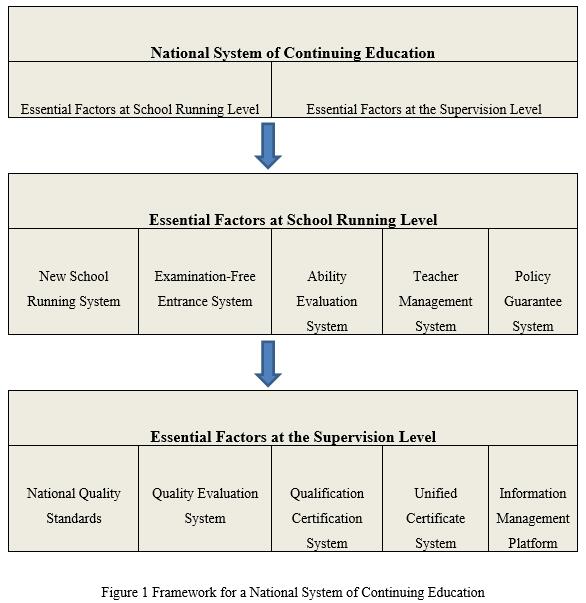
The following are discussions on the ten essential factors affecting a national system of continuing education at both the school running level and supervision level.
First, essential factors at the school running level, which include:
(1) Establish a new national school running system for continuing education and promote the integrated development of different forms of continuing education in order to find their respective positions and demonstrate their respective advantages. In order to position continuing education as a separate type of education, we should cancel the existing “adult higher education” system and its corresponding institutional system and establish a new school running system of degree and non-degree continuing education under the new lifelong learning concept. A rational division of labour and positioning between regular universities, adult universities, and open universities (RTVUs) in order to offer degree continuing education, gradually promote regular universities and bring into play their teaching advantages in different disciplines, and provide high quality non-degree continuing education oriented towards all members of society.
(2) Establish a unified national “examination-free entrance” system for continuing education and enact “autonomous enrolment, admission according to ability, tolerant entrance, and strict graduation”. Continuing education is open education oriented to all citizens; the option to receive continuing education is both a need and a right. To this end, it is necessary for continuing education to practice a learner-centric examination-free entrance system. On one hand, educational institutions should scientifically and appropriately admit students according to their actual abilities; on the other hand, from the perspective of “quality first”, the government should set a maximum enrolment scale for educational institutions.
(3) Establish a national system for the evaluation of degree continuing education graduates and promote the transfer of focus from “degree” to “capacity”. This system not only directly tests the students themselves but also indirectly reflects the talent development capacity educational institutions. In practice, this system can be implemented by a qualified third party social institution approved by the Ministry of Education under its leadership and management. The evaluation results will be one the most important references for evaluating the quality of educational institutions, and should be pegged to specific policy levers such as funding, resource allocation, entry and exit, and awards and appraisals.
(4) Establish a new national teacher management system for continuing education and foster high quality teaching resources. We will pay attention to the laws and characteristics of continuing education in light of the spirit of the “Opinions of the Central Party Committee and the State Council on Comprehensively Deepening the Reform of Teacher Team Building in the New Era” and establish a new dynamic and open continuing education teacher management system oriented towards society. Practical ability and actual contributions will be upheld as the first principle in post assignment, professional title evaluation, award evaluation, and professional development. The focus should be on creating a high-level full-time and part-time teacher rank that can be developed and implemented during the course of deepening reform, overcoming difficulties, and imparting knowledge.
(5) Establish and improve the national policy guarantee system for continuing education to make up for the supply-side weaknesses of continuing education reform. Continuing education, which is positioned as a separate type of education and is oriented towards serving and meeting the lifelong learning needs of all the citizens, should not merely be taken as a kind of theoretical discussion. It should become the basis for real legislation deployment, policy supply, resource allocation, fund input, project arrangement, organisation leadership, and organisation structuring. Positive efforts should be made to establish a special leading body and budgetary fund account for continuing education in order to ensure the position, benefits, and expectations of continuing education within major reforms, important policies, and key projects on the future of national education.
Second, essential factors at the supervision level, which include:
(1) Establish a national quality standard for continuing education. Firstly, standards are needed to uphold and realise the high quality development of continuing education. The construction of standards should integrate international experience and build upon it according to China’s national conditions. It is also necessary to coordinate degree and non-degree continuing education and reciprocally support unified standard and highlighted features. This standard will help in unifying the concept, enhancing common understanding, drawing a clear distinction of the base line, and encouraging innovation to create a fair environment. As a result, it will be possible to set an industrial model and drive the initiative in learning from each other, catching up to the most advanced level, and helping the less advanced through comparison. The construction of national quality standards should cover all the factors affecting the quality of continuing education, including specifications and index descriptions on all the aspects of education and teaching, all the links of talent development, and all levels of human, financial, and material resources.
(2) Establish a national evaluation system for continuing education. Following the establishment of a national quality standard of continuing education, the establishment of a matching national quality evaluation system will help to realise the unification of quality requirements, implementation, and evaluation. The MOE can take the lead in organisation or delegate power to relevant evaluation agencies to enable the regulation of quality evaluation of continuing education institutions all over China, and to publicise the evaluation results. Evaluation is an important measure for the educational administrative departments to advance reforms to streamline administration, delegate powers, improve regulation, and strengthen services. It is conducive to promoting self-discipline in the industry and to realising the entry and exit of the industry. Any continuing education institutions evaluated as unqualified should be rectificated or suspended. A third social party should be actively introduced to participate in the evaluation and factors such as learners’ learning satisfaction, students’ performance after graduation, and employer evaluation should be included in the evaluation results.
(3) Create an overall qualification certification system for continuing education. People who have passed all of the specific certification items can receive an overall qualification certification and be given certificates. These specific certifications include a number of items, such as operation conditions and facilities, level of information technology, disciplines, specialties (projects), courses, credits, certificates, degrees, and teachers of continuing education institutions. In view of certification, the voluntary acceptation principle should be practiced (although, in principle, all state-run continuing education institutions must be involved). Certification results should be publicised as a mechanism by which people can evaluate and choose continuing education institutions. Specific certification implementation can be undertaken by a qualified third party with the approval of the Ministry of Education. In addition, certification shall be given to courses and credits at continuing education institutions, which will also help to lay the foundation for the construction of a national credit bank.
(4) Establish a unified and complete certification system for national continuing education. Continuing education, as a separate type of education, should have a special, unified national certificate system, which mainly deals with unified national continuing education credit certificates (requirements: completing the fixed courses for degree or non-degree continuing education and meeting the credit requirements); course completion certificate for non-degree continuing education (requirements: completing fixed single continuing education courses) and project completion certificates (requirements: completing a set of fixed continuing education courses); special completion certificates, graduation certificates, and partial completion of degree continuing education certificates; and degree certificates (only given to people who reach a certain academic level or professional technical level). Of these, the most difficult to innovate is degree certificates for continuing education, although this could also become a highlight of continuing education reform, for example by leading the innovative exploration of an associate bachelor degree system for continuing education and a professional technical degree system for continuing education.
(5) Establish a national information management platform for continuing education. Due to its large service group, numerous management departments, various forms of education, flexible learning methods, and multiple school-running subjects, continuing education has made no breakthroughs in building a unified continuing education management platform and corresponding information system at the national level for years. Nevertheless, this task is indispensable in order to push forward continuing education reform. It is also a major link in the national system of continuing education. With this in mind, it is necessary to make full use of modern information technology, positively apply the emerging technological achievements of internet, big data, artificial intelligence, virtual reality, and block chain, and accelerate the establishment of a unified national information management platform. The information statistics system built on this platform will provide data analysis services for scientific decisions in the domain of continuing education with the aim of bringing modernisation, informatisation, convenience, and intelligence to the field of continuing education.
3. Key breakthrough should begin with prioritising the launch of the systematic and institutional reform of degree continuing education in regular universities
At present, the quality of degree continuing education in some regular universities has become an issue for the entirety of continuing education reform and the quality of online degree education at some pilot universities is a particular headache. A rational judgment should be made between quality and scale, and between economic returns and social benefits in order to promote continuing education reform in the new era; otherwise, it will be hard to advance reform. In order to implement the spirit of the 19th National Party Congress and adhere to the “quality development” principle, the main task for future reform is to abolish the dual track operation system of running schools, thus eradicating the system “same school with different qualities” and reshaping the quality of degree continuing education at regular universities. This paper puts forward the following six strategies for targeted implementation, targeted reform, and prioritised development by integrating the relevant system and institutional barriers and restrictions that have an impact on the quality of degree continuing education of regular universities as mentioned above.
The first is to reform the education system. Degree continuing education should be established as a part of talent development in regular universities in order to gather degree continuing education and full-time higher education under the “same major” as in regular universities within the same discipline (faculty and department). An education system for degree continuing education in regular universities “with the discipline as the main body” should be established for students of both continuing education and full-time higher education in the same major in order achieve “learning in the same school, taught by the same teachers, following the same standard, reaching the same quality, obtaining the same certificate, and getting the same degree”. Once such a reform is made, some regular universities will be able to continue to evaluate the necessity and feasibility of degree continuing education.
The second is to reform the internal and external management system. The development principle of “quality and benefit first with unified policy” should be upheld in order to gradually explore the establishment of standardised and perfect, scientific and rational, and unified and effective degree continuing education management system in regular universities, and to promote the realisation of a centralised management by specialised departments and guidance with respect to different classifications. An evaluation of the quality of degree continuing education in regular universities should be made as early as possible. In line with the spirit of streamlining administration, delegating powers, improving regulation, and strengthening services, the unified examination system of online education in pilot regular universities should be cancelled as soon as possible. We should rely on information technology approaches to strengthen the management of teaching behaviours in degree continuing education, as well as supervision during and after the process. A flexible and open learning and teaching management system should be established according to education law and the needs of the students. Regular universities should also be given more autonomy and power to make decisions.
The third is to innovate the public service system. The public service mechanism and service support platform should be constantly improved by building industrial organisations and expert think tanks serving degree continuing education in universities. We should also organise collaborative innovation research targeted at major issues. A development foundation and project should be set up for continuing education teachers and management staff in universities in order to support the improvement of their professional level and capacity. We should organise the evaluation of excellent achievements and the exchange of experience in degree continuing education in universities. We should set up a channel and mechanism for reporting problems and proposing suggestions. A special continuing education management agency should be established to strengthen policy coordination and public services.
The fourth is to reform the investment mechanism. It is necessary to create a rational fund investment standard for degree continuing education in regular universities by making a scientific calculation of the total costs and expenses needed for talent development with reference to the existing regulations on continuing education fund investment for full-time students of higher education from the MOE and investment for professional technicians from the Ministry of Human Resources and Social Security. A diversified fund input guarantee system should be established in order to unify factors such as national-level finance input, self-financing, social sponsorship and donations, and tuition fees paid by students. The realisation of the “zero breakthrough” of fund input for degree continuing education students in regular universities will alleviate the problem of unbalanced, inadequate, and unfair expense input among different types of students.
The fifth is tuition reform. Concepts such as public welfare, dynamic adjustment, evidence-based fees, value for money, mutual voluntary basis, and consideration of fairness are used to establish a tuition system for degree continuing education in regular universities. It is up to the university to design its own tuition system and the fees and policies can’t go into effect until they are recorded by the department in charge of tuition fees. The scientific establishment of rational fees is not only necessary to cover school running costs and meet minimum quality requirements; it also reduces the burden on students. Students of continuing education and full-time higher education from the same major in the same year can be charged different fees in accordance with the actual situation. In principle, tuition fees for continuing education students may be higher than that of full-time students.
The sixth is to improve the incentive system. A more effective learning incentive system directly oriented towards individuals receiving education should be explored. A system of allowing paid learning leave could be practiced for staff members of enterprises and government institutions who take an active part in degree continuing education. Incentives to reduce individual income tax or give direct subsidies should be made. Policies for tax exemption and reduction or direct subsidy are given to employers whose employees take part in continuing education. A “learning coupon” system for citizens to receive continuing education should be explored and can be used to pay for or offset some of the tuition fees for degree continuing education. The advantages of the credit bank system should be brought into play in order to realise credit recognition and transfer between degree and non-degree continuing education and among different degree continuing education institutions so as to shorten the duration of learning and reduce repetition. Finally, customised, targeted incentive measures correlated to the immediate interests of learners should be created. For example, the results of degree continuing education can be pegged to the appraisal of professional titles or act as points towards household registration for migrant workers.
IV. The prerequisite of implementing reform is emphasising the improvement of matching guarantee measures by gaining supply-side strength
In terms of “one point deployment and nine point implementation” the key is to begin implementation only after the blueprint for reform has been drawn. No matter how good reform logic is and no matter how realistic the strategy is, they are merely ideas as if not put in place effectively. With this in mind, the implementation of reform is more important. However, without matching guarantee measures it is difficult for even the best designs to be advanced for practical effect. Therefore, seen from the perspective of supply-side reform, whether or not guarantee measures can be put in place is a prerequisite for effectively implementing a reform strategy for continuing education. These guarantee measures refer to work expenses, project focus, organisational leadership, and progress.
1. Ensure that work funds for reform itself are put in place first.
It is necessary to increase funding for the reform of continuing education, in particular, an average student funding system. It is also necessary to reach a consensus on legislation, leadership, and financial expenditure, which will take time. However, in the early planning period, things like relevant top level design, system construction, and project launch all require funds. If there are no clear funding channels or guarantee of funds, it will be difficult to achieve the expected results. Therefore, putting in place launch funds is a prerequisites for planning and implementing reform.
2. Continuing education shall have its own “double first-class” project.
At present, the “double first-class” (“world-class universities and world-class disciplines”) project is being implemented with the coordination of the state in the field of higher education. This major strategic decision is of great significance in improving the overall strength, international competitiveness, and quality of higher education in China. In order to speed up the advancement of continuing education reform, the launch of a “double first-class” project in the domain of continuing education is just as important. With reference to practice and experience, it is up to the central and local governments to coordinate the financial arrangements and select the universities that are expected to become world-class continuing education universities for key construction. If the “double first-class” project of continuing education can be implemented, it will improve the conditions of lifelong learning for all, providing better quality education resources, higher level education services, and fairer learning opportunities. At the same time, continuing education reform will be highlighted in order to facilitate the creation of a reform blueprint.
3. Strengthen the organisational leadership of continuing education reform
The coordinated advancement of continuing education reform is a complicated new project. The reform ideas put forward in this paper deal with multiple underlying problems. Since is involves many different sectors, the success of reform requires powerful organisational leadership. Therefore, it is recommended to establish a leading group for continuing education reform at the national level under the leadership and guidance of the leading group for national education system reform. This group will be mainly responsible for coordinating the leadership, decision-making, design, organisation, implementation, coordination and evaluation, of continuing education reform. An office will be set up under the Ministry of Education under the jurisdiction of the leading group. Day-to-day tasks will be undertaken by relevant existing departments (offices) of the Ministry of Education. If, in future, specialised institutions for continuing education can be set up, then the relevant work will be undertaken by this special agency.
4. Define a timetable and roadmap for reform
A necessary condition of the success of reform is to coordinate and plan the timetable and roadmap for reform. The year 2018 is the 40th anniversary of reform and opening up, and it is expected that this will be a key year for the launch of major reform measures. This year will boast a richer reform atmosphere and people’s acceptance of reform will be upgraded, so it is a favourable year to initiate major reforms. Therefore, we should lose no time in planning continuing education reform, prioritising the launch and implementation of a batch of key reform projects and measures in an effort to promulgate the overall scheme of continuing education reform in 2018. The focus should be on launching the “double first-class” project for continuing education, issuing a list of the first batch of universities for project construction, and promoting the direction of reform. In 2019, the implementation of relevant reform projects and measures will be comprehensively launched in line with the reform scheme, in order to advance institutional setup, function adjustment, and staffing. In this way, we can steadily press ahead with the “double first-class” construction of continuing education and lay out the underlying system and institution reform of continuing education.
By 2020, a new national continuing education system will have taken shape, the quality ecosystem of continuing education in universities will have been improved, reform breakthroughs will have been made, and the development of continuing education in China will be favourable. Continuing education, school education (referring specifically to higher education), and vocational education will become like the three legs of a tripod. The positioning and concept of continuing education as a separate type of education will become deeply rooted in people’s minds. In terms of degree continuing education, a number of universities with distinct Chinese characteristics will emerge to enter the ranks of the world’s first-class continuing education universities. In non-degree continuing education, new modes and new methods of continuing education continue to emerge. Remarkable progress has been made in meeting the need for diverse, individualised life-long learning.
V. Conclusion
This paper explores and discusses the logic and strategy of continuing education reform in the new era, based on the author’s years of observations as a frontline worker and researcher of continuing education. The information obtained shows that reform has become a top priority for continuing education and a major government concern. Many of the ideas and thoughts presented in this paper only represent the ideas of the author but they are a good starting point. During the course of study, the author gained insight and guidance from relevant leaders, experts and colleagues. In the future, issues pertaining to continuing education reform will remain a hot topic and continue to present problems. The construction of a national system for continuing education, the improvement of degree continuing education in universities, and the other issues discussed in this paper require further exploration, in-depth discussion, and practical test. The issue of the quality of continuing education has become a much-discussed topic in the media and in society as a whole. The writer predicts that more and more people will be interested in the development of continuing education reform and be willing to contribute more wisdom and strength to improve continuing education and together create a better future for continuing education.
(The original title: On Logics and Strategies of Continuing Education Reform in the New Era the 2nd Issue of 2018 Lifelong Education Research)
About the author:
Wang Yongfeng is a deputy director and associate research fellow at the Department of Business Development of the Open University of China. He is a doctor of education and a part-time research fellow at the Education Science Research Institute of Jiangsu Open University, where he is mainly engaged in research into continuing education policies and educational strategy plans.
Foundation project:
The 2017 key project “Research on National System Construction for Continuing Education” (2017-133Z) under the planned adult education research project of the Thirteenth Five-Year Plan of the China Adult Education Association.
Research on a Teaching Competency Standard for Teachers in Open Universities
Feng Liguo, Liu Ying
Abstract: The core task in the construction of open universities during their transition from radio and TV universities is to improve teaching quality. The key to this task lies in building teaching teams, which is also the foundation for the enhancement of teaching competency. By mobilising distance education experts, teaching and administration representatives from the educational system of open universities, outstanding practitioners, and people in charge in the relevant functional departments, a number of research methods, including literature research, professional task analysis, group roundtable meetings, and expert interviews have been deployed to extract professional teaching tasks for teachers in open universities. Based on these professional tasks, a competency model for teachers in open universities has been built and standards for the teaching competencies of teachers in open universities have been formulated. This provides a fundamental basis for teaching development and the construction of teaching teams in open universities. The typical teaching tasks can be divided into three respects — teaching preparation, teaching implementation, and teaching development — which can then be further subdivided into nine secondary tasks and 46 tertiary tasks. It is necessary to have 47 abilities in the three dimensions of ethics and values, professional knowledge, and skills and abilities (which includes general abilities and distance teaching abilities).
Key words: teachers in open universities; typical tasks; competency model; competency standard; distance teaching
I. Research Background
Open universities are a new type of educational entity supported by information technology. They are an important force in promoting equal access to education and shaping a lifelong education system and learning society. According to statistical data from the Open University of China 2013 Education Statistical Yearbook, there were 77,234 employers in the open university educational system (including teachers, administrators, technicians, service personnel, and researchers). Among them were 47,586 full-time teachers and 35,156 part-time teachers, adding up to a teaching staff of 82,742. Such a large team of teachers is the basic human resource to ensure the teaching quality of open and distance education in the open universities. Technological progress has brought about not only changes in teaching and learning models but also a series of changes in terms of teaching media, learning materials, teaching communication model, and the learning environment. Teachers in open universities have changed from correspondence teachers to course leaders and tutors and they are on their way to becoming online teachers in the internet era. This change of roles is sure to create new challenges and impose new requirements on the teachers’ competencies. Several Opinions from the Ministry of Education on the Overall Improvement of Higher Education Quality in March 2012 clearly mandates the “improvement of teachers’ professional level and teaching competencies.” The key to improving teaching quality lies in teachers’ competencies; open and distance education is the major operating model of open universities. The employment and training of qualified open distance education teachers is one of the priorities of the construction of open universities and the improvement of education and teaching. What are the required qualifications for teachers in open and distance education? What qualities match the teaching tasks of open universities? What teachers are eligible to teach in open universities? Where should we start in order to improve the teaching ability and level of teachers in open universities? All of these questions point to the same answer, that is, the teaching competency standards of teachers in open universities. Today, the transition of radio and TV universities and the construction of open universities are in a critical quality-centric period, and there is a great need for standards to conform to the competency models and teaching competencies of teachers in open universities.
II. Research ideas and methods
(I) Research ideas
Teachers in open universities are a group instead of just a kind of position. Teachers with different roles work together to complete teaching tasks. It is inevitable that there will be lots of repetitions and omissions in the research on the teaching competency standards of the teaching groups in open universities from the perspective of various teacher roles and responsibilities. Moreover, during the open university construction process, teaching operation mechanisms are constantly being adjusted and teachers’ roles constantly optimised. Nevertheless, the teaching tasks of open and distance education are relatively stable and it is the responsibility of teachers to complete all the teaching tasks. Therefore, this research sets out to analyse the teaching competency standards of teachers engaging in typical teaching tasks (hereinafter referred to as typical tasks) in order to construct a complete system of standards for teaching competencies that are highly applicable, flexible, and expandable.
Typical tasks originate from the following three aspects. The first is teaching theories of distance education. These are the basic teaching rules that all distance education institutions must follow, including course development, teaching implementation, support, and other basic teaching tasks. The second is the tasks the teachers have to undertake in the existing teaching process. These include various specific teaching rules such as teaching process management regulations and job specifications for different kinds of teachers in the open university educational system. The third is regulated or newly-added teaching tasks. With the regulation and optimisation of the educational system and the open university teaching model, it is necessary to regulate some of the teaching tasks and add new content in order to advance the teaching reforms.
Once the typical tasks have been established, each task is analysed and competencies for each task are laid out. The competencies are then added together, repeated items are merged, and similar items are adjusted in order to formulate a dictionary of competencies. The competency dictionary is then summarised and classified in order to shape the competency model. Finally, a description is provided for each competency item in order to form the competency standards as shown in Figure 1.
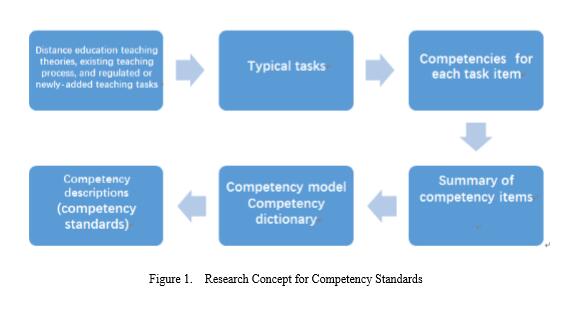
(II) Research methods
This research uses literature research, typical task analysis, group roundtable meetings, expert interviews, and several other research methods.
Firstly, literature research was conducted on the CNKI database using the key words “open universities” and “teaching competencies.” 1,358 relevant references were found. Analysis focused on documents from the last five years, leading to the following major research conclusions. Chen Li et al (2012) put forward four dimensions for the qualifications of tutors in distance education: society building and maintenance, learning guidance and facilitation, technology integration and support, and activity design and organisation. Li Shuang et al (2014)used questionnaires and interviews to conduct an in-depth investigation into the competency requirements for course tutors at Beijing Open University. They defined the core, key and auxiliary abilities of course tutors by evaluation the importance and relative time-consumption of different competencies. The actual competency level of on-the-job staff is also inspected through self-evaluation. Yang Sujuan et al (2009) argue that technology has become an implicit part of distance education and a required competency for distance education teachers. As far as distance education teachers are concerned, it is an orientation to further research into interaction competencies on how to strengthen interaction activity design, process management, and effect evaluation from the perspectives of competencies in technology, management and organisation, teaching design, and teaching evaluation. Zhang Shaogang et al (2013) looked at the three roles of teaching, management, and technology personnel and formulated the Standard Framework for Distance Education Practitioners starting from the core business of distance education. They divided the competencies of different kinds of personnel into specialised competencies and general competencies. Zhang Zhuo et al (2014) formulated a competency model for distance education teachers based on behavioural event interviews. The model includes five differentiation competencies and 22 threshold competencies. Of these, the three differentiation competencies of “team collaboration”, “communication and coordination ability”, and "organisation and management ability” make up the management dimension. Therefore, it is necessary to have strong skills in team collaboration, communication and coordination, and organisation and management in order to be an outstanding distance education teacher. It is clear that most research is focused on the competency framework, quality model or the role of an individual teachers’ teaching ability and that there is a lack of competency research based on the teaching operation mechanism and typical tasks of open universities and that there are no specific referable research results.
Next, during the analysis of typical tasks and the research and formulation of competency standards, the research group first worked out a discussion paper based on an analysis of distance teaching theories and related research, and the teaching and faculty management systems and tasks of outstanding teachers, and then brought together stakeholders for guided brainstorming, collective roundtable meetings, and workshops. From July 2015 to November 2016, the paper analysed 294 systems and documents on teaching management and faculty management from the OUC headquarters and its branches, schools, and study centres, and organised and analysed the typical teaching tasks that the teachers are required to complete. 170 outstanding OUC teachers, responsible people from the headquarters’ teaching and teaching management departments, representatives of the educational system, and faculty and teaching administrators were organised for collective discussions on typical teaching tasks and competency standards of teachers in open universities.
Finally, in December 2016, 33 experts from inside and outside the educational system were invited to discuss and revise the typical teaching tasks and competency standards of open universities by way of distance interviews and group discussions.
During the research process, typical tasks were revised six times, and 64 tasks across four aspects (teaching preparation, implementation, evaluation, and reflection and research) were adjusted to 46 items across three aspects (teaching preparation, implementation, and development). The competency standards were revised eight times and 64 items across the two dimensions of general and specialised abilities were adjusted to create 47 items across the three dimensions of attitude and value, specialised knowledge, and skills and abilities.
III. Typical teaching tasks of teachers in open universities
The typical teaching tasks in the research represent all of the teaching tasks undertaken by all of the teachers engaged in the teaching of majors and courses at open universities. They are not divided by role or position. The typical tasks of teachers in open universities are divided into three aspects — teaching preparation, implementation, and development — which are further subdivided into nine secondary tasks and 46 tertiary tasks.
Teaching preparation (see Table 1) refers to preparations made before offering open and distant degree education majors or implementing non-degree education projects, including prophaseargumentation, team building, the design of various schemes and proposals, and the construction of courses (teaching design, development of multi-media resources, online course construction, the building of teaching teams etc.). It is the preparation before organising and implementing teaching process for students.
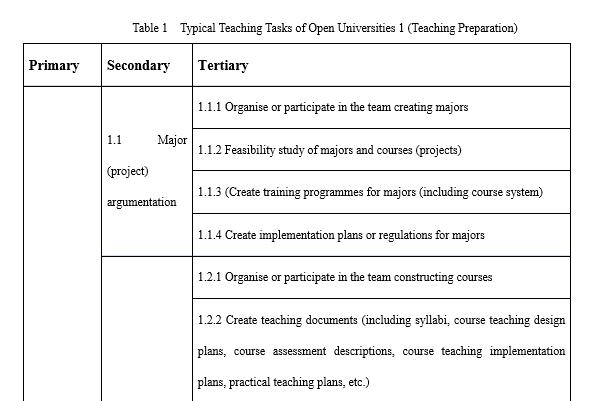

Teaching implementation (see Table 2) refers to all tasks that are part of the process of organising and implementing teaching for the students, including proficiency tests and entry-level education for new students, various course-based teaching activities, teaching tutorials, learner support, and learning evaluation, as well as the implementation, organisation, and evaluation of practical teaching at the major level, and teaching feedback and examination aimed at improving teaching quality.

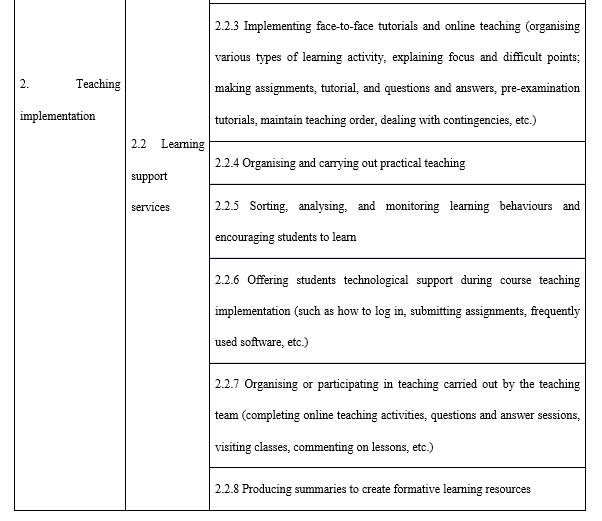
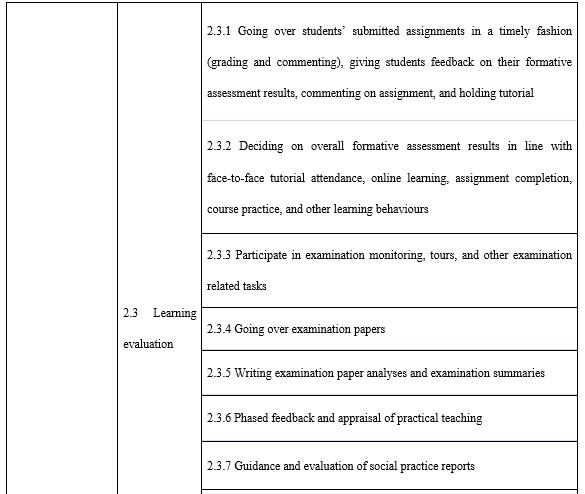
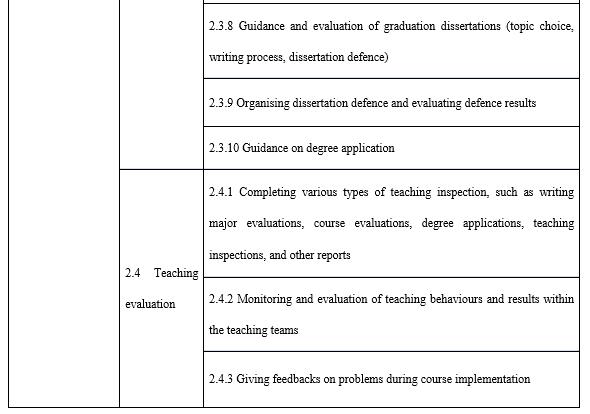
Teaching development (see Table 3) refers to tasks that teachers of open universities carry out or participate in in order to improve their teaching ability and level, including analysis of and reflection on teaching tasks, targeted teaching and academic research, and participation in teacher training and further education.
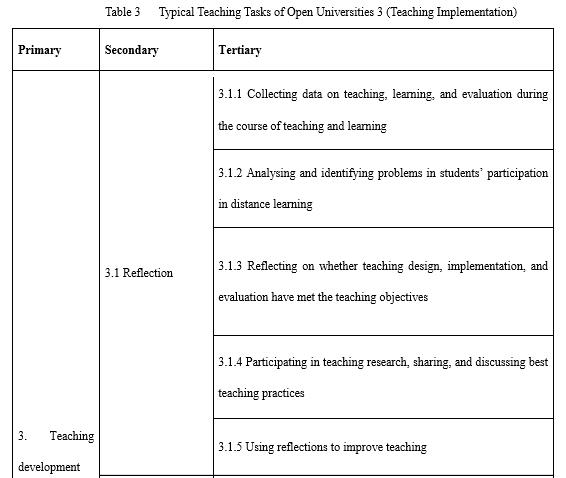
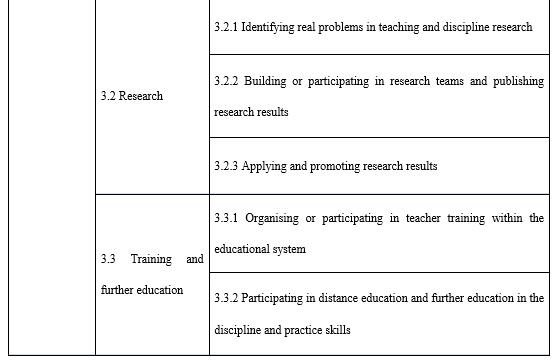
IV. Competency model for teachers in open universities
A competency refers to the specialised knowledge and special skills an individual or a group should possess in order to fulfil certain responsibilities, as well as external expressions such as enthusiasm, emotions, and attitude in completing the activities. It also covers the implicit knowledge and skills that will help the individual or group handle future challenges (Liu Yuan et el, 2001). As a profession, it is natural that teachers in open universities should have qualified competencies to do their job. The competency model in this research refers to the competency structure required for the professional positions assumed by open and distance education teachers in open universities.
The typical teaching tasks defined above form the basis for the research and development of a competency model and standards for teachers in open universities. In combination with the “iceberg model” and TPACK competency model for teachers in the field of human resources, all competencies necessary for teachers to finish each task are identified and combined for the purpose of analysis, adjustment, eliminating duplicates, merging, and classification. In this way, we obtain the competencies and competency model.
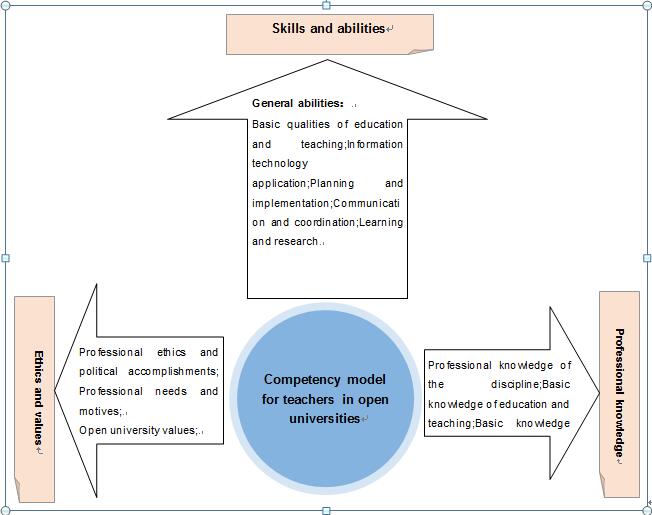
The competencies of teachers in open universities lie in three aspects (see Figure 2)
● Ethics and values: This refers to the basic ethics, attitude towards, and values of open and distance education, including basic professional ethics and political accomplishments, professional needs and motivation, and recognition of the core educational philosophy and school running values followed in open universities, and the necessary responsibility and enterprise.
● Professional knowledge: Teachers should have specialised knowledge of their discipline in order to teach their students and impart knowledge to them. They should have basic education and teaching knowledge to teach and impart knowledge, as well as knowledge of how open and distance education is different from traditional face-to-face campus education.
● Skills and abilities: These are the competencies necessary for teachers in open and distance education to teach, including general abilities and distance teaching abilities. General abilities refer to those necessary for various teaching roles in open universities. Distance teaching abilities are related to specific teaching tasks; they are the core skills and abilities necessary to complete professional tasks.
V. A teaching competency standard for teachers in open universities
Teaching competencies were summarised and researched from the perspective of five different aspects, “design ability”, “expression and interaction ability”, “organisation and implementation ability”, “teamwork”, and “innovation and teaching ability,” as well as ethics and values, professional knowledge and general abilities based on typical teaching tasks in open universities within the framework of competency model by learning from the competency dictionary in management. A total of 47 competency items necessary to complete the typical tasks were thus formulated. The 47 competency items make up the teaching competency dictionary for teachers in open universities.
(I) Ethics and values
Ethics and values (marked with A in competencies, totalling four items) include teachers’ professional ethics and political accomplishments, professional needs and motivation, their recognition of the values of open universities, as well as their responsibility and enterprise (see Table 4). It is necessary to pay special attention to the teachers’ level of identification with the cause of lifelong education cause and their awareness of adult learner support. The target audience of open universities is on-the-job learning adults, the educational orientation of open universities is lifelong education, and the education support open universities offer should meet the learning needs of learners and the needs of industries and enterprises for talents. Teachers at open universities are not only practitioners but also leaders and demonstrators of the concept of lifelong learning. At the same time, teachers are required to obey the ethics and norms of online exchanges in the web-based teaching mode, so as to create a civilised, harmonious, friendly, and positive online environment.
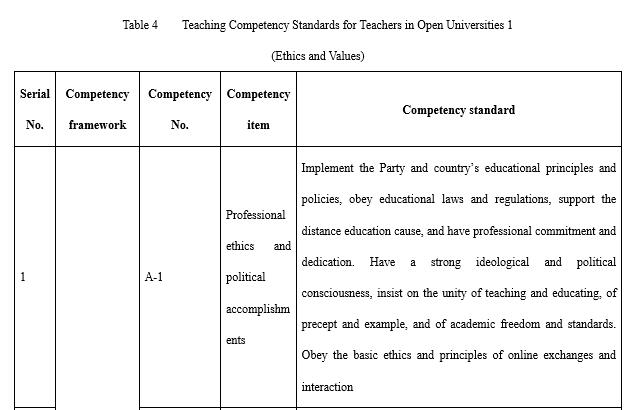
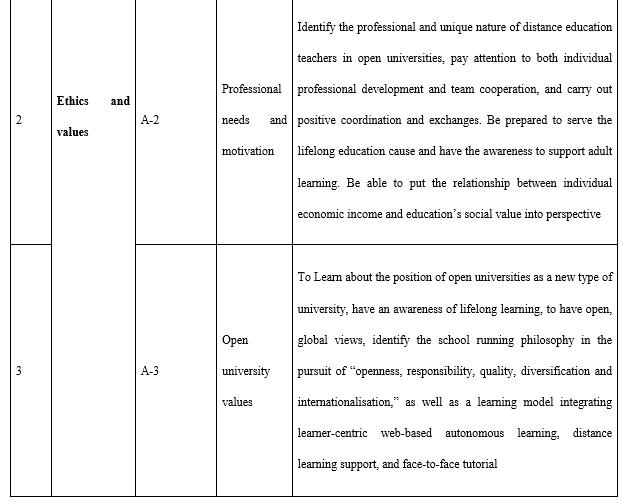
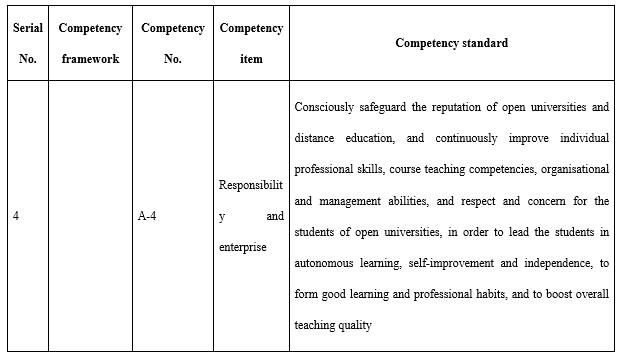
(II) Professional knowledge
Professional knowledge (marked with B in competencies, totalling three items) includes knowledge of and ability to apply a professional discipline, and basic knowledge of education and teaching in distance education (see Table 5). The training objective of open universities is to cultivate practical professionals and high quality labourers. Therefore, teachers don’t necessarily need top level research abilities but they do need to be able to keep up with new developments and have application and practical abilities. As a new type of university, there is a great difference between the teaching laws of the open and distance education offered by open universities and those of face-to-face campus education. To this end, teachers in open universities must have basic knowledge of open and distance education, in particular basic knowledge of adult learning characteristics, course development, learner support, online teaching, and the operation of the educational system.
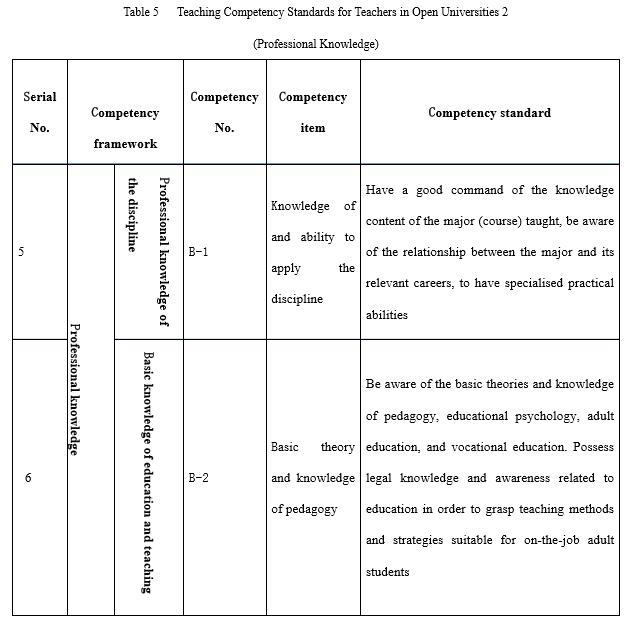
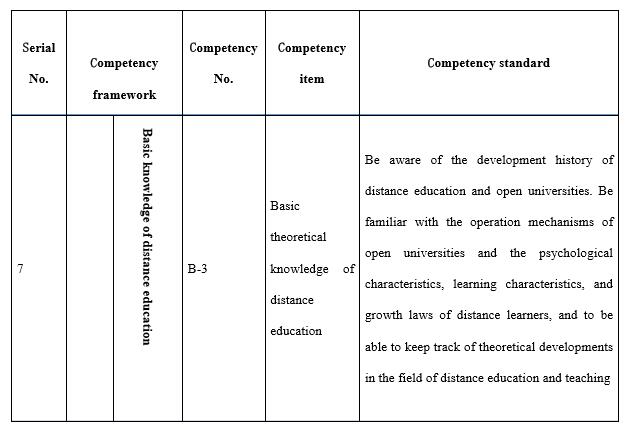
(III) Skills and abilities
1. General abilities
General abilities (marked with C in competencies, totalling five items) include the basic qualities of education and teaching, basic information technology abilities, learning and research abilities, programme implementation and monitoring abilities, and communication and coordination abilities (see Table 6). Based on the teaching operation mechanism and the relative level of separation between teachers and students in open universities, teaching tasks at open universities cannot be completely fulfilled by teachers from just one category. Teaching of one course is jointly carried out by teachers from various job positions through division of work and coordination. As such, teachers at open universities often play different roles. It has been mentioned above that teachers in this research are not subdivided according to their roles and that the competency standards represent a selection of all the competencies necessary for various kinds of teachers at open universities. Teachers with various roles need to have different capacities to finish different kinds of teaching tasks. Thus, general abilities are the basic skills and abilities required for all kinds of teachers at open universities.
There are two points to be explained here. The first is that “basic information technology abilities” refers to the ability to use common software that teachers of different education types must have in the information era. Furthermore, the ability to use information technology is essential for teachers in open universities that are supported by information technology. There are special competency items for this respect within the distance teaching ability. The second point that needs to be explained is the communication and coordination ability. Distance teaching tasks are completed with the mutual coordination of technicians, administrators, service providers, and various different teachers instead of by a single teacher. This is why the ability to communicate with different people and to collaborate with other teachers with the open university educational system is so important.
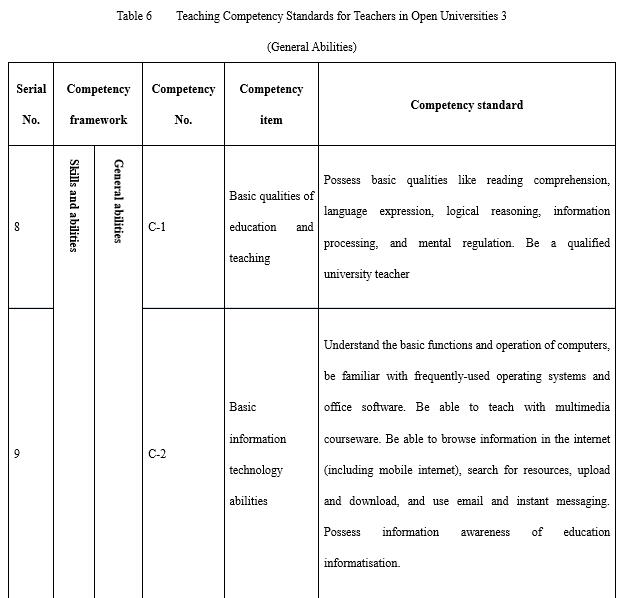


2. Distance teaching abilities
Distance teaching abilities (marked with D in competencies, totalling 36 items) include design ability (10 items), expression and interaction (four items), organisation and implementation (10 items), teamwork (three items), and innovation and teaching research (eight items).
With regards to the design ability (see Table 7) required by teachers in open universities, attention needs to be paid to three aspects in particular. The first is the correlation between the industry and market. This is where the need stems from and is also the starting point to meet said needs and offer distance teaching. The major source of funds for most open universities is tuition fees and consideration must be given to both economic return and social benefit when designing majors, programmes, and courses. The second is information technology and teaching media. During the design of all teaching implementation, course resources, and teaching activities consideration needs to be given to the reasonable and effective application of information technology and teaching media. The third is redesigning courses and programmes according to the actual organisation and implementation of teaching. All the teaching designs during the course of teaching preparation are made by open universities based on offering a major to all students throughout the country, whereas teaching implementation is targeted at specific students in a specific class. Thus, it is necessary for tutors to redesign the teaching process in line with the students’ knowledge, learning habits, and the actual teaching conditions.

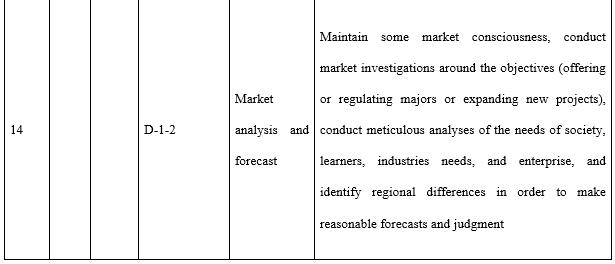
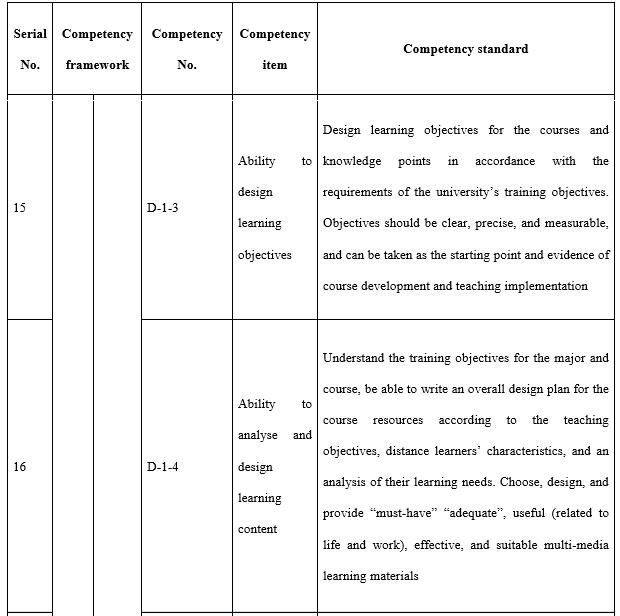
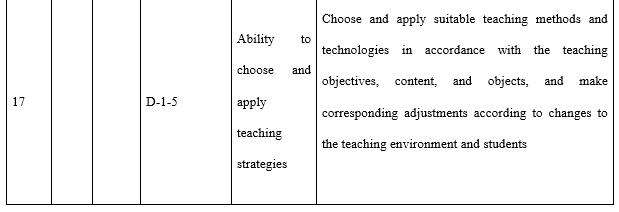
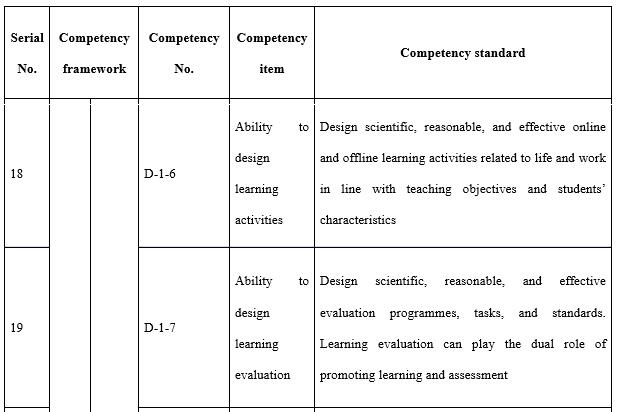
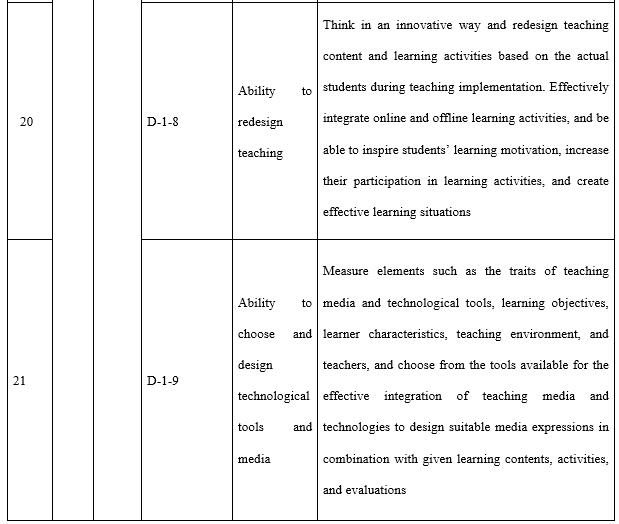
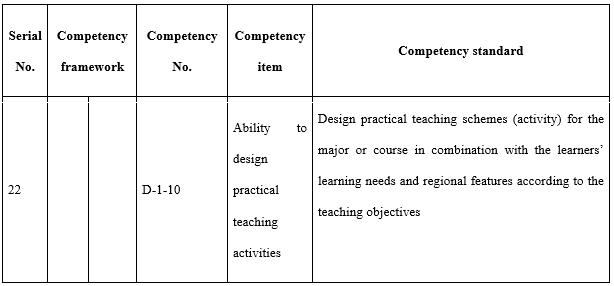
Teachers in open universities should be able to both express themselves and interact effectively (see Table 8) during course development and the teaching process. Online teaching is the main teaching method in open and distance education, and the ability to interact across this distance interaction is a peculiar skill necessary for teachers in open universities. The skills and strategies related to how to interact with the students online, for example listening, raising questions, and giving feedback, are key indices in judging outstanding distance education teachers. Printed materials, whether paper teaching materials or online texts, have to be written with warmth and with the language and tone of face-to-face communication.
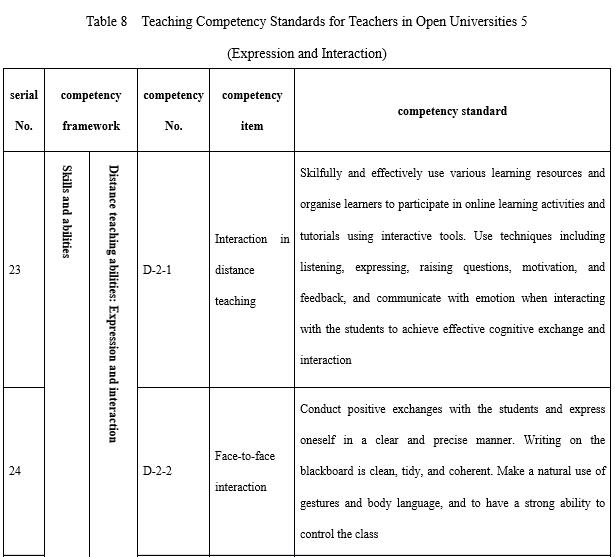
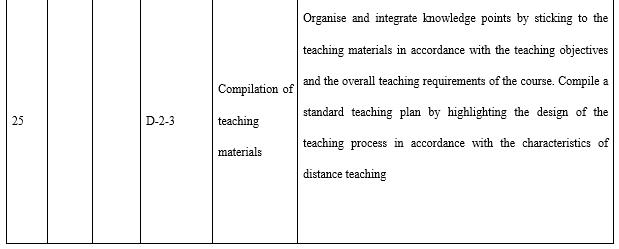
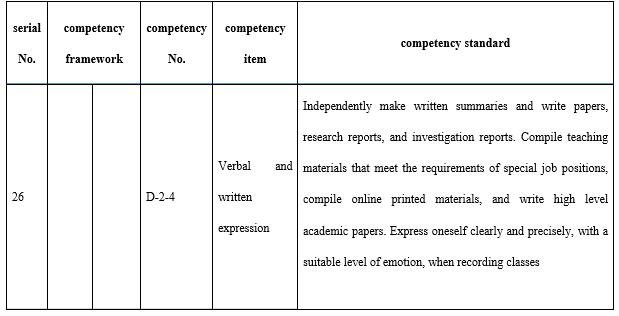
With regard to organisation and implementation (see Table 9), it is necessary to emphasise three points. The first is project management. Whether in terms of the construction of courses and resources or the construction and operation of the teaching teams, it is necessary for teachers to manage the project. A project management system is frequently used by the open universities to ensure quality, and the timely and economical completion of teaching tasks. The second is technology application. Whether it is a teaching platform or other information technology tools, teachers are required to be able to use appropriate technologies to pass on learning content and organise learning activities. The third is motivation, progress control, and process management and support for adult learners. Adults need to learn autonomously and the encouragement, guidance, feedback, regulation, and supervision of the teachers are crucial.

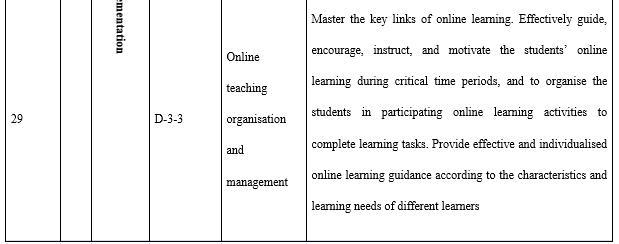

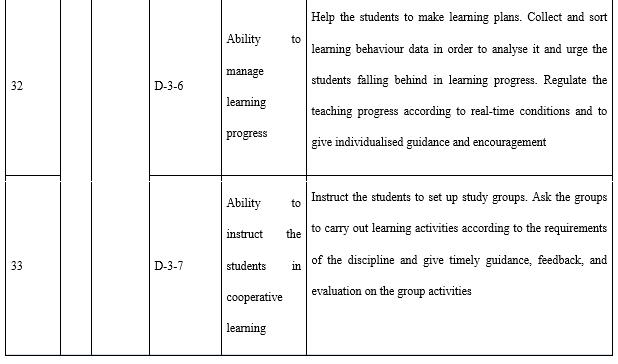
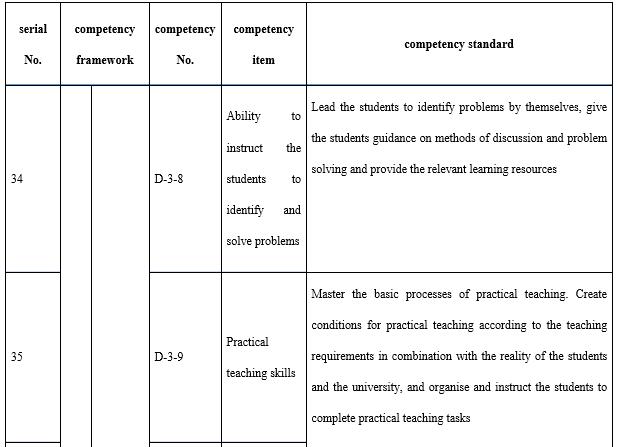
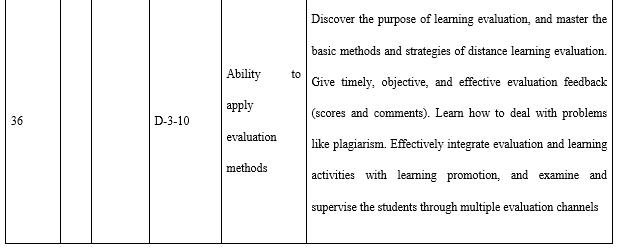
Teamwork (see Table 10) is of special importance to teachers in open universities. The design and development of majors, projects, and courses, and the organisation and implementation of the teaching process all rely on a team. There are core groups for teaching research at the major level, course groups for course construction, and course teaching teams for course teaching. The teams not only carry out teaching and but are also a major component of faculty development. The responsible staff on teams at the level of teaching in open universities are all teachers, including teachers with different roles and managers, technicians, service providers and researchers on the horizontal axis and the division of labour between teachers of different roles at different levels in the educational system on the vertical axis. Therefore, teachers must have the ability to cooperate to lead and develop teams.
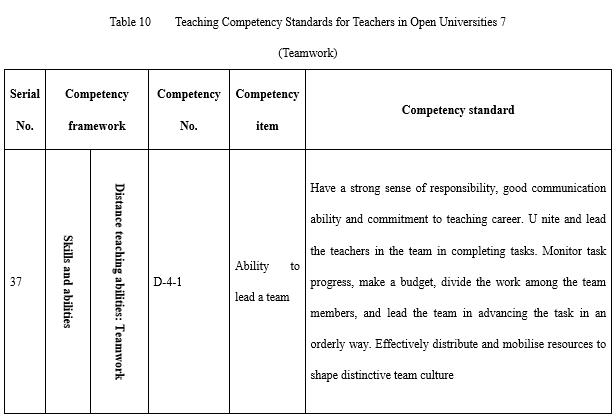
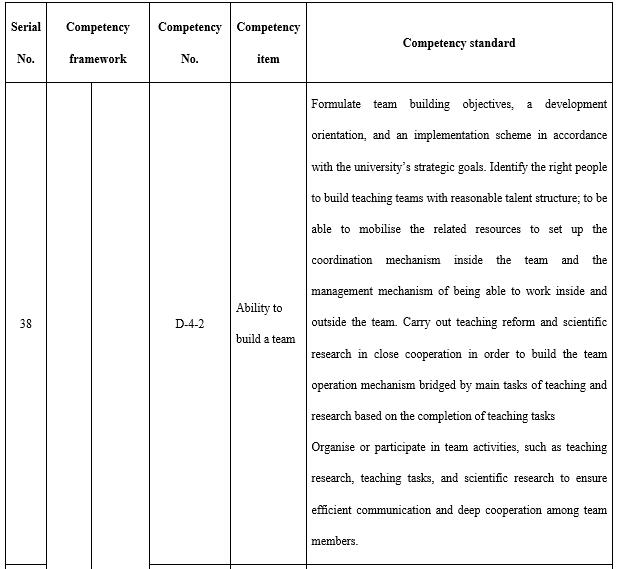
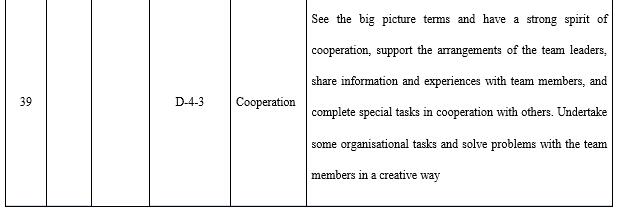
It is necessary for open universities to continuously explore and innovate. Even though open universities have technically been in existence in the form of radio and TV universities for 38 years (calculated based on the establishment of China Central Radio and Television University), they are constantly developing. The capacity for innovation and research (see Table 11) is a required competency for teachers in open universities to push forward teaching reform. Analysis of and research into student behaviours is not only the base for teaching design but also the base for the cause of open and distance education. This is especially true in terms of the exploration and cultivation of potential needs, which is of great value for open universities in providing education services oriented towards the market and the society. Teachers must be able to think systematically in order to solidly establish teaching. The tracking and innovative application of new technologies is also an inherent requirement for employed teachers. Teachers need to conduct teaching research, analyse teaching data, and reflect on the teaching process in order to improve teaching results and level; the ability to analyse teaching data is especially important. Behavioural data on teaching and learning will be generated and stored in the teaching platform during the process of online teaching, and excellent teachers will make use of this data to reform teaching. Whether in the course teaching team or throughout the entire system, teachers need to be able to effectively summarise teaching experience, solidify teaching results, absorb teaching reform experience, and employ teaching reform achievements.
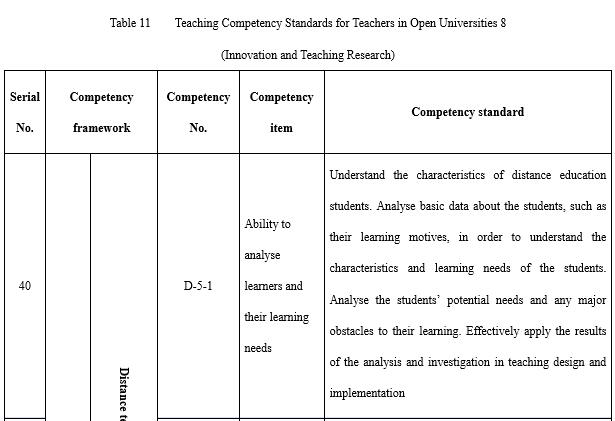
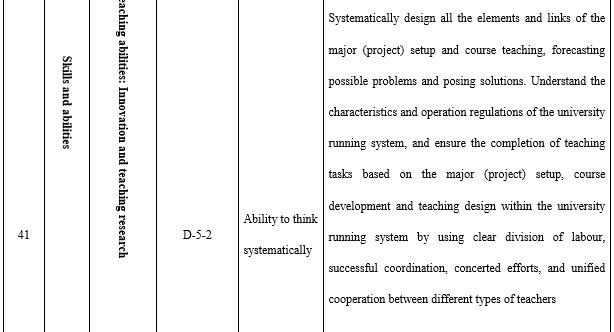
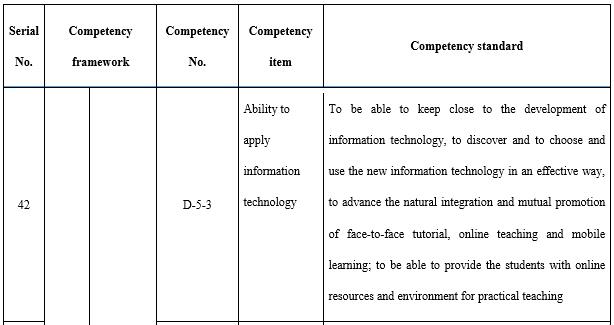

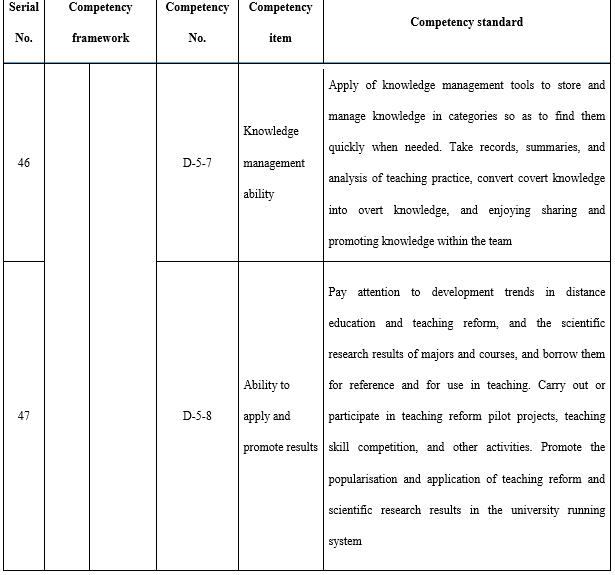
VI. Conclusion
This papers uses multiple research methods, including literature research, typical task analysis, group roundtable meetings, and expert interviews, to define 46 typical tasks in the three aspects of teaching preparation, teaching implementation, and teaching development. It then develops a competency model and competency dictionary for teachers in open universities through analysis of the competencies need to complete typical teaching tasks. It specifies forty-seven abilities in the competency standard of teachers in open universities from the three aspects of ethics and values, professional knowledge, and skills and abilities (including general abilities and distance teaching abilities). The teaching competency standard for teachers in open universities raised in this research can provide basis and reference for the university running system of open universities in their employment and introduction of teachers, teacher allocation and assessment and evaluation. It is able to promote the professional development and teaching ability improvement of teachers in the university system and provide fundamental basis for the teacher competency cultivation system made up of ability evaluation, ability certification, the cultivation of young and distinguished teachers, teacher training (including further study on course development), and others.
The disadvantage of this research is that the competency standard formulated is not yet equivalent to the teachers of various roles in open universities. However, the current school running system of open universities is in the process of reconstruction, and the reform of teaching mode and the operation mechanism inside the university system are still in exploration. There are also problems of “old city renovation” and “new city construction”, contradictions and challenges in faculty building. The issues are not defined as for the category and structure of teachers in the university running system, their responsibilities and divisions of labour, and allocation standard. They need to be further adjusted, defined and institutionalized. Our next focus of research is to formulate competency standard for teachers of various roles by building on this teaching competency standard. It is our expectation that the consistent researches on competency standard of teachers in open universities can promote the professional development of distance education teachers and serve the overall improvement of teaching quality of open universities.
Chen Li, Feng Xiaoying, et al. 2012.Study on Qualifications of the Role of Tutors in Online Learning Guidance [J]. China Educational Technology, (7):58-73.
Li Shuang, Zhang Yanxia, Liu Yongquan. 2014. A Survey on Tutors’ Competency Needs and Status in Beijing Open University [J]. China Educational Technology,(12):59-66.
Liu Xuan, Yang Sujuan. 2010. A Review of Research on Teacher Competencies in Distance Education[J]. Distance Education in China,(5):39-43.
Yang Sujuan, Liu Xuan. 2009. Research for Teachers' Competency Elements in Distance Education on the Basis of Grounded Theory [J].China Educational Technology, (11):34-38.
Zhang Shaogang, Wang Ying. 2013. Standard Framework for Distance Education Practitioners.
Zhang Zhuo, GaoJinjin, Chen Yiwen. 2014. Constructing and Testing A Competency Model of Teachers in Distance Education[J].Chinese Journal of Ergonomics,(3):47-50.
Exploration of VoiceThread Activity Design in Teaching Chinese as a Second Language
Jiang Zilu
Abstract:
VoiceThread is a web tool integrating multimedia and teaching content. In a web-based teaching environment, student and teacher-student interactions are often restricted by space and time. However, the VoiceThread tool enables more effective Chinese language teaching exchanges and interactions in a web-based environment. This article discusses how to design learning activities with VoiceThread within the context of three communication modes. The design principle is guided by the three modes of communication, targets 21st century skill standards and ACTFL skills, and is based on an interactive teaching method. This article presents categorised example activities for each communication mode, and discusses the skill standards involved in these kinds of activities the interactive strategies applied.
Key Words: VoiceThread, three language communication modes, teaching activity design, strategy
Traditional language teaching is inseparable from the learning of text, for they are the major channels of language learning. But now, the development of network media technology makes it possible for language teaching to be supported by other media. Learning can take place via video, audio, and multiple other dimensions. The different ways of learning not only enhances the learning outcomes, but also meets the various needs of learners and keep them attracted. Many teachers are also gradually introducing web tools to assist with language teaching, such as the websites that enable recording function . However, many of these tools only provide a single function (Holland, 2010). By contrast, students need not only multiple stimulations from image, audio and video, but also a platform that enable communication, cooperation, and interaction among their learning group. VoiceThread is such a software; it gathers multiple types of media, and involves students in learning topics through discussions, while at the same time establishing a good group learning environment.
I. What is VoiceThread?
VoiceThread can integrate text, picture, PPT, and video. Learners or teachers can add comments on the current page via microphone, telephone, camera, keyboard text, and doodling, which provide sufficient opportunities for online oral exercises and various asynchronous interactions. Meanwhile, teachers can also respond to students’ comments orally or through text. VoiceThread can be used on any browser or Apple mobile device.
There are both free and paid versions of VoiceThread, which can be subdivided into K-12, higher education, and business learner versions. The free account offers three free works and 75MB of storage space, as well as 30-minute of comments. Upgrading to a personal account costs only USD 79 per year, and includes fifty student accounts, with no other limitations on the number of VoiceThread works. In addition, users have the right to access and customise its own educational homepage. Teachers can create students’ accounts without their e-mail address, and divide different students into groups .
II. How to creat a VoiceThread?
As VoiceThread has different versions, this article only focus on the working procedures in personal account.
1. Account registration and creation

After logging into the account, click ‘Create’ to enter the editing interface where you can upload videos, pictures, and other learning resources. Because the uploaded PPT format may possibly contain displaced Pinyin tones, teachers are advised to convert PPT files into PDF format before uploading (Holland, 2010).
2. Add comments
Click the “+” icon just below the page to add comments by ways of text, video, telephone recording, or other files. When a comment is started, it will come up with a recording countdown box. If you are not satisfied with the results, you can re-do it. Once satisfied, just click “save.” It is worth noting that the brush tool works while recording or screen-printing. Once you select a coloured brush, you can write notes on your work page. Teachers can use this function to show key points while making explanations. Likewise, teachers can also incorporate this doodling functions in students’ learning activities in VoiceThread.
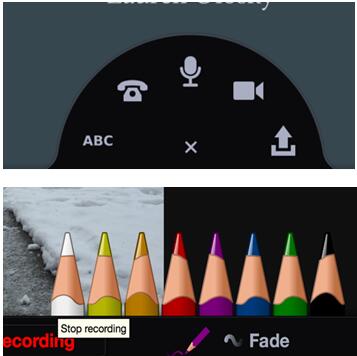
Student comments appear on the left side of the page, and can be deleted by editors. A private reply function exists for teacher-student and student-student interactions. Clicking the “lock” icon makes the comment a private reply; only the owner can see or hear the comment. Teachers can use this function to evaluate students’ oral comments and make suggestions for revision.
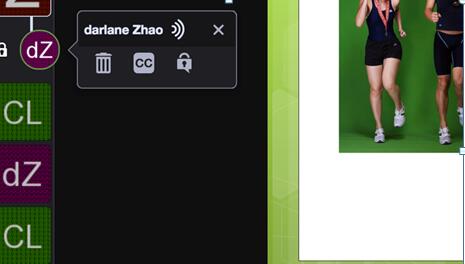
3. Shared links
After work is completed, it can be shared with students through links. Once students log into their accounts, they can make comments on VoiceThread. In addition, the work can also be embedded in students’ other online learning platforms, such as Moodle, Blackboard, and so on.

VoiceThread’s recording function helps auditory learners, the pictures and texts embedded may assist visual learners, and the Doodling function makes it more attractive for kinesthetic learners. The creation of a VoiceThread does not require advanced technology knowledge and skills. The clear instructional steps may reduce technological barriers to the network environment, and also make it easier to carry out teaching and learning activities.
III. Exploration of VoiceThread activity design for teaching Chinese as a second language
1. Design concept
The purpose of incorporating VoiceThread in language teaching is to provide a platform for students to do oral practices and communicate with their partners. In essence, it may help to improve students’ communication skills with second language.
(1) Guidance from thethree modes of language communication
Language communication is divided into three modes: interpersonal, interpretive, and presentational (ACTFL, 2003). The interpersonal mode emphasises two-way interpersonal communication. Learners receive “comprehensible input” first and apply it in information exchange through direct oral or written communication, which involves listening, speaking, reading and writing skills. The interpretive mode is a one-way communication that includes listening, viewing, or reading. Learners receive outside information and interpret it within spoken and written communication. The presentational mode focuses on speaking and writing skills, presenting through oral or written communication. The three language communication modes are highly related to teaching the following four language skills: listening, speaking, reading, and writing.
The three communication modes also provide guidance in the activity design and skills training in language activities. For example, teachers can design conversation activities, making comments, and information exchange in the interpersonal mode; Examples of the interpretive mode includes audio-visual comprehension exercise, cultural appreciation, text reading, and so on; the presentational activities can be delivered through story-telling, role play, making reports, writing news to the school newspaper, etc..
(2) Goal of skills standards
In 2011, the American Council on the Teaching of Foreign Languages (ACTFL) and Partnership for 21st Century Skills (P21) worked jointly to formulate a “21st Century Skill Map,” which put forward requirements for training language skills, and gave examples of relevant language proficiency. The 21st Century Skill Map explained the need to train for the “4C learning capacities”: communication, collaboration, creativity, and critical thinking. Effective “communication” requires learners express themselves clearly in spoken and written language and can use language to communicate with others, such as enquiring, instructing, and persuading, even in the multilingual environment. In terms of expression, learners go from short sentences to coherent, long sentences and paragraphs; they develop from sentence recitation to informative descriptions and recounting events with regard to the content expressed; the topics they discussed begin from the most simple and familiar daily topics to more complex ones that cover different fields . “Collaboration” requires that students have some ability to communicate in the first place, and have the capacity to fulfill their responsibilities to the team, so as to contribute toward the team reaching its common goal. Learners are required by “creativity” to approach a problem from multiple perspectives with originality, and bring new ideas to communication with others. “Critical thinking” means that learners can reason, analyse, and come up with substantive questions when understanding problems.
ACTFL Proficiency Guidelines describe tasks that can be completed by students at each language proficiency level, along with related content, contexts, accuracy, and types of talk (ACTFL, 2012). In the form of languages, novice learners mainly use expressions and separate sentences learned, intermediate learners use both independent sentences and a chain of sentences, though mainly at sentence level, and advanced learners can link sentences into paragraphs. Advanced learners are also able to use language in the past, present, and future tense, while intermediate learners mainly use present tense. In talking types, all learners have the basic ability to make descriptive introductions, recount events, express ideas, enquire, and reply. Advanced learners have more conversational skills. For instance, they are able to connect different viewpoints, use roundabout interpretations, and make illustrations. When designing VoiceThread learning activities, teachers can set the skill standards as the goal, integrating conversation types and tasks into different levels of learning activities in line with the requirements of each level. In this way, students will grow to use the correct words and sentence structures, increasing the level of their language expression through greater accuracy and consistency.
(3) Interactive teaching strategy
Chen Zhiquan (2003) used Chinese language teaching as an example to further explain and illustrate the interactive teaching strategy mentioned in the book “Design for Cooperative Interactions,” written by Robin Fogarty (1990). Chen outlined twelve interactive teaching strategies: 1) Lecture & Question;2) Survey; 3) Partner Activity; 4) Think Aloud, with one question and one answer; 5) Think-Pair-Share, wherein students exchange different viewpoints and improve their ability to express in arguments; 6) Tell/Retell; 7) Group Activity; 8) Observer Feedback; 9) People Search; 10) Wraparound; 11) Human Graph, wherein students discuss topics in groups, expressing and defining their own viewpoints; 12) Jigsaw. The interactive comprehensive teaching method highlights “learning-centre,” which not only follows all teachers’ guidance, but also enhances student participation as the main part of learning. He highlights language communication in different cultural context and emphasises “integrated skills.” According to Wang Xiaojun, “Only when integrated skills are improved can language ability be developed” (2005, p.109). The purpose of language learning is communication, and the use of multimedia communication tools like VoiceThread is all the more conducive to facilitate teacher-student and student-student interactions in the network environment. Through an interactive strategy, VoiceThread learning activities design should be oriented towards students’ integrated skills while focusing on language learning . It will be more natural to build language competency on the improvement of integrated communication skills.
2. Examples of VoiceThread activity design
According to the three modes of communication, the author also categories VoiceThread activity into three types: interpretative, interpersonal, and presentational. The following examples illustrate activities corresponding to each type, and introduce related skills training and interactive strategies.
(1) Interpretative
In interpretative activities, students understand, absorb, and internalise information mainly through listening and writing. They accept and understand language and culture in certain contexts. Activity examples are as follows:
a.Pinyin and new words teaching
Skill training: to understand and learn new words, and to practice pronunciation, etc.
Interactive strategy: Lecture & Question
Before class,teachers can provide online lectures for new learning content, and have students do pre-class exercises that help them prepare for class activities. Teachers can record lectures, and VoiceThread makes lecturing simpler. Thy only needs to upload a PPT, and add a recording to each page of the PPT. Even if there are errors in the recording, a second recording can be immediately made to save time in post-editing. At the same time, students can also make their own recordings while listening to the teacher’s, in order to better compare their pronunciation and answers to the exercises on the current PPT page. Furthermore, if the teacher uses video recording, students can see the teacher’s lip movement while they pronounce words.


b. Language structureexercises
Skills training: mastering correct language structure
Interactive strategy: Lecture & Question
Effective language communication can’t be achieved without appropriate language structure, which can be taught through direct/explicit communication (Zhang Ni, 2011). Teachers should make targeted language structure requirements . They can first explain language points and ask students to apply the language structure into sentences or context.


Draw and state where your home is located.
in the east of ……Draw and state where your home is located.
in the west of ……
in the south of ……
in the north of ……
My home is in the east of the U.S.
a. Viewing, listening,and speaking about culture
Skills training: language, culture, comparing and contrasting cultures
Interactive strategy: give feedback on information related to text, photo, or video content.
Please take notes while watching the video. Write down the difference between celebrating Spring Festival in the past and now. E.g.
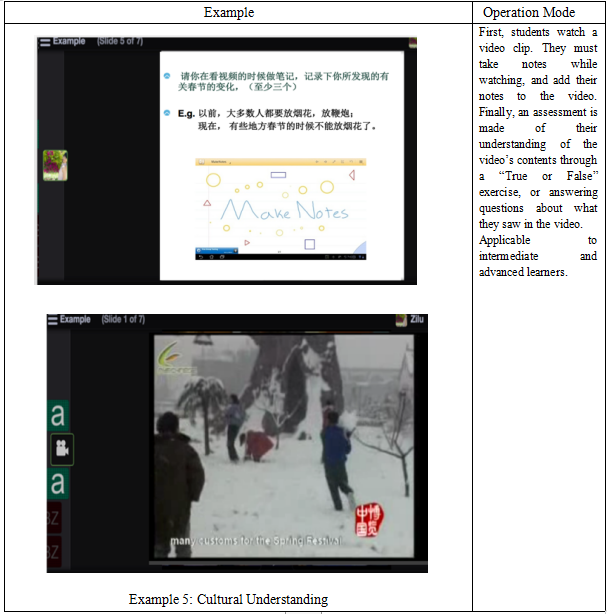
In the past, most people would set off fireworks and firecrackers.
Now, some people don’t set off fireworks during the Spring Festival.
In addition to comprehension exercises after the video content, other activity designs can be developed. For instance, to design a tourist route after watching several video clips on tourism; after watching a video clip on banning plastics, students may summarise the policies in the video and discuss whether environmental protection policies are practical in the context of local realities; to watch videos of a family reunion dinner on Chinese New Year’s Eve and learn the expressions for toasts; to watch videos of the Mid-Autumn Festival, and compare it with Thanksgiving Day, then discuss their similarities and differences.
(2) Interpersonal type
The interpersonal mode involves two-way communication aimed at mutual understanding. Students can make themselves understood in conversations, comments, exchanges of information, and opinion statements mainly by listening, speaking, reading, and writing. During the course of communication, they can collaborate to fulfill the same expression tasks, in addition to their assigned tasks. The author divides interpersonal activities into the following priorities: expressing views, discussion and comments, interviews, and role cooperation.
a. Expressing views and comments
Skills training: oral/written communication expressed in paragraphs, to state opinions and give examples
Interactive strategy: Think Aloud; Human Graph
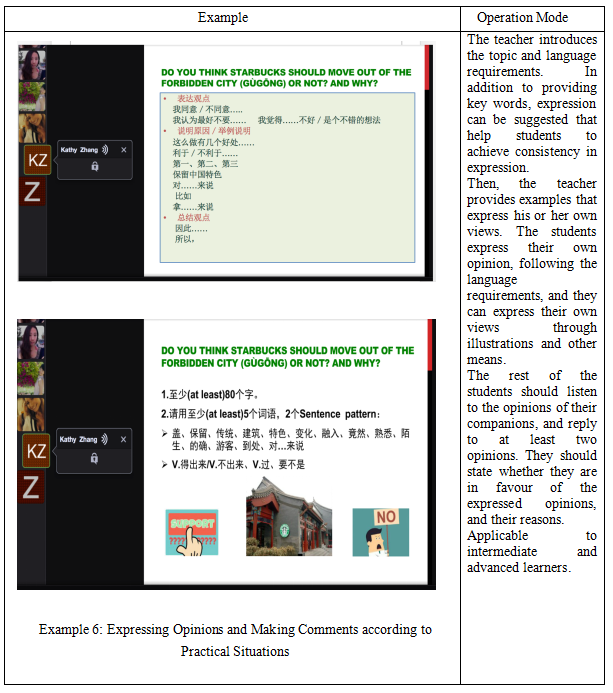
I agree/don’t agree……
I think it’s best not to……
I don’t think …….is good/ I think……is a good idea
illustration/example
There are several advantages to doing so……
It’s good/ It isn’t good
First, Second, Third
to retain Chinese characteristics
to……
for example
to take…… for example
summarise viewpoint
therefore……
so,
- At least 80 words.
- sentence pattern:
Please use at least five expressions and two sentence patterns:
build, remain, traditional, architecture, characteristics,change, integrate, to one’s surprise, familiar, strange, indeed, tourist, everywhere, to……
V. can tell by V. /V. can not tell by V. V. have had done sth.…,but for
b. Discussion and comparison
Skills training: oral/written communication in paragraphs; stating views; comparing and contrasting; Analysing the problem from multiple perspectives; exchanging new viewpoints; and getting informed by different perspectives.
Interactive strategy: Think Aloud; Human Graph; Think-Pair-Share
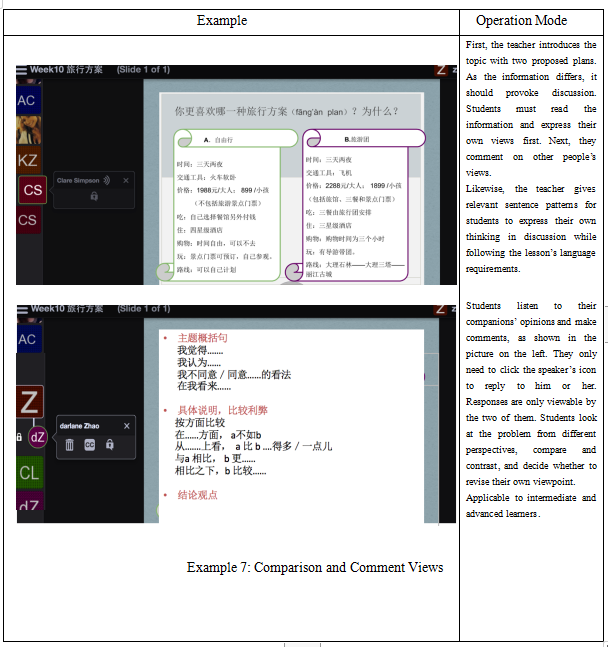
A. free travel
time: three days and two nights
transportation: soft train sleeper
cost: 1988 yuan/adult; 899 yuan/child
(excluding admission tickets at scenic spots)
food: free choice of restaurants on extra pay
accommodation: four-star hotels
shopping: optional
sightseeing: admission ticket reservation service available for self-guided visits
route: making plans on your own
B. tour group
time: three days and two nights
transportation: airplane
cost: 2288 yuan/adult; 1899 yuan/child
(including hotels, three meals and admission tickets)
food: three meals arranged by the travel group
accommodation: three-star hotels
shopping: about three hours
play: guided by tour guide
route: Shilin of Dali ---- Santa of Shilin ---- ancient Lijiang City
summary topic sentence
I think…
I think……
I don’t agree/agree with…
to me…….
details/advantages and disadvantages
to make a comparison in some aspect
in……a is not as good as b
With regard to …. .a is much/a little……than b
compared with a, b is more……
by comparison, b is more……
conclusion
C. Interview
Skills training: oral communication, description of steps, enquires and replies.
Interactive strategy: partner activity
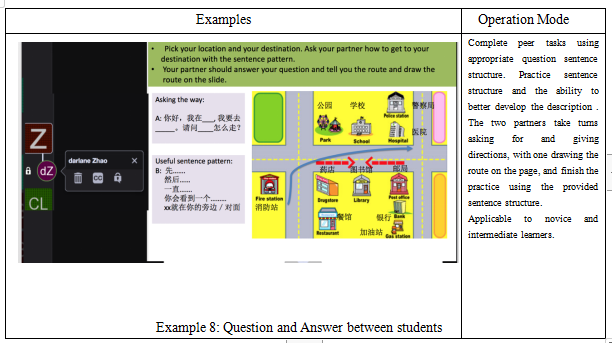
A: Hello. I am in , and I’m going to . Can you tell me how I can get to ?
B: First…
Then…
Go straight…
You will find a…
** is right beside/opposite you
d. Role cooperation
Skills training: oral/written expression ability using sentence groups; impromptu replies; using creativity to develop dialogue; using natural language to connect dialogues; and making information within dialogue clearer by applying suitable conversation skills, such as roundabout interpretation and additional inquiries.
Interactive strategy: group activity
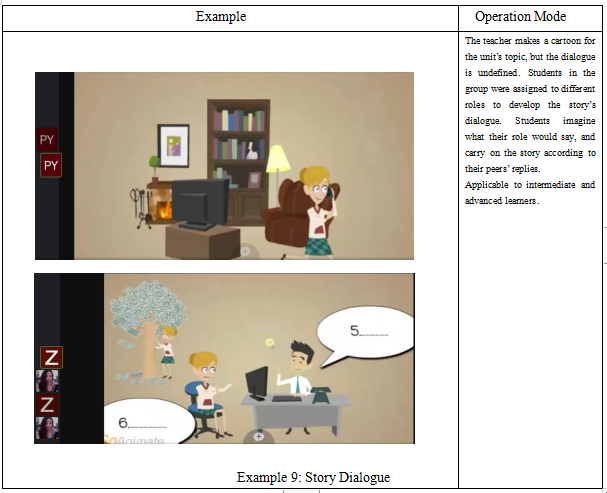
(3) Presentational type
The presentational mode emphasises speaking and writing abilities, and mainly focuses on expressing their own thought, describing events, and explaining things. It is a one-way presentation. Examples of these activities are as follows.
a. Story description
Skills training: oral/written expression using sentence groups; expression with paragraphs; using appropriate transitional connectives; and mastering different tenses.
Interactive strategy: group Activity; tell/retell
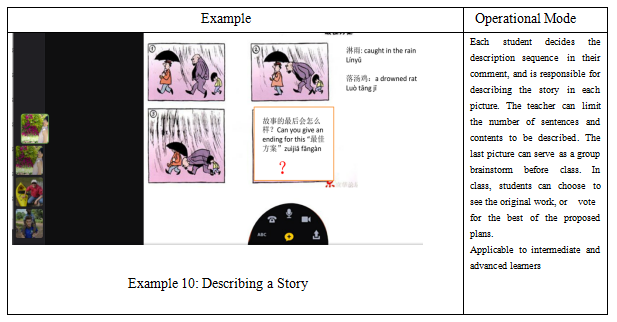
“the best plan”
b. Report
Skills training: oral/written expression using sentence groups; the ability to describe and introduce using paragraphs; using appropriate transitional connectives; mastering different tenses; comprehensively utilising knowledge and culture learned.
Interactive strategy: tell/retell
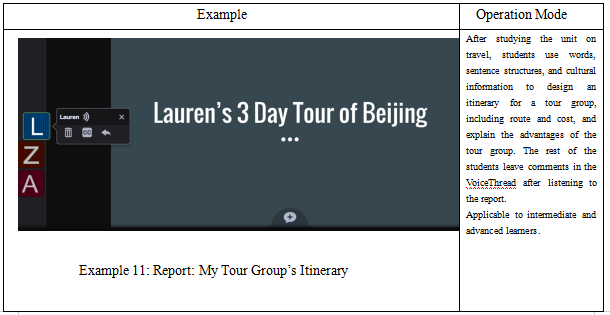
Skills training: oral/written expression using sentence groups; the ability to express using paragraphs; choosing appropriate connectives, sentence structure, and expressions to make expression more consistent; define topic sentences, and make statements clearer using logical words.
Interactive strategy: tell/retell

in…
in saving energy
in using new energy
in recycling rubbish
Driving a car wastes more energy than taking a bus.
Driving a car is rather a waste of energy.
Taking a bus doesn’t necessarily waste more energy than driving a car.
Compared with driving a car, taking a bus saves more energy.
Taking a bus more often than driving a car can save energy.
We should save as much energy as possible, for the energy of the earth is not inexhaustible.
Don’t
Do
may
must
must
should
be careful
Taking a bus is good to reduce emissions.
Taking a bus contributes to emissions reductions.
Littering is bad for the environment.
Littering is bad for environmental protection.
Littering will cause environmental pollution.
for example
take……for example
It’s everyone’s responsibility to protect the environment.
Environmental protection begins with me.
Environmental protection begins with small issues / trifles.
Because…….
not only……but also……
besides…, also…
besides,
both…and…
Although/Though…
Finally
also
save water; save electricity; litter
Taking a bus is environmental-friendly.
IV. Conclusion
The use of VoiceThread combines both teaching content and several kinds of media technology, diversifying interactions in Chinese language teaching in the web environment. The natural online interaction facilitate the activities for three modes of communication and its various function may meet the need of different learner styles. The article began with the introduction of three modes of communication, and then provided 12 teaching VoiceThread activity examples. It’s hoped that it can be used as a tool to develop students’ language ability through improving their communication ability. Examples given in this article are far from complete, and will be made more perfect in future.
ACTFL. (2012).|American Council on The Teaching of Foreign Languages.
Holland, J. (2010). Inspiring Active Learning with VoiceThread Technology. International Journal of Instructional Technology and Distance Learning, Volume 7 Number 4.
Zhang Ni. (2011) Use VocieThread to Improve Language Skills - Activity Design with Focus on Displaying the Learners' Abilities. pdf.
Journal of Technology and Chinese Language Teaching, 2 (1), 63 of Technology and Chinese Language Teaching/Apr_10.pdf/zhang.pdf
Wang Xiaojun.(2005). Interactive Teaching Strategy and Textbook Compilation.
Chen Zhiquan. (2003). Application of Interactive Teaching Strategy on Chinese Language Teaching. Journal of Chinese Language Education (1), 93
Fogarty, Robin. (1990). Designs for Cooperative Interactions.
About the author:
Ms. Jiang Zilu is a Chinese language instructor at the Chinese Language Centre of the Open University of China. She taught at the Confucius Institute of Michigan State University (CI-MSU) from 2013 to 2016. CI-MSU is the world's first online Confucius Institute, co-founded by the OUC and MSU in 2006. While at CI-MSU, Jiang undertook the work of Chinese language instruction, designing online courses for local high school students, as well as researching online flipped classes and language instruction. Jiang gained rich, first-hand experience in utilising educational technologies to support and enhance interactions in online teaching environments.
Learning Behaviours in Massive Private Online Courses and Their Influencing Factors¹:
Data from the Open University of China
Shi Lei, Cheng Gang, Li Chao, Wei Shunping
The Open University of China
Abstract: This study collects data from 54,228 distance learners enrolled in 57 Massive Private Online Courses (MPOCs) at the Open University of China (OUC) in the autumn term of 2015. Descriptive and correlation analyses were conducted based on more than 56 million learning behaviour logs created by these students during their online learning. Drawing further upon data from other sources, including tracking teaching processes, interviews with both staff and students, and the online learning status of OUC students as well as their interactivity with the courses , the study sets out to identify the features of student learning behaviours and the factors that influence them. The findings show that MPOC learners vary considerably in their engagement. Most students only care about assignments and texts that are directly related to course assessment and often rush through learning activities. In contrast, students of well-organised and well-supported courses tend to spend more time online and be more engaged. The findings also suggest that instruction from teachers and learner support effectively facilitate interpersonal and human-machine interaction in terms of assignment submission, test completion, and forum participation but negligibly increase the use of learning resources. Effective management mechanisms and adequate course design are also found to be influencing factors. The implications of these findings for the OUC are discussed in relation to course development, instruction and learner support, and management.
Keywords: Massive Private Online Courses; Massive Open Online Courses; learning behaviour; learning analytics; Open University of China; online courses
I. Introduction
With the increasingly wide use of MOOCs (Massive Open Online Courses), their shortcomings in terms of learner support, tutoring, teaching design, and teaching-learning interaction have become gradually apparent. In response to the limitations of MOOCs, MOOC-based DLMOOC (Deeper Learning MOOCs), SPOCs (Small Private Online Courses), MPOC s(Massive Private Online Courses), and other new teaching models have gradually come into being. Of them, MPOCs have become one of the leading formats among current distance educational and training institutions due to features such as private ownership, fee payment, class grouping, and matched tutoring teams, and their capacity to offer targeted teaching contents, organised teaching processes, and individualised learner support to online learners.
Since its beginning in 2013, the OUC has developed a number of MPOC courses that incorporate teaching support, learning, testing, and assessment based on the Moodle learning platform. There is a significant difference between MOOCs and the OUC online courses in terms of the students’ choice of courses, course development, teaching model, and learner support. Firstly, all the learners on the OUC online courses are students registered for degree education at the OUC. They are of a similar educational background and level, and the objectives of course teaching are compatible. Secondly, the OUC online courses are designed for OUC students, incorporating resources, learning activities, learning evaluation, and learner support. They are online degree education courses for effective completion of the entire process of learning, activities, and assessments. As far as the specific design is concerned, choices can be made on the types of activities, and methods and proportions of examinations according to the course characteristics. Thirdly, with regard to teaching and learner support, the OUC offers “multi-process, blended, and team-based” learning guidance, support, and promotion by relying on the teachers in its headquarters, branches, and branch schools. In other words, the teachers on the teaching team offer online and offline blended teaching; online teaching mainly represents the organisation and implementation of online teaching assessment, the completion of course assignments and tests based on online courses, and offline teaching mainly represents face-to-face tutorship and the final term examination, depending on the course. In the autumn term of 2015, there were a total of 57 courses, 169 classes, and 1,871 teaching groups on the OUC learning platform. Each class is divided according to each course offered in each branch and the teaching teams are divided according to the different learning centres for each class. A total of 54,228 students are involved in blended learning based on online courses.
This paper studies data from the online course behaviours of students of the Open University of China (OUC) in the autumn term of 2015. Analysis is made based on the characteristics of the online learning behaviour of OUC students, the students’ learning results, and the factors influencing them by collecting data on the students’ learning behaviours as recorded in the platform logs. The paper gives further explanations about the learning behaviours and offers relevant teaching and learner support suggestions in order to improve course teaching design, optimise the teaching process, and promote the teaching and learning of MPOC courses by tracking teaching processes and interviews with both teachers and students.
II. Literature Review
“Online learning behaviour” refers to a range of traceable activities recorded when using online learning platforms, including logging in, browsing, interaction, and retrieval. Compared to research materials such as self-administered questionnaires and interviews, these activities truly reflect the entire online learning process. As a result, great attention has been paid to them by researchers in the relevant fields. In the early 20th century, researchers tried to analyse learners’ online learning behaviours from the original Web access logs. In their research, Zaïane&Luo (2001) conducted an analysis of 420,000 original Web access logs and created generalised laws of the students’ behaviours, such as the most-visited modules and the obvious links between the visited modules. However, the mined information from the Web logs had its limitations. With the improvement of the online learning platform, more researchers began to consider how to obtain and analyse richer learning behaviour information from the structured background data. For example, researchers from Taiwan attempted to analyse the learning archives from structured courses in line with the SCORM norms (Su, et al., 2001). American scholars Hung and Zhang (2008) tried capturing behaviour log information from the LMS’ backstage data base, classified the students’ characteristics, and summarised their daily learning behaviour modes. Most of the analyses of learning behaviours in this period fall into the category of small sample research of a small number of courses and classes. Research on massive online courses with larger sample sizes was rather rare.
After the year 2012, educational research institutions in China and abroad began to turn to the field of massive open online courses (MOOCs). Overseas research includes analyses and forecasts of MOOC learners’ behaviour characteristics, interactions, and course completion rate, and course development improvement, teaching process intervention, and other aspects in accordance with the learners’ behavioural characteristics. In particular, foreign universities including Harvard and MIT have collected and analysed course behaviours from platforms such as Coursera and edX. Chinese research is mainly focused on online learning engagement, learning behaviour analysis and achievement forecasting, learner classification, and exploration of online learning models. For example, Li Shuang and others put forward six dimensions for a learning engagement analysis framework;Jia Ji and others conducted a comparative study on approximately twenty data indexes of the Peking University courses offered on Coursera, and they indicated a positive correlation between learners’ achievements and the time they spent online, the frequency with which they watched videos, and browsed and downloaded resources, and their forum participation;Zheng Qinhua et al (2016) conducted an overall analysis of 14 mainstream Chinese MOOC platforms and pointed out the current problems with MOOCs, such as the single teaching mode, delayed learner support and tutorials, unsatisfactory interaction, deep learning deficiency, and low learning quality and completion;Ma Xiulin et al (2016) conducted empirical studies on the teaching effects of MOOCs and SPOCs, and indicated that SPOCs were superior to MOOCs with regards to resource construction and customised support. Guo Wenge et al (2015) put forward design and operation methods for MPOCs, and indicated that it was highly probable that MPOCs would represent a future development trend for MOOCs. Wei Shunping (2012) conducted a learning behaviour analysis of one of the OUC’s MPOCs in an attempt to discover more learning behaviour characteristics from the perspectives of learning time, learning activities, teacher-student interaction, learning resources, and test results.
Based on the above research, this paper focuses on an analysis of learning behaviour in the MPOC teaching model. It studies learning behaviours from more than 56 million data instances at the OUC in the autumn term of 2015 in the hope of identifying new features and the factors influencing MPOC learning behaviours through interdisciplinary and trans-regional data analysis. The aim is to provide evidence for all educational institutions to optimise the design of MPOCs, improve teaching implementation, and upgrade the teaching level.
III. Research Design
(i) Research sample
Based on the previous research on the evaluation of online learning behaviour, learning performance model of online courses, and data model of learning analyses, and drawn upon the original data from the learning platform logs in the 2015 autumn term of the Open University of China, data are collected and extracted from course information, student information, teacher information, learning process behaviour and teaching process behaviour etc. Of these, the behaviour data related to learning process were classified according to the students’ learning actions and categories mainly completed online. There are 14 data items across seven categories, including online learning time, frequency of various behaviours, resource utilisation, forum posting, assignments completed, tests completed, and online learning results. The behaviour data for the teachers is mainly collected from three major online teaching behaviours — online tutorial engagement, tutorial methods, and course development — and includes 14 data items in six categories: frequency of various behaviours, online teaching time, forum posting, assignments assessed, internal memos, and course resource renewal. These data items are based on the online course resource category, learning tasks to be completed, and major teaching and support services, including principal learning behaviours of learners’ online learning, learning process and teachers’ principal teaching and tutorial behaviours. Table 1 includes the data items and their specific descriptions. Over the course of data arrangement and collection, incomplete and abnormal behaviour data logs are excluded.

(ii) Research methods
Using applied data statistics and visualisation, cluster analysis, correlation analysis, association rules, and other data analysis and mining techniques, the learning behaviour data from the OUC 2015 autumn term was analysed in order to understand the online learning behaviours apparent in the OUC’s online courses, to mine the relations between and among the behaviour data, and to establish the factors influencing students’ learning behaviours in the OUC’s MPOCs.
An understanding of course development and teaching was gained by tracking the course teaching process. Further analyses of the teaching process were made in order to mine learning behaviour features and to improve course design in combination with quantitative analysis.
A number of tutors and students were interviewed in order to supplement and revise the research results. Explanations of some of the learning behaviours were made by integrating actual teaching experience and practice, and relevant suggestions for instruction and learner support were made.
IV. Research Process and Discussion
(i) Features of students’ online learning behaviour
1. The distribution of time spent learning online
Figure 1 is a tendency chart of the days the students spent learning online based on the learning behaviours recorded on the learning platform in the 2015 autumn term. It can be seen that most students learned online for just one day and that only 14 students learned online for more than 40 days. Among the students, the maximum number of online learning days is 59 days. Based on the number of weeks offered for each course (each course is offered over approximately 10 weeks, excluding examination week), the students clearly spend fewer days on online learning, and many of them spend one day or several days on completing the items for their achievements, such as assignments and scored tests. Only a few students maintained long-term online learning. Though much attention has been paid to the rich learning resources and learning activity design of the OUC’s online core courses, in practice the overall online utilisation rate of MPOCs doesn’t make a big difference to the overall online utilisation rate compared with that of MOOCs if there is no follow-up teaching organisation or complete support service system. Students don’t necessarily conscientiously insist on learning through online network courses just because they are formally registered and have paid for admission.
 Figure 1 Tendency Chart of Students’ Days Spent Learning Online
Figure 1 Tendency Chart of Students’ Days Spent Learning Online
2. Comparative analysis of various learning behaviours
The behaviours of the students are of significance in understanding their learning features. The students’ preferences are identified through an analysis of their various behaviours in order to provide evidence for course design and teaching implementation. Figure 2 is a comparison chart of the mean value of four categories of different behaviours (the average value of the behaviours is the average of all the students’ clicks on each course) from the 57 courses on the learning platform for the OUC’s 2015 autumn term. It can be seen that the rarest behaviour is resource browsing, followed by behaviours related to interpersonal interaction. The best click rates are found among other categories of behaviours such as course entries, navigation, and results queries.
 Figure 2 Comparative Chart of the Average Value of Various Behaviours
Figure 2 Comparative Chart of the Average Value of Various Behaviours
Note: ①The horizontal and vertical coordinates represent course codes and clicks, respectively
To be more specific, scored assignments and tests get the most clicks. Figure 3 and Figure 4 are examples of one public compulsory course and one special core course, respectively. The Figures show the most clicks on the courses’ top ten items. The Figures demonstrate that the interpersonal interaction and human-machine categories of behaviours account for most of the clicks; the top four ranking items are almost all formative assessments (namely assignments), it is the similar case with most of the other courses.
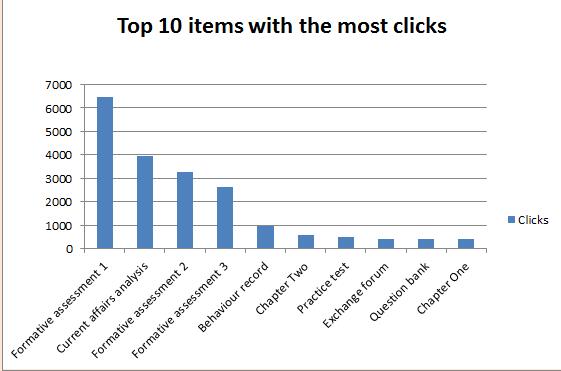 Figure 3 Clicks on Items within OUC Course A
Figure 3 Clicks on Items within OUC Course A
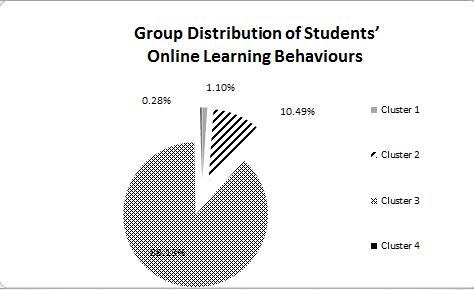 Figure 4 Clicks on Items Within OUC Course B
Figure 4 Clicks on Items Within OUC Course B
By integrating course practical teaching and interviews with teachers and students, we established that most online courses have few activities in the interpersonal interaction category, such as assignments and forums, and that the design of course navigation and learning pathways is complicated. With regards to single course items, assignments receive the most clicks, but the overall clicks are less prominent. Furthermore, unclear course learning pathways also lead to repeated clicks of navigation items, which adds to the number of clicks on other categories of behaviour interactions. In the meantime, since degree education students won’t receive a score unless they complete their assignments and tests, they pay more attention to the tests and assignments which can help them obtain scores and less attention to items such as resource browsing.
3. Group distribution of students’ learning behaviours
K-means clustering analysis is used to analyse the students’ online behaviours and their days spent learning online, as shown in Table 2 and Figure 5. Excluding individual numerical outliers, the students’ online learning group is divided into four categories. As seen from Table 2, the total sum of learning behaviours positively correlates with an increase in online days, and Cluster 4 has the most online learning days and behaviours. If the class time is calculated according to 10 weeks in a term, the average length of online learning is 1.5 times a week, and there are 137 different learning behaviours each time. The students with a large number of learning behaviours account for only a small proportion, merely 0.28%. The days spent learning online for Cluster 1 is similar to those of Cluster 4, but the total learning behaviours are less than half of that of Cluster 4; the days spent learning online for Cluster 2 are slightly fewer than those of Cluster 1, and its total learning behaviours are about one third those of Cluster 1; the online learning days and learning behaviours of Cluster 3 are obviously decreasing, and its learning days are about one third of Cluster 2 and its learning behaviours only one fifth of Cluster 2. Figure 5 is a group distribution map of the online course students’ number of days spent learning online and their learning behaviours. The students with one log in or above in an average week account for less than 12% and most of the students log on to learn once in three weeks with an average of three learning behaviours.
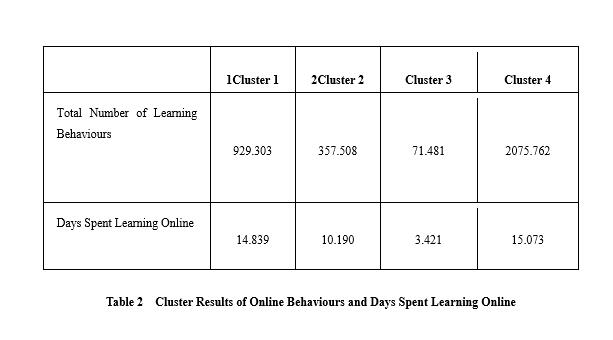
 Figure 5 Group Distribution of Online Learning Behaviours
Figure 5 Group Distribution of Online Learning Behaviours
Further analysis of the cluster results demonstrates that that the 57 courses of the other three clusters are distributed at random, with the exception of Cluster 4, whose students are all participating in the “OUC Online Teaching Team Pilot Course”. These courses have their own features. In terms of construction, the teaching team includes course leaders, tutors, class tutors, administrators, and technicians. There is an online duty roster, so that the teachers can answer questions raised by the students. In terms of teaching implementation, the role of the team members is to offer students timely tutorials and facilitate their learning. The class tutors, in particular, keep tracking the students’ online learning. They get regular notifications about assignment completion and take initiative to contact students in order to urge them to learn online and to submit assignments.
4. Course interaction
Figures 6 and 8 are descriptive schemes of the relationship between students’ human-machine interactions (tests) and interpersonal interactions (assignments and forum posts) as part of the courses. It can be seen that neither test completion, assignment submission nor forum posts are very satisfactory. The highest test completion rate and assignment submission rate for the courses is still less than 20%. The mean value of forum posts for many courses is 0-1, indicating that some students on the courses do not post any forum posts.
Excluding the 19 courses with no assignment design, the highest assignment submission rate among the rest of the 57 courses is 80.11%. There are nine courses with an assignment submission rate of 50%, accounting for 23.7% of the total. Excluding the six courses with no test design, there are 10 courses with a test completion rate of 50%, accounting for 19.6% of the total. 21.47 posts on the students’ forum represents the highest average number of posts; there are nine courses with an average of five posts by students.
By tracking the teaching activities of several courses with good human-machine and interpersonal interaction, and holding interviews with tutors and students, it can be seen that these courses are successful in both course design and the implementation of the teaching process. For example, some courses are provided with sufficient teaching staff , and some courses are included in the “OUC Online Teaching Team Pilot” project. The students are guaranteed effective and timely tutorial and learner support. Some courses are designed concisely and clearly, and the original flow layouts of the platform are generally maintained, which are well received by the tutors and students. Neither teachers nor students will get lost in the process of teaching and learning. For example, the flow layout is used in the OUC course Organisational Behaviour, and all the resources and activities are presented on the home page. There are no other designs except for learning content on the course page. It is very convenient for tutors to organise teaching or to add resources. Furthermore, it is easy for students to find what they need to learn effectively. Therefore, it ranks on top both in terms of the completion rate for assignments and tests and in terms of forum posts. It is easy to operate and the teachers and students praised its availability in the interviews.
From further observation of the course entries, it is found that downloads are offered for scored tests and assignments to make it easy for the students to finish assignments. The students can download and complete the assignments and scored tests offline. This is a common practice among students in many branches, especially those in less developed areas. Meanwhile, most of the classes have established QQ and WeChat groups, with which to conduct real-time and non real-time interactions. This leads to low forum use rates, accounting for the low levels of human-machine and interpersonal interaction on the platform.
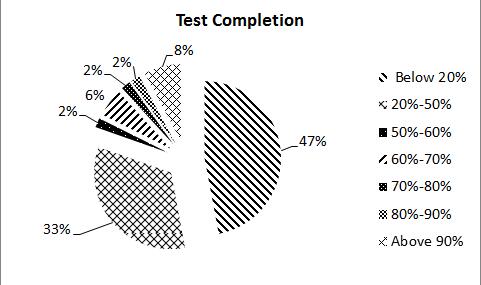
Figure 6 Distribution Map of Test Completion Rates
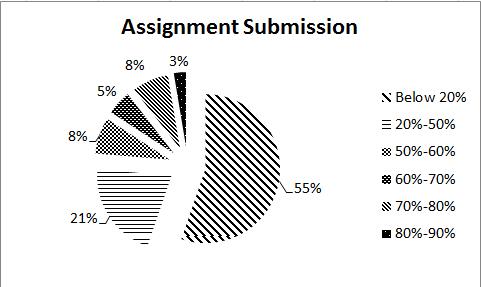
Figure 7 Distribution Map of Assignment Submission Rates
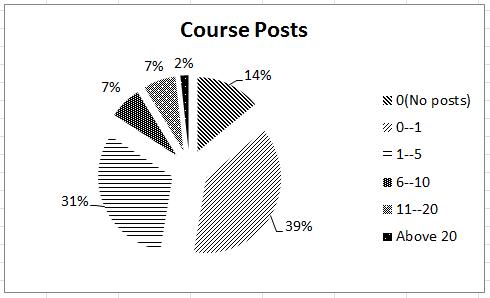
Figure 8 Distribution Map of Students’ Course Posts
(II) Analysis of the factors influencing learning behaviours
A comparative analysis of the students’ online learning behaviours from the course teaching team, teachers’ individual teaching behaviour, course operation area, teaching class size, specialty category, and course design was conducted. It can be seen that the teaching team and operation area have a clear influence on the students’ learning behaviours, the course design has a certain influence, and the type pf major and teaching scale do not exert an obvious influence.
1. The influence of the teaching team on learning behaviours
Of the 57 courses in operation on the OUC learning platform, seven are included in the “OUC Online Teaching Team Pilot” project (hereafter referred to as the “pilot courses”). Compared to the other 50 courses (hereafter referred to as the “non-pilot courses”), all the pilot courses are taught online with the support of funding and mechanisms. Specific team responsibilities and job assessment methods are created, and complete teaching teams made up of course leaders, tutors, class tutors, administrators, and technicians are organised in order to provide the students with all-round academic and non-academic support, including course guidance, distance or face-to-face teaching, assignment revision, and questions and answers, as well as assignment reminders, teaching affairs management, technical assistance, and consultation etc.
Figure 9 is a comparison chart of the average value of all the learning behaviour data for the pilot and non-pilot courses (the average value is the sum of the data items of each course divided by the total number of courses). It can be seen that the average value of each item for the seven pilot courses is higher than those of the non-pilot courses. Of these, the gap is greatest between the process learning behaviour data, such as the total sum of learning behaviours, the interpersonal interaction category of behaviours, other categories of behaviours, days spent learning online, resource use, activity use, students’ forum posts, tests completed, and test completion rate. The average values of the rest of the items are slightly higher; and the average values of assignments submitted, interactive assessment assignments completed, and assignments assessed by others are all very low (insufficient assignments designed for the course largely result in such situation, in particular the deficiency of assignments that require interactions and assessments) . In the course online achievements, the gap between the average values of the two kinds of courses is about 17.
Note: ① The average value is the sum of the data items of each course divided by the total number of courses. ② In order to be more intuitive, a comparison of the assignment submission percentage and test completion percentage was added.
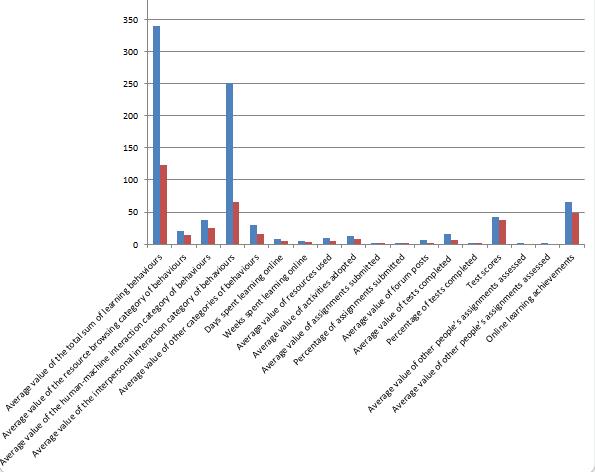
Figure 9 Comparison Chart of the Average Data Values from the Seven Team-Based Courses and the Remaining 50 Courses
2. The influence of teachers’ individual teaching behaviours over learning behaviours
An analysis of data item correlation was conducted in order to understand the relevance and influence of various kinds of behaviour data. The influence of teaching behaviour over students’ learning can be seen from the correlation analysis of the behaviour data of teachers and students. Since the learning and interaction for the pilot courses are completed online, the seven teaching classes of the seven pilot courses (the pilot courses are offered only in designated branches with one teaching class per course) are used as the sample, in order to obtain a Pearson correlation analysis of the average value of the students’ behaviour data and that of the teachers’ teaching behaviour data. Table 3 shows the items that demonstrate extremely strong or strong correlative data.
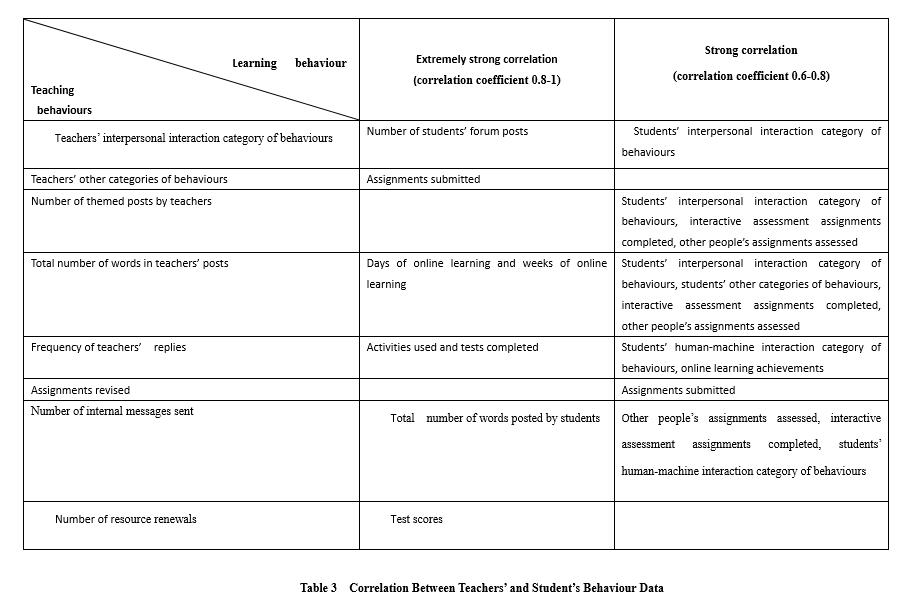
The correlation analysis of Table 3 demonstrates the following:
➢ The teachers’ interpersonal interaction category of behaviours promotes interpersonal interaction between the students and improves the students’ rate of forum participation.
➢ Teachers provide learning support to the students and improve the assignment submission rate based on other categories of behaviours such as reading through the students learning behaviour data.
➢ Correcting assignments has a significant influence on the number of assignments submitted.
➢ When teachers post in the forum it encourages interpersonal interaction between the students and promotes the involvement in interactive assessments of assignments. Forum posts by teachers greatly encourage the students to study online for longer periods of time.
➢ Improving the teachers’ reply rate also improves the test completion rate and activity use rate, as well as the students’ online learning achievements.
➢ An increased rate of internal messages boosts interpersonal interaction between the students, including the number of words posted, and interaction with assignments and evaluations;
➢ The frequency of resource renewal correlates extremely strongly with the students’ test scores.
According to the above correlation analysis, other categories of teacher behaviours such as assignment revision and reading through the students’ learning behaviour data and learning logs have a clear utility in encouraging the students to submit assignments. Forum posts and internal memos can mobilise the students to participate in interactive assessment assignments and peer evaluation, and improve the students enthusiasm for interpersonal interaction. The frequency of replies and resource renewals influence the test category of activities and test scores, and the frequency of replies is strongly related to the students’ online achievements. Learning guidance and learning promotion behaviours effectively facilitate the students’ completion of assignments and willingness to post on the forum, and play an outstanding role in encouraging interpersonal and human-machine interactions and improving the activity completion rate. However, their role in encouraging the students to increase their browsing resource is not effective.
3. The influence of the course operation area on learning behaviours
According to an analysis of students’ learning behaviours in the course operation branches, the data from students in Chengdu and the Corps are the best. Table 4 intercepts part of the significant test results of the mean value of students’ learning behaviours for one course. It can be seen that most of the data items from Chengdu and the Corps branches are much higher than the average number and are higher than those of the other branches. Analysis of courses operated in the other areas shows the similarstatus. Further analysis and interviews show that Chengdu and the Corps branches pay great attention to online teaching and have created related teaching policies and assessment systems to promote online teaching and to increase the enthusiasm of both the teachers and learners. The smooth implementation of online teaching is ensured through training and teaching supervision in order to guarantee the quality of online teaching. We can see that the relevant policy support, systems, and faculty guarantees have an impact on learning.
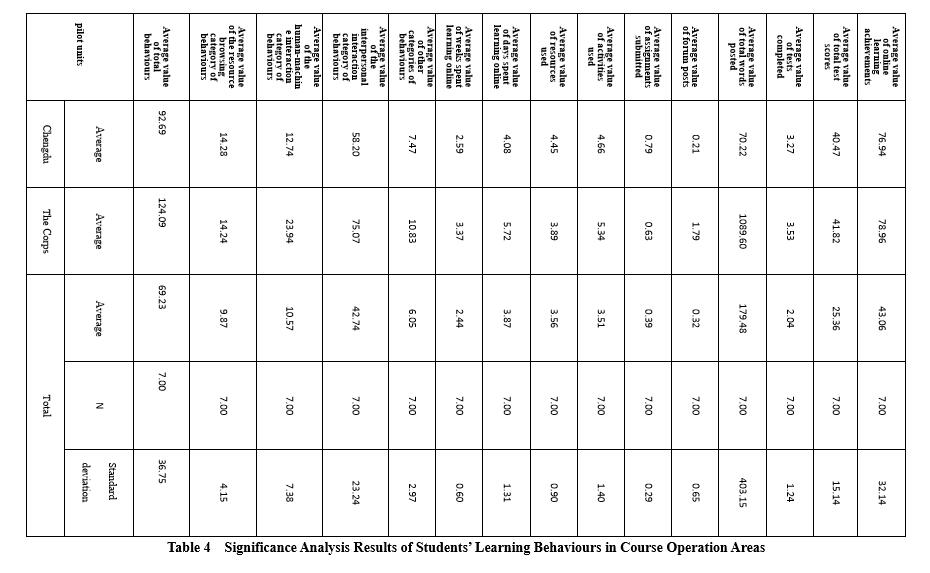
4. The influence of teaching scale on learning behaviours
A number of courses were selected in order to conduct a significance analysis of the learning behaviours of students in different classes. There is no significant difference between the learning behaviour data of students in different classes. Therefore, there is no obvious correlation between the scale of the course and the students’ learning behaviours.The restrictions of various conditions may lead to a deviation in the analysis results. This is especially true with regards to the situation that the teaching classes of the course operation are distributed across different branches, and their teaching conditions, teaching staff, and polices may all cause a certain degree of deviation on the analysis results.
5. The influence of majors on learning behaviours
The 57 courses are classified into nine categories: law, education, economic management, science, engineering, humanities, biology, foreign languages, and administration. A significance test of the behaviour data from the nine courses shows that there are no major differences between the courses.
6. The influence of course design on learning behaviours
As mentioned above, courses that follow the original flow layout design on the application platform are popular with tutors and students, and exhibit strong human-machine and interpersonal interactions. In general, the behaviour data values for these courses are all relatively high. The teachers and students interviewed seem to prefer these kinds of courses.
The above analysis shows that learning guidance and promotion by teachers enhance online learning and, in particular, the support of an organised teaching team plays a large role in encouraging the students’ learning process. Great improvements have been made in terms of course interaction, the completion of tests and assignments, and course achievements. In the meantime, the teaching management level, policy support, systematic guarantees, and excellent course design of the branches where the students learn are also important factors in igniting and encouraging online learning. Therefore, teaching teams that exhibit efficient collaboration, timely learning guidance and support, good management mechanisms, and quality course design have a vital role in guaranteeing the teaching quality of MPOCs and improving the teaching level.
V. Conclusions and Suggestions
Based on the research and discussions mentioned above, a summary of the factors influencing the learning behaviours of the students of OUC online courses is made and suggestions are given for the course development, instruction and learner support, and management mechanism of the OUC’s MPOCs so as to improve course development and to improve the effectiveness of online teaching.
(i) Conclusions
1. The time spent learning is concentrated and the level of interaction needs improving
The online learning achievements of OUC students are directly related to whether they can get credits andcertificates. Therefore students have very clear online learning objectives: to complete scored assignments and activities. Therefore, most students complete scored assignments and tests online across several concentrated days without learning persistence and with low behavioural data access;The interactive tools and functions of the teaching platform are not fully used, and the learning guidance and promotion role of the tutors’ and class tutors’ is not given full play. Neither human-machine interactions nor interpersonal interactions are able to meet expectations yet.
2. Assessment learning is emphasised but the resource category of learning is neglected
As seen from the analysis mentioned above, it is rather low either in behaviour of browsing resources or resource utilisation, the completion rate of assessed assignments and quizzes tightly related to the final examination is good. Since at present the statistics for resource browsing and the duration of resource usage are not collectable in the learning platform, these parts of most courses are not included in the assessment, which leads to low clicks and poor browsing rates.
3. There is a significant relationship between the behaviour data of teachers and students. Timely support from teaching teams is a key factor in ensuring MPOC teaching quality
As seen from the correlation analysis, the behaviour data items of the teachers and students are highly correlated. Online teaching behaviours such as forum posts, assignment revision, and internal memos are significantly related to resource browsing, interpersonal interaction, human-machine interaction, and course achievements among the students. Guidance and promotion from teachers enhances the students’ online learning. The teaching teams have a clear influence on student learning behaviours. Timely tutorials and learning promotion support by the members of the teaching team effectively improve online learning engagement, course interaction frequency, resource browsing, and learning results, and ensure the teaching quality of the MPOCs.
In the pilot projects, all the course teams have organised academic and non-academic teams the meet the needs of course teaching with clear division of responsibilities and job mechanisms in order to offer the students online teaching, tutorials, and learner support that has remarkable effect.Teaching effects of the pilot courses are greatly improved in terms of course interactivity, procedural learning behaviours such as resource use, and the learning results.
4. Good management mechanisms ensure the smooth operation of online teaching
An analysis of the influence of course operation areas over learning activities shows that educational units with solid organisation, good teaching policies and systems, and sufficient teaching staff are of great importance in promoting online teaching and learning, and thus increasing their effectiveness remarkably.
5. Course design directs learning behaviours and concisely designed courses are generally popular with students.
Course teaching and page design do have an effect on learning behaviours. If the design of courses are inclined towards exploration and practice, the average value of interpersonal interaction category of behaviours among students is greater. If the courses are inclined towards lecturing, then the value of the resource browsing category of behaviours increases. In Figure 2, the average value of students’ log in, navigation, and other categories of behaviours is the highest. Further analysis shows that problems such as mixed course page designs, unclear navigation, and complicated learning paths disorient the students. The students have to return to the previous browsing page by relying on the navigation columns or click the navigation columns several times before they can find the relevant contents. By integrating the analysis on the influence of course designs on learning behaviour with practical teaching and interviews with teachers and students, we can see that tutors and students prefer simply designed courses. They generally don’t get lost in such courses, which is more favourable for tutors to organise teaching, and for students to look up resources and complete assignments. The data value of all students’ behaviours for these courses is rather high.
(ii) Suggestions
1. On course development
(1) Strengthen process assessment and ensure the consistency of assessments and course contents
Methods of online course assessment are to be ameliorated in order to improve the proportion of process assessment. Students can be guided to learn at regular intervals by way of increasing assessment on usual learning behaviours and learning processes, and increasing the proportion of interpersonal interaction assignments. The consistency of learning resources and assessment and teaching objective design should be ensured in order to strengthen the correlation between resources and assessments, so that students can use learning resources to complete learning objectives and assessments and thus increase the students’ resource use rate. At the same time, attention should be paid to designing courses that are concise, lively, and interesting, and strengthen the design of learning guidance content in order to arouse the students’ interest in course contents, improve the rate of resource access, and establish the teaching process.
(2) Optimise course design and improve platform function
The course designs should be further optimised based on learning behaviour data in order to unify and simplify the course page and layout. Course knowledge maps can be added in order to reduce the time taken looking up course contents and provide the students with good course experiences through column navigation with clear design and streamlined course learning paths. The course development process should be standardised in order to establish course development and resource upload criteria and facilitate the ability of the platform to record data on learning behaviours. Functions or tools such as report forms, push notifications, and real-time communication can be added to make it possible to achieve real-time learning query, teaching intervention, online teaching research, and real-time question and answer sessions.
2. On course teaching and support
(1) Provide a one-stop teaching team that meets the course teaching needs and ensures teaching quality
In order to meet the course teaching needs, full-time tutors and class tutors for each teaching class should be established in order to offer students individualized learner support and to solve their problems related to discipline, teaching affairs, and teaching techniques. A scientific, effective team work mechanism should be established in order to guide online learning and interaction, ensure teaching quality, and improve the effectiveness of teaching. The OUC has realised from the pilot work the importance of a diversified one-stop online teaching team to online teaching in this respect. Efforts should be made to promote and encourage the construction of a teaching team for each course and major.
(2) Provide timely teaching support and encourage the students’ learning process
Targeted teaching plans and support mechanisms should be formulated in accordance with the students’ behavioural characteristics, to arouse the students’ learning interest, and increase investment and engagement in the resource and activity categories of the learning process to create a balanced learning environment. The role of the teaching and mining team is to be brought into full play to guide and urge the students’ participation in process learning. For example, tutors should push the students to take an active part in posting on the forums and the class tutors should use internal memos, forums, emails, and phone calls to further encourage the students to complete their assignments and log on to learn. At the same time, platform functions such as badges should be developed in order to increase learning rewards and encourage the students’ learning process.
3. On management mechanism
(1) Transform the function and assessment mechanisms used by the teachers and strengthen teaching team construction
In the MPOC teaching model, course organisation and support are covered by the teaching team. This paper introduces the teaching team used by the seven pilot courses, made up of 1 + N members (one course leader and several tutors) and the course project system teaching operation method. To the courses with a huge number of students, the teaching team usually operates and implements teaching in the organisation form of N* (1 + N). The teachers’ assessment mechanism should change in accordance with the transformation of job responsibilities of various kinds of teachers in the team based on the the conditions of the MPOC. Assessment is no longer made based on individual teachers but on the overall teaching team. Within the teaching team, all of the team members will be assessed and rewarded or punished by the course leader according to their teaching and feedback from the students etc. In order to ensure that the needs of the students for teaching are covered, educational institutions should encourage the construction of one-stop diversified teaching teams that are in line with the features of each course in order to provide the students with individualised learning support. Meanwhile, the teaching units should study teaching systems and management mechanisms that may be suitable for the MPOC teaching model and provide policy support, and human, financial, and material guarantees for teaching implementation in the MPOC model.
(2) Strengthen teacher training and improve teachers’ capacity for online teaching and service
Teaching capabilities such as course teaching design, organisation, learning guidance, learning promotion, and technical support can all be improved through a range of training scheme organized for course leaders, tutors, class tutors, administrators, and technicians in order to offer the students a quality course experience and strong learner support.
(3) Share cases studies and guide the teaching processes with data analysis
Cases studies on outstanding course designs and team operation mechanism should be shared through meetings and workshops in order to learn from the experiences of others, upgrade the overall teaching level of the MPOC team, and improve the operation mechanism. The results of any behaviour data analysis should be provided to the course team in order to present teaching in an objective and all-round way, guide course teaching and operation, and ensure teaching quality.
This paper provides an overall, preliminary analysis of massive data from MPOCs, which does not make further explorations to the in-depth reasons of teaching, learning behaviours and phenomena. In the next stage, an analysis of teaching behaviour data shall be conducted from multiple perspectives and levels in combination with qualitative research. For example, further research should cover the behavioural features of various types of students; the influence of mutual assistance among the students over learning behaviours; the influence of the supervision and guiding functions of teaching behaviours on learning; and the role of teaching intervention by course leaders in the promotion of process learning, in the hope to continuously improving the MPOC operation mechanism and learning support model.
Works Cited:
Chen Kan, Zhou Yaqian, Ding Yan, et al. 2016. Research on Learning Engagement for Online Video: Big Data Analysis of the Relationship between the Features of MOOCs Videos and Skipping Behaviour While Watching [J] Distance Education in China (4):35-42.
Guo Wenge, Shen Xudong. 2015. MPOCs:The Design and Implementation of Massive Private Online Courses [J]. Modern Distance Education Research (1): 22-32.
Jia Jiyou,, Liao Jingmin, and Wang Qiong. 2014. Big Data Analysis of the Learning Behaviour and Effect of MOOCs: Study of Six Peking University MOOCs [J]. Industry and Information Technology Education (9): 23-29.
Jiang Zhuoxuan,, Zhang Yan, and Li Xiaoming. 2015. Learning Behaviour Analysis and Predictions Based on MOOC Data [J]. Journal of Computer Research and Development, 52(3): 614-626.
Li Shuang, Wang Zengxian, Yu Chen, et al. 2016. Mining LMS Data for Behavioural Engagement Indicators in the Online Learning Environment [J]. Open Education Research (2): 77-88.Ma Xiulin,Mao He, Wang Cuixia. From MOOCs to SPOCs: An Empirical Study on the Effect of Two Kinds of Online Learning Models [J]. Journal of Distance Education (4): 43-50.
Sun Hongtao, Li Qiujie, Zheng Qinhua. 2016. A Cluster Analysis of MOOC Interaction Patterns [J]. Distance Education in China (3): 33-38.
Wang Ping. 2015. Analysis of Learners Based on edX Open Data [J]. Modern Educational Technology (4): 86-93.
Wei Shunping. 2012. An Analysis of Learning Behaviours and Their Influential Factors: A Case Study of Students’ Learning Processes in the Open University of China Online Course “Open Education Learning Guide” [J]. Open Education Research (4): 81-90.
Wei Shunping. 2013. Learning Analytics: Mining the Value of Education Data in the Big Data Era [J]. Modern Educational Technology (2): 6-11.
Wei Shunping, Zhao Xuan, Cheng Gang. 2015. Research on the Construction of a Data-Driven Online Learning Performance Model [J]. Journal of Tianjin R & TV University (03): 35-41.
Wei Shunping, Cheng Gang, Wang Lina, et al. 2016.Research on the Construction of an Evaluation Index System for Data Driven Online Course Implementation Processes [J]. Journal of Beijing Radio and TV University (2): 42-48.
Wei Shunping. 2016. Research on Data Models and Data Processing Methods in Learning Analytics [J]. China Educational Technology (2): 8-16.
Wu Jiang, Ma Panhao. 2015. A behavioural Analysis of MOOC learners: Case Study of an MOOC on the iCourse Platform [J]. Knowledge Management Forum (3): 52-61.
Zheng Qinhua, Chen Li, Lin Shiyuan, 2016. The Construction and Development of MOOCs in China [M]. Beijing: Publishing House of Electronics Industry.
JiaweiHan, MiehelineKamber, Jian Pei. 2012. Jiawei Han, Mieheline Kamber, Jian Pei. 2012. Data Mining Concepts and Techniques [M]. Fan Ming, Ma Xiaofeng, translators.Third Edition. Beijing: China Machine Press.
Williams, B., (2015, August 25).Rollcall: taking a census of MOOC students. Retrieved September 21, 2016
Gašević, D.,Kovanović,V.,Joksimović, S.,&Siemens, G. (2014). Where is Research on Massive Open Online Courses Headed? A Data Analysis of the MOOC Research Initiative [Electronic version]. The International Review of Research in Open and Distributed Learning, 15 (5), 134-176.
Hung, J. L.,&Zhang, K. (2008). Revealing Online Learning Behaviours and Activity Patterns and Making Predictions with Data Mining Techniques in Online Teaching [Electronic version].Journal of Online Learning & Teaching, 4 (4), 426-436.
Su, J. M., Tseng, S. S., Wang, W., Weng, J. F., Yang, J. T. D., &Tsai, W. N. (2006). Learning Portfolio Analysis and Mining for SCORM Compliant Environment [Electronic version]. Journal of Educational Technology & Society, 9 (1), 262-275.
Haggard, S. (2013, September).The Maturing of the MOOC.Retrieved April 20, 2016
Zaïane,O. R., &Luo, J. (2001). Towards Evaluating Learners’ Behaviour in a Web-Based Distance Learning Environment [Electronic version].Advanced Learning Technologies, 8, 357-360.
Footnote:
1. This paper is the research achievement of the 2015 key research project of the Twelfth Five-Year Plan of Beijing Educational Science “Research on Teaching Performance Evaluation System and Its Application in Massive Private Online Courses Based on Education Big Data” (project approval No.: AJA15233) and the 2014-2015 Youth Project of the Twelfth Five-Year Plan of the Open University of China “Learning Behavious in Massive Private Online Courses and Their Influencing Factors: Data from the Open University of China” (project approval No.: G14A0031Q).
About the Authors:
Shi Lei: master’s degree holder, assistant research fellow, Student Affairs and Teacher Development Centre, Open University of China
Add: #75 Fuxing Road, Haidian District, Beijing100039, P.R.China
Tel: 13311471462
Cheng Gang: Ph.D holder, associate professor, deputy director, Student Affairs and Teacher Development Centre, Open University of China
Add: #75 Fuxing Road, Haidian District, Beijing100039, P.R.China
Tel: 57519546
Li Chao: master’s degree holder, engineer, Student Affairs and Teacher Development Centre, Open University of China
Add: #75 Fuxing Road, Haidian District, Beijing100039, P.R.China
Tel: 57519377
Wei Shunping: Ph. D holder, associate research fellow, deputy director of the OUC Engineering Research Centre for Technology Integration and Application of E-Learning, Ministry of Education
Add: #75 Fuxing Road, Haidian District, Beijing100039, P.R.China
Tel: 57519371
*This paper is published in the issue No. 4 2017 (Serial No. 507) of the journal of Distance Education in China
Research on the i-Experiment Teaching Model in Vocational Education
Zhang Shaogang
The Open University of China
Beijing, China
Wei Shunping
The Open University of China
Beijing, China
Zhao Xuan
The Open University of China
Beijing, China
e-mail This email address is being protected from spambots. You need JavaScript enabled to view it.
Wang Mobin
The Open University of China
Beijing, China
[Abstract] Online education and on-site campus education have been developing from separate to integrated. Through the construction of the i-Experiment Teaching Model for Vocational Education, “i” is connected with the “love” for knowledge and practice to explore a solution that integrates information technology with cultural education, in order to build an ecosphere of online platforms, course resources, human-based management, and learner support, and thus promoting the structural reform of vocational education.
[Key Words] vocational education; teaching model;ecosphere; online platform; experiential learning
I. INTRODUCTION
Education institutions at all levels are advancing the profound integration of information technology with education. Relevant research on vocational education includes the following: (1) Informational teaching models are explored to accommodate vocational education and to demonstrate practical, competence-based training. Attention is paid to the comprehensive use of multi-media supported by modern information technology and based on the online environment, such as paper media, props media, audio-visual media, web-based media, blended media, and field practice. Attention is also paid to interactive learning, situational learning, and experiential learning, so as to equip the students with comprehensive professional abilities, particularly with regards to innovation and learning[1][2]; (2) Teaching platforms and resources for digitization are developed to suit vocational education, for example, the construction of a virtual and simulative teaching environment catering to practice and pre-graduation practice[3][4]; (3) In response to the requirements of vocational education digitization, challenges may be posed to teachers’ competency in digitized education[5][6][7]; (4) The construction and practice of an digital teaching management system that conforms to the laws of vocational education teaching[8].
These research projects attempt to address issues such as: (1) social discrimination, meaning that general education is superior to vocational education, and degree education is placed before skill training; (2) lack of funding for vocational education, insufficient input and poor school operating conditions; (3) teacher shortage, in particular those with dual qualifications; (4) lack of communication between second and tertiary vocational education, and general education and vocational education; (5) the necessary involvement of enterprises in vocational education, and the lack of a systematic guarantee for university-school cooperation leading to low initiative for some enterprises to participate in vocational education; (6) vocational education is managed by several departments, requiring systematic integration so as to optimize the management system and mechanism; (7) further improvement of the overall quality of vocational education. [9]
The key focus is to promote the further reform and development of vocational education with the participation of teachers in scientific research and with the help of new technologies such as the Internet, big data, and learning analysis to optimize vocational education teaching models. Moreover, the breakthrough lies in class teaching and blended campus education. “i-experiment” is an educational teaching model that has come into being against such a vast backdrop in an attempt to reform vocational education teaching.
II.THE SIGNIFICANCE OF THE I-EXPERIMENT TEACHING MODEL
“i-experiment” aims to explore a blend of online and offline within the teaching paradigm of “using practical and theoretical methods to improve education and sharing school wisdom through online interaction”[10].
The concept of “i” is based in the English vocabulary. There are a number of words beginning with “i” that suggest the idea of information technology, such as iPad, iPhone, Internet, Individual, Interactive, Inform, Instruct, Integrated, Interesting, Idea, Ideal, Intelligent, Innovation, and Inspire. Its homonym in the Chinese vocabulary is “love”, which expresses feelings or actions such as admiration, respect, care, fondness, willing to help but unable to do so, love me, love my dog and many others. This homonym is used here to link the surface meanings of “i” and “love”, thus integrating technology and culture.
“Experiment” usually refers to an operation or action carried out in order to test a scientific theory or hypothesis. In its usage here it has four levels of meaning. The first is to reform learning approaches, with a focus on target orientation and problem orientation, as well as inquiry and experiential learning; the second is to highlight the use of both the mind and the body, presenting a vision of teaching and learning by doing, forming solutions to problems through individual and team thought, creation, design and other conceptions, and taking action; the third is to emphasize the scientific spirit; the fourth is to underline the full demonstration of wisdom, infinite creativity and their continuous realization to reach high-level achievements.
“Online interaction” means people and things working interactively, including sharing innovative achievements online and getting online guidance from other parties.
To sum up the above concepts, the vocational education model constructed by “i-experiment” is interpreted as “learning through online activities, doing through lively cooperation, and getting pleasure through pleasant work”. In the era of personal media (we-media), platforms give each student the chance to fulfill their potential and display their knowledge, and to make individualized and practical achievements. Like-minded people with dreams throughout China and the world at large learn and help each other. Specifically, the “i-experiment” teaching model in vocational education focuses on online and offline cooperation and embodies the collective wisdom of teachers and students in learning activities from the perspective of teaching. It provides a connected teaching environment that emphasizes the maximum utilization of social education resources from the perspective of the teaching organization. Equal priority is given to the unification of sensibility and rationality from the perspective of the teaching approach. Therefore, the model can also be considered to be “constructing intelligent action”.
The technical implementation of the “i-experiment” teaching model can be understood through a “one-two-three-four-five” structure. One stands for one objective: the cultivation of learners with technical skills. From the perspective of the core of school management, learners are centered “to have all the students taught with what they want to learn, and put into practice and fulfill themselves with what they have learned”. An ecological and intelligent learning environment is also created to put learner support in place. Two stands for two dimensions: the interaction between the use of mind and hand, theory and practice, and knowing and doing. Learning by doing and experiential learning are highlighted for learners. Knowledge of the background, relevant principle and related techniques of an issue will enable the students to draw knowledge from case studies. Three stands for three links: the first link is online learning sharing by uploading words, photos or videos to the online “i-lab”; the second link is the online interaction of teaching and learning with possible choice of course resources and participation in discussion and mutual evaluation; the third link is basic practical experience, organized according to the needs of individuals. Four stands for four functions. The first is display. With a number of labs opened for “i-experiment” on the Internet, the achievements of the students and teachers can be exhibited in the corresponding labs. The second is evaluation and guidance. Expert teams are invited by each lab to comment on the works on display and to expand the knowledge of the teachers and students. The third is the course supermarket. Many related multi-media courses are dynamically added to the website, allowing learners to choose their requests. The fourth is to evaluate and redeem points. An evaluation system for learning results in each project lab is able to accumulate points for works submitted by individuals and groups through expert evaluation and display to other web users. Points are also accumulated through evaluation of course learners’ learning actions and learning results, and individual and collective points can be exchanged for relevant products or service. Five stands for support. The first is multi-functional online platform support, which satisfies the functions of uploading, downloading, saving, playing, searching, pushing, multi-terminal presentation, and one-stop services, among others. The second is support from the government and related educational departments. All the activities, as teaching activities for public benefit, are guaranteed sound and sustainable development under the instruction of the government and educational authorities and with assistance from the schools and relevant institutions. The third is support from industry expert teams. Under the instruction of the experts, the scientific nature and strong learning quality of the tasks is guaranteed. The fourth is support from relevant enterprises. Enterprises are encouraged to participate in public benefit activities, shaping a pattern where enterprises, schools, students and other relevant parties all win, while sharing wisdom, responsibility and benefits. The fifth is support of internship bases. Since learning is an interactive process, offline experiential learning has the ability to gather likeminded people and help them grow together.
III.THE DESIGN AND DEVELOPMENT OF THE I-EXPERIMENT ONLINE SUPPORT PLATFORM
The “i-experiment” online platform constructed during the research shapes the “i-experiment” series application websites and matching online resource systems based on the research achievements of the model.
The construction of the “i-experiment” platform is based on the educational resources of the Open University of China (OUC) and its cooperative vocational universities and enterprises for professional development and life skills in line with the principle of “serving the public and encouraging innovation”. This is achieved through a range of online practical education activities, such as i-creation, i-calligraphy, i-singing, i-apparel, i-ecological garden, i-3D printing, and i-digital, thus shaping a harmonious online and offline ecosphere for all participants, including teachers, students and the community. The trial website for the “i-experiment” online support platform is http://www.shequ.edu.cn. Figure 1 shows the technical route, overall framework and functional realization of the platform:
A.Overall system framework
The system will be made up of several modules that are loosely coupled with each other. They can work together or independently for step-by-step implementation within the project.
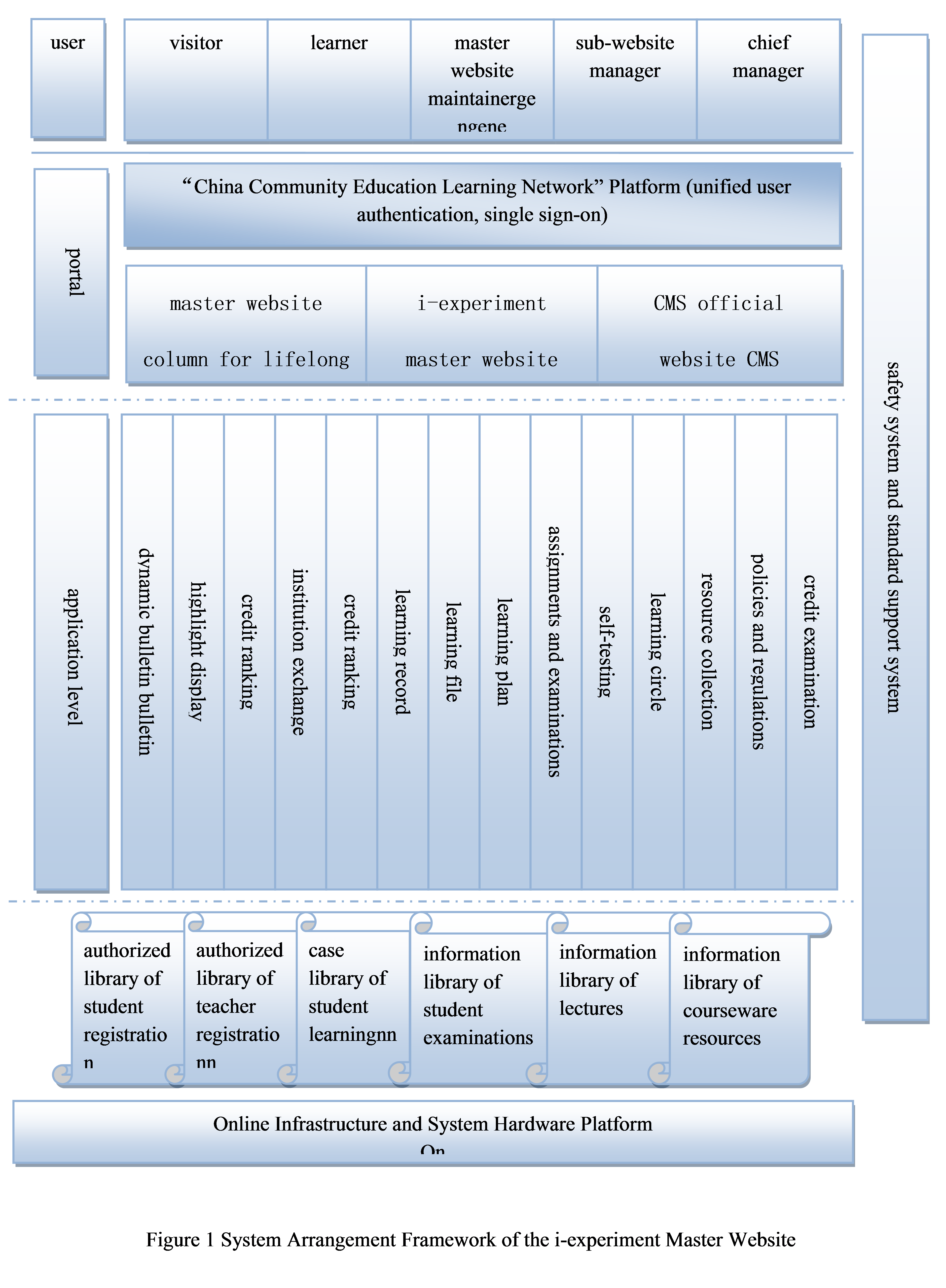
B.Functional structure of the platform
The major functions of the i-experiment master website cover the six aspects of openness, learning, course, action, management and services, as seen in Figure 2.
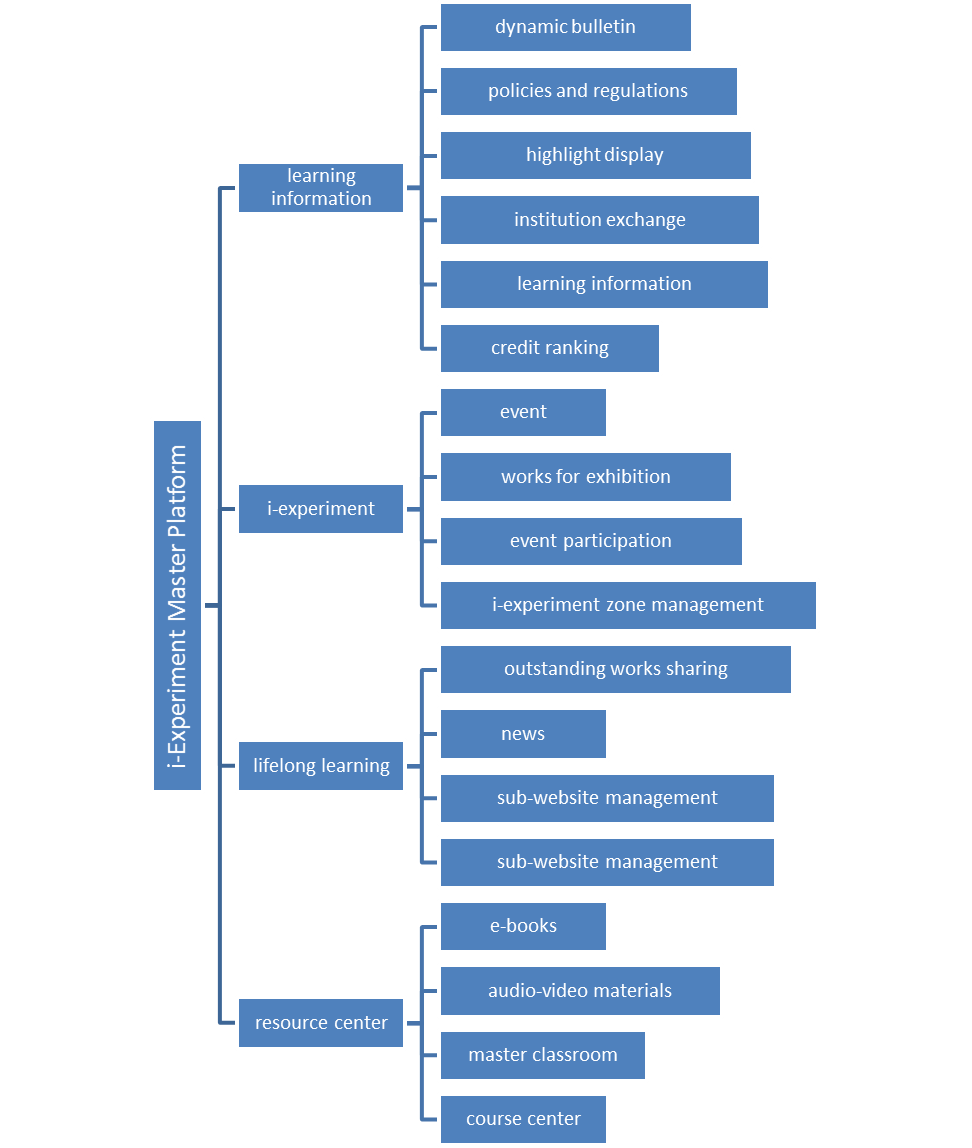
Figure 2 Functional Structure of the i-Experiment Master Platform
“Openness” embodies the complete openness of all kinds of resources. “Learning” expresses learning activities, including plans, notes, tests, and communities. “Course” represents resources, such as famous teachers, books, and audio-visual programmes. “Action” signifies interaction. Both visitors and learners can participate in their favorite projects. “Management” emphasizes the reinforcement of standards to create a strong ecosphere. “Service” focuses on orientation to meet the diverse needs of different learners.
Efforts have been made to try to innovate some of these website functions. The first is the integration of the community education network. The function of integrating local lifelong learning networks and third party resources is to bring together outstanding resources, and to shape them for online learning through the metadata information of various local resources. In the meantime, corresponding learning records are obtained through methods such as data capture. The contents integrated include a special i-experiment network and local courses for lifelong learning. The second is single sign-on. The i-experiment website has a “community education” channel, which integrates and stores resources from local lifelong learning worksites and learning service programmes as well as links to skip ahead. When they visit “community education” courses and service programmes, learners can skip to relevant “local community learning networks” (or one of the theme websites of the i-experiment project). Though they have their own independent user system and verification mechanism, learners can visit all the relevant application systems once they have logged on the master website, obtaining synchronous learning records from the master website and the “local community learning network” (or one of the theme websites of the i-experiment project). The third is resource integration. The objects of resource integration include course resources, dynamic information and other learning resources from the “local community learning network” (or one of the theme websites of the i-experiment project). The core information of these resources is stored in the resource database and provided by the network in accordance with its standards. The integrated resources are released by the master website and pushed to the “local community learning network” (or one of the theme websites of the i-experiment project) via the interface.
IV.THE BASIC CONSTRUCTION OF THE I-EXPERIMENT OFFLINE EXPERIENCE
With regard to offline experiential learning, the focus is learning by doing. The i-3D offline printing lab has been constructed as a pilot project as part of this research. 3D printing, aka additive manufacturing, constructs objects through layers of printing with special materials like metal powder, ceramic powder, plastics, resin and cell tissue based upon digital model documents. The construction of the i-3D printing lab, aimed at “the scientific popularization of 3D printing technology”, “user experience and practice of 3D printing equipment” and “3D design creation and innovation”, is a new type of experiential space (including an experience room and the i-experiment website) representing the functions of teaching interaction, design creativity, operation experience and product display.
The 3-D printing experience room consists of a guided tour zone, design zone, scan zone, operation experience zone and product display zone. Constructed by the community college, the room is equipped with a 3D printer, 3D scanner, high-performance desk-top computers and 3D printing materials, such as PLA resin, as seen in Figure 3.
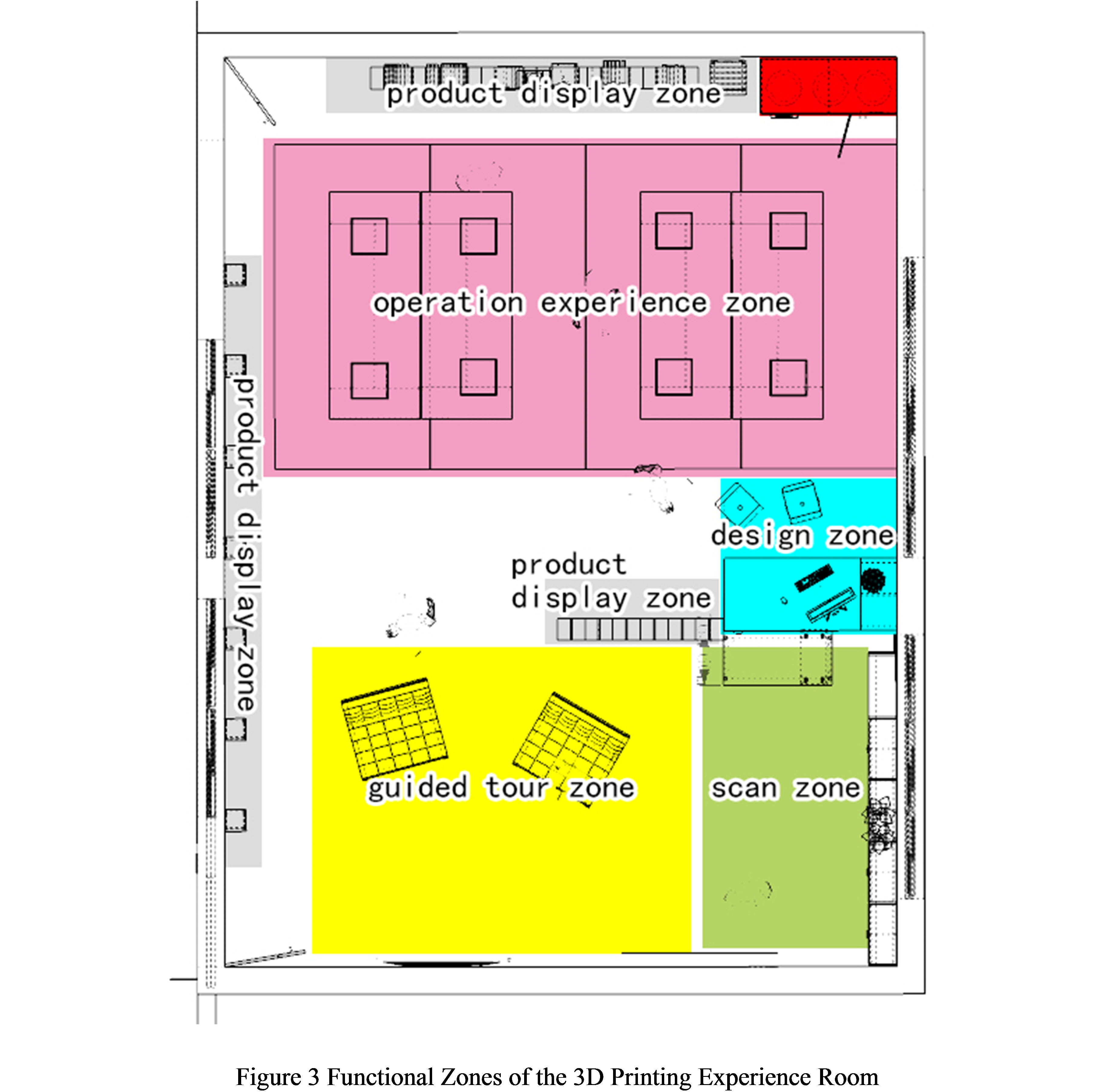
The guided tour zone functions as a reception for guided tours. After watching micro-courses and listening to open lectures on 3D printing, learners gain an initial understanding of 3D printers and the printing process. In the scan zone, the 3D scanner is arranged for teaching, making 3D digital modeling, and 3D human body modeling in particular, possible. The design zone presents the complete 3D picture through PC software so that learners can change and adjust the data of the 3D model, and build new models using 3D modeling software. In the operation experience zone, learners can copy the sliced 3D model obtained by designing or scanning and printing it with a 3D printer, which can be completed individually or in a group. The printing process can also be observed from several perspectives. The product display shows the works completed by the learners and acts to strengthen interaction and exchange during the course of the 3D design and creation process.
As a supplement and extension of offline lab, the online 3D printing lab has various functional zones that match those of the offline lab. It has developed corresponding online columns and shares news and resources about the latest international 3D printing technology allowing learners to follow the latest development trends of 3D printing technology, participate in 3D competitions, view display products, obtain learning materials, download 3D models, or set up exchange groups.
At present, the construction of the open physical i-3D printing lab based at Zhongguancun School in Beijing’s Haidian District has been completed. It offers 3D printing training and services for society and plays a role in promoting the construction of an innovative urban area.
V.CONCLUSION
In line with the principle of “serving the public and encouraging innovation”, the i-experiment teaching model for vocational education cuts through campus walls to create a harmonious online and offline ecosphere. Projects such as i-DIY remake, i-plant, i-cooking skill, i-financial management, i-paper cutting, i-tourism aim to respond to the needs of work and life. A colorful blended learning network will be formulated with the support of the online platform, course resources, human-based management and learner support.
The 2010 National Outline for Medium and Long-term Education on Reform and Development states that information technology has a revolutionary impact on educational development. In order to make a substantial impact in the field of vocational education, it is necessary to realize the full integration of information technology with teaching, and conduct structural reform accordingly within the professional education teaching system and especially within practical teaching system. The “i-experiment in vocational education” raised in this research represents an attempt to reform practical teaching in vocational education. As a result of this research it is not difficult to image that the courses, classrooms, teachers and students of the future might be very different from those we see today.
REFERENCES
[1]Luo Liping. Promoting the Reform of Vocational Education by Using Digitized Teaching Resources: Case Study on Building Digitized Teaching Resources for Vocational Education in Liaoning Province [J]. Vocational and Technical Education, 2011, 17:37-39.
[2]Li Ya. Thoughts on Information Technology Teaching Based on Constructivism [J]. Science & Technology Information, 2011, 30:444
[3]Lu Xin. Vocational Education Modernization Led by Modern Information Technology [J]. Agricultural Education Research, 2011,04:34
[4]Shi Huaguang, Huo Fang. Research and Application of the Digitized Teaching Model Through University-Enterprise Cooperation: Case Study of Digitized Teaching in Nanfang Vocational Education Group of Railway Transportation [J]. Industrial & Science Tribune, 2011, 16:145-146.
[5]Li Shurui. Reforming Traditional Education with Modern Information Technology: The 2011 Digital China Cup Competition of Digitized Teaching Among the National Secondary Vocational Education Schools Held in Shenyang [J]. Chinese Vocational and Technical Education, 2011, 34:44-47.
[6]Zhan Qinglong, Zhou Mingxing. Research on Teaching Models of Rural Vocational Education digitization in Mid-Developed Areas. [J].Journal of Tianjin Vocational and Technical Teachers’ College, 2003, 02:45-49.
[7]Wang Hongtao, Problems and Countermeasures in Digitization for Vocational Education Course Teaching [J]. Vocational and Technical Education, 2010,32:54-55.
[8]Huang Weiting,Wen Jinhui. Promoting Teaching Reform Through Design Competitions for Digitized Teaching [J]. Co-Operative Economy & Science, 2013,15:128.
[9]Findings of the Education, Science, Culture and Public Health Committee of the National People’s Congress Show Seven Problems in Vocational Education [DB/OL].
[10]Zhang Shaogang. The i-Experiment: Innovating the Community Education Model [J]. Modern Distance Education Research, 2012,03:14-18.
Research on Localisation Strategies for Imported Online Curriculum Resources
Han Yanhui
School of Foreign Languages, Open University of China, Beijing,100039
Abstract: During the 21st century, the rapid globalisation process has brought both opportunities and challenges to open and distance education. The opposite of globalisation is localisation. Importing globalised quality curriculum resources brings to light the issue of localisation. The Strategic Plan for the Open University of China points out that the requirements for importing excellent digital educational resources and cultivating globalised talents put forward in the National Outline for Medium and Long-Term Educational Reform and Development (2010-2020) are due to be implemented. The three pure-online educator training courses developed by the Open University of China(OUC) and Open University, UK(OUUK) (hereinafter referred to as “The Three Courses”) are an example of a successful attempt to do this. Effective localisation strategies deserve further study in order to offer new perspectives and suggestions for importing curriculum resources in the future. The semi-structured interviews common in the west were employed during the study. The qualitative research has led to localisation strategies such as ‘limited localisation’ and ‘internationalised localisation’, which has not been formulated in the literature. The strategies will be helpful in guiding the import of resources from abroad by the OUC and other educational institutions and enterprises.
Key words: pure-online courses, localisation strategies, imported resources, open university
Chinese Library Classification Number: G434 Document code: A
* This paper is one of the phased research fruits of the “Research on the Localisation of Foreign Curriculum Resources” (Project Approval Number: G11AQ0009Z), a key project of the CCRTVU in 2011.
I. Introduction
In 2010, the National Outline for Medium- and Long-Term Educational Reform and Development (2010-2020)(hereafter referred to as “The Outline”) issued by the State Council clearly proposed that China should “learn from international advanced educational concepts and educational experiences to promote educational reform and development, enhance China’s international status, and increase the competitiveness of education in China …introduce excellent education resources; attract well-known overseas schools, educational, and research institutions and enterprises to cooperate in establishing educational, teaching, training, and research institutions or projects; explore various ways to leverage outstanding overseas education resources.”[1] In addition, The Outline points out that digital learning resources should be integrated through such means as direct introduction, reprocessing, purchasing, and cooperation, so as to realize the rapid expansion in quantity and continuous enhancement in quality …” [2]Learning resource construction is listed among the four key construction projects as part of the future construction of the OUC, in order to implement The Outline’s requirements for importing overseas digital education resources and training international people. Since the official launch of the three courses, which were aimed at training online educators (eTutors) and were jointly developed by CCRTVU (OUC) and OUUK since 2009, they have won unanimous praise from the trainees in the RTVU system and the online education schools in universities, as well as the staff in charge of e-Learning training within enterprises. The research on the localisation strategies for the three pure-online digital resources appears to be of particular significance, and their valuable experience and strategies will play a leading role in the construction of the OUC’s own “outstanding digital learning resources”.
When talking about localisation, we cannot exclude globalisation. In the 21st century, the pace of globalisation has been continuously increasing. The rapid development of information and communication technologies has had a tremendous impact. The knowledge-driven economic and social development as well as increased regional competition are creating educational reforms around the world [3]. There are many descriptions of globalisation and localisation; generally speaking they are relatively close in meaning. Here, we tend to adopt the widely quoted definition by Cheng Yin Cheong: “Globalisation refers to the transition, adaptation and development of values, knowledge, technologies and standards of conduct among countries and societies around the world. Insofar as education is concerned, the phenomena and features of globalisation mainly include the globalised network (such as the Internet), the technical, social, cultural and academic transformation and the flow among the aforementioned elements, as well as international alliances and competition, international cooperation and exchanges. The outstanding examples in the globalisation of higher education include web-based learning, international partnerships for teaching and learning in the levels of groups, classes and individuals, the transnational interaction and sharing through video conference systems, and so on”[4]. “The Three Courses” can be considered a typical successful example of web-based learning. However, when the teaching objects of “the three courses” are Chinese students in related fields, localisation is inevitably involved. Cheng Yin Cheong believes that “localisation refers to the transition, adaptation and development of related values, knowledge, technologies and standards of conducts happened from/to the local contexts. The features and examples of localisation include the localized network, the improvement of the external technical, social, cultural and learning initiatives carried out for local communities, the development of local culture and satisfaction of community requirements and expectations. The significance of localisation in higher education is to maximize educational correlation in the development of localisation and to provide support for communities and various resources. The development of new course content related to the technical, social, cultural and learning aspects in the society has gained more and more attention” [5] At the strategy level, higher education is still at the exploratory stage in terms of globalisation and localisation [6] A coherent globalisation strategy in higher education has yet to be developed, and the same can be said of a localisation strategy. In terms of globalisation, we can only borrow theoretical perspectives from the aspects of business, politics, and international relations, such as the World Systems Theory, Polity Theory, World Culture Theory, and Neo-Liberal Theory. Of these, World Culture Theory, whose central argument is that the world is becoming more and more convergent in culture and that Western culture seems to have become the basis of cultural influence and transition, is possibly the most relevant theory to the globalisation and localisation of higher education.
II. Literature Review
During the literature review, the author discovered that the vast majority of papers only focus on generic discussions of the localisation of original textbooks and curriculum theories (with some study of internationalisation), instead of penetrating into the literature review research about the localisation strategies for imported resources. Most are aimed at academic education in high schools and vocational schools. The literature review shows that only one paper has studied the three courses co-developed by CCRTVU and OUUK [7] However, this paper is basically an introductory study, which lacks sufficient qualitative research data. According to feedback from the trainees, the paper mentioned the difficulty in reading original English materials and the difference in academic ability. According to the tutors’ feedback, it mentioned that “the evaluation method originally designed in the materials provided by OUUK has been adjusted according to Chinese students’ learning habits…”. However, it lacks proof of effect of the adjustment. The study failed to rise to the level of the study of localisation strategies for introduced resources. Fang Chunsheng also mentioned the problem of students’ low English language ability, which is closely related to the introduced resources, in his discussion on The Teaching Problems Present in the Localisation of the TAFE Education System in high vocational colleges. In Thoughts and Solutions for These Problems he also proposed that we should “strengthen the training of basic knowledge and the English application ability of the students”, and “construct a ‘dual tutors’ and ‘bilingual tutors’ team to enhance the cultivation of tutors” [8]. As a tutor for one of the three courses, the author also realizes that in the training of the three courses, the problem of students’ poor English application ability does exist, while the localisation of introduced resources requires the localisation and improvement of the abilities of the tutors, who not only need to understand advanced overseas teaching concepts, but also understand local students’ needs, and to have stronger industry experiences, for example online teaching experience. In addition, although Luo Xiaorong’s A Practical Exploration of Teaching Localisation for the BTEC(Business & Technology Education Council)Curriculum in Higher Vocational Colleges is aimed at the BTEC teaching model rather than introduced resources, it is still of significance to the research. When talking about “the difficulties present during the process of BTEC curriculum teaching”, she points out that “primary is the impact of concepts and interests; second is the deviation in understanding the learning value; third is the gap between Chinese traditional education and foreign education, which can be seen in the three aspects of educational concept, evaluation, and students”. When talking about “measures to promote the localisation of BTEC curriculum teaching methods”, she proposes a “fundamental change to the educational concepts” and “a reform of the evaluation standards for tutors and students” [9] This can be seen as a preliminary inquiry for localisation strategies about introduced foreign teaching modes. In addition, Weng Xiuping points out that “in the process of introducing textbooks” for primary and secondary schools, they “should adapt the original textbooks accordingly basing on the curriculum standards, learning conditions, and teaching abilities in our country so as to make them applicable and operable in teaching guidance and so that they are equipped with more localized features” [10] However, Weng does not mention specific localisation strategies for introduced resources.
The literature review shows that the relevant studies mentioned above all lack research on localisation strategies for pure-online curriculum resources introduced from foreign countries. What localisation strategies should be used for training-based, pure-online curriculum resources, such as the three courses co-developed by the OUC and OUUK? Has the localisation of the three courses before training been successful? What are the shortcomings? If the adaption is unsuccessful, what are the reasons?
III. Research Methods
This research is based on semi-structured in-depth interviews (the interviews do not rigidly adhere to the prepared outline and themes, but make adjustment according to the interview subjects and process for in-depth inquiry) with 18 trainees, tutors, and course managers. First-hand research data was collected and an in-depth contrastive analysis on these data was conducted. The characteristics of the interviewees are shown in Table 1.
Firstly, the author prepared an ethical notice and an interview outline. He then sent out the interview invitations to potential respondents through e-mail and QQ Instant Messenger. In terms of sampling strategies, starting from the diversity and comprehensiveness of the study, the author identified three categories of respondents: tutor trainees (trainees), course tutors, and course managers. The data collected from the three interview groups would be verified by each other and “conflict” with each other so as to reach the required validity and reliability for an exploration of localisation strategies (as shown in Figure 1). In selecting the interview subjects, the study not only chose trainees who have recently finished learning the courses, but also trainees who finished the courses relatively quickly. In terms of choosing tutors, the study paid attention to the balance of the three courses. In addition to tutor teams composed of two or three tutors, there were also individual tutors. In terms of choosing course managers, this study not only selected managers directly responsible for the introduction and management of the three courses, but also specialists and scholars who participated in the introduction, negotiation, and provision of advisory services for course management and teaching. The author sent out a total of 23 invitation letters, and received positive responses from 18 interviewees. The author and the respondents then fixed a time and place for the interviews. Due to geographical limitations, almost half of the interviews were conducted remotely via mobile phone, while the rest were conducted face-to-face. All the interviews were recorded in full. Before starting the interview, the author read out the ethical notice to the interviewees and informed them of the interview and research process. Each interview lasted 10 to 15 minutes. The interview recordings were transcribed, amounting to 60,000 words of interview data.

Note: Among the interview subjects, two people participated in the courses as a trainee and then as course tutor. Although double counting appears in the statistics, the actual number of interviewees is 18.

IV. Research Findings
Based on the transcribed recordings, the author re-examined all the ideas and perspectives expressed in the interviews and highlighted important key words or phrases related to the research issues. The marked sentences were compared through the process of ‘open coding’ [11] which aims to transform key words or phrases into discrete concepts that are closely related to the research issues. After this, the words or phrases belonging to the same concept are classified under one label. All the concepts are divided into either the prospective or temporary category. Finally, the original data obtained in the interviews is used to backtrack all the concepts, with the purpose of verifying them.
(1) The Conflict between English and the Mother Tongue
When curriculum resources are introduced from abroad, the first thing to consider is the conversion from English to the destination’s mother tongue, in this case, Chinese. Eight out of nine trainee interviewees explicitly admitted having difficulties in reading and writing English materials. They want to translate all of the English reading materials into Chinese, and, ideally, to be provided with both "an English version and a Chinese version". Meanwhile, about half of the interviewees proposed providing English-Chinese bilingual versions. It is important to note that only one trainee didn’t express any difficulties in reading and understanding English materials. When asked:“If within the three courses there are a couple of English articles that are not translated into Chinese, can you read them?” he answered "More or less. Translation is needed in one course, but not in the other two courses … with a dictionary, it is understandable. "This indicates that only this student has high English literacy and can read smoothly with a dictionary and understand accurately.
The English literacy of the other eight trainees may need to be improved. They agreed that reading the English reading materials was "with difficulty", "hard work" and "with obstacles" so they could “barely finish reading them". They hoped to be provided with an “English-Chinese bilingual version”. “The bilingual version is not so bad”.
Trainee Number Two mentioned the problem of “regional cultural background”, which may also affect the trainees’ understanding of the English materials. Cultural background is a very important factor in the localisation and internationalisation of resources. Wherever possible, we should remove content with specific regional cultural characteristics. When introducing resources that include aspects of regional culture, we should first translate them accurately and then add appropriate notes as interpretations, or illustrate them by using corresponding local culture as a contrast. Trainee Number Three pointed out the problems that exist in the learning contents and the translations of the reading materials: “Some of the translation … seems to be done literally. Some things need to be explained by using Chinese professional distance education terminology. Some are hard to understand.” This is related to the accuracy and specialisation of the translation, which is a difficult problem to overcome while introducing foreign resources.
The interviews with tutors also reflect the problem of poor English literacy of the trainees. Most of the tutors admitted that “the foreign language skills of the Chinese students are not very good”, which can create difficulty in understanding the reading materials. It must be noted that in the Student Support course, there are many English reading materials that require trainees to translate them with the help of Wiki collaboration. The response of Tutor Number One, who is responsible for this course, was typical: “When students do the translation, their language is not smooth enough and it is clear that it has been directly translated, with some uncomfortable words and phrases. Furthermore, in terms of content, to some degree it represents the UK practices or thought processes, which may be beyond the understanding of our students because the content reflects the culture and background in the UK. As a result, some knowledge points are not understandable, or suitable, for us.” He also emphasized that: “There is feedback about the English materials, saying they are not readable. Afterwards, I gave [the trainees] the articles translated by the previous students. However, they gave no further feedback as to whether this is a good method.” Tutor Number Two, another tutor responsible for the Student Support course, simply cancelled the homework given to translate the English reading materials through Wiki collaboration. Instead, he provided a Chinese version. However, he also said that: “The trainees must only read the Chinese. There is no feedback for English yet. The correlation between our activities and the resources is not strong. Even without referring to the resources, I can give few responses after an activity.” Tutor Number One has taken a similar approach: “I feel that it is not beneficial to let the students do the translation. So, I completely changed the task for that class … by providing them with the translated version done by previous students, for reference. That means the homework for this class was cancelled.” The above demonstrates that the trainees rely on their mother tongue. The tutors responsible for the other two courses of “Tutoring Online” and “Course Design” didn’t reflect the language problems caused by translation. However, Tutor Number One and Trainee/Tutor Number One pointed out that the translation should be precise: “Just like translating foreign monographs, translation must comply with the original work. In considering whether some statements should be changed or not, the habits of the Chinese students should be adhered to.” Trainee/Tutor Number One commented that a “Chinese-English bilingual version is good. For those with good English skills, they can read the English parts. The translated Chinese parts are suitable for students to discuss.”
Course Manager Number One also stressed the importance of language reformation and pointed out that the reason why not all resources were localised is due to the “large workload … I hope that the tutors can improve their own language skills at pace with the internationalisation of education in China.”
However, the un-translated reading materials bring great difficulties for the trainees, especially for the Student Support course, as their language attainment needs further improvement. This may also indicate that the difficulties and challenges met by the OUC in the process of moving towards internationalisation are considerable.
Course Manager Number Two and Course Manager Number Three both agreed that the first step in localisation was translation, stressing that “some contents which do not read smoothly have been corrected” to accommodate Chinese thinking and habits.
(2) "Limited Localisation" in Teaching Design Collision
Among the nine trainees, six (all are trainees for the Tutoring Online course) clearly expressed acceptance of this kind of online learning. When asked their opinions about the design of teaching units on a weekly basis, they all agreed: “I haven’t had any contact with it before. I gained a lot after learning like this for the first time”. They said they were prepared to apply this kind of advanced methodology in their actual teaching.
The reason why most trainees like this kind of teaching design is that “this kind of constraint is very good”. “It creates enthusiasm” and can change students’ passive learning habits. The reality is that students in China are relatively lazy, have weak learning autonomy, and always need outside constraints. As Tutor Number Three pointed out, “RTVU students are not too active … which may be the result of decades of education in China. Our students are not very good at asking questions. They should learn to put forward questions that arise from their own teaching or in their own work, or raise more demands. Trainees usually just think about what they have learnt from the course, instead of using it to solve their problems.” Designing teaching units in a weekly cycle helps students overcome their passive learning habits, enhance their motivation to learn, and gradually develop active learning habits.
This kind of advanced teaching design is actually very common in foreign countries. When the author studied at the Institute of Education, University of London from 2006-2007, the online Master’s course Computer Mediated Communication was based on weekly units. At that time, the feedback from students in more than 10 countries was universally positive.
Tutor Number Two also commented that: “The feedback on OUUK’s weekly course cycle has been positive. The students are comfortable with it.” From a manger’s point of view, the tutor also hoped to “use advanced concepts to change themselves”, which was echoed by Tutor Number Four.
We kept the OUUK’s advanced teaching design concepts in the three courses jointly developed with them, which was actually a form of limited localisation. We should borrow advanced foreign concepts and turn them into our own. “I think that conflicts between teaching concepts must be a problem. We should strive to adapt our own traditional concepts, instead of transforming them”, Tutor Number One said.
On the basis of this teaching design, we have also added a number of Chinese-English reading materials. For example, in the Tutoring Online course, the author has added six English papers and seven Chinese articles, with the aim of helping students understand local cases and compare them with foreign cases, while the goal of the carefully selected English papers is to improve the trainees’ research methods. Trainee Number Four’s point of view is very representative:“[The supplementary materials] are very helpful.” This is echoed in the original intentions of the course managers: “We have chosen some additional domestic literature in the process of localisation with the hope of combining cases with the domestic situation … To put it another way, our own tutors are also engaged in localisation work.” In this regard, it can be said that our localisation transformation has been successful.
(3) The "Internationalised Localisation" of Evaluation Methods
We found that the biggest improvement is the difference in summative assessment. The examinations are originally designed by the OUUK. However, based on the needs and actual circumstances of the trainees, we changed the examination into writing a final paper. Meanwhile, we reduced the number of activities included in the resources provided by the OUUK, and replaced them with a short essay of at least 500 words, while giving a more explicit description of the Wiki-based activities. In this way, we combined the formative and summative assessments. Over the past 30 years of its development, CCTRVU has accumulated a wealth of experience in the distance education field and can successfully refer to advanced international practices. We copied this combination of the advanced practices of internationalized formative assessment and summative evaluation (writing papers instead of examinations) to transform the resources from the OUUK, which can be regarded as a successful attempt at localised internationalisation.
Trainees give positive feedback on modified evaluation methods. This means that the RTVU system has been successful in terms of learning from the best international practices.
The requirements of writing a final paper are relatively high. Trainees are required to write their papers in accordance with the requirements for English-language academic papers overseas, which helps students learn how to conduct rigorous academic research. Taking into account the nature and cycle of the courses, certain adjustments were made. The regulations for the final paper are as follows: Write a paper on one of the topics in any of the course units, or a related topic of your own choosing, either in English or Chinese, 2,000-5,000 words. The papers should include an abstract, introduction, literature review, and main body text, which should also include the trainees’ own views and be explained with examples. There should be at least five reference articles covering either Chinese or English literature in the last five years.
The design of the final paper is also an ‘internationalised’ localisation reform. From the positive response received, this reform has been successful.
(4) Localisation Brings Challenges for the Construction of the Teaching Team
In the process of the localisation of imported resources, another major challenge is the construction of a corresponding teaching team. In our interviews, it was clear that the requirements for tutors are very high and are mainly related to the areas of the teaching team, tutors’ levels, cooperation and collaboration, comprehensive qualities, and abilities.
Trainee Number One focused his views on tutors’ levels. "Division of labour must be clear and there should be collaboration.” Citing his own work experience, Trainee Number Seven pointed out that "online teaching experience" is important. In addition, we need to understand the actual situation of the students. Trainee Number Four values cooperation and collaboration. She stressed that "tutors should be good at English and also familiar with the learning situation abroad." The value she puts on English ability reflects that, whether in localisation or internationalisation, language quality is the foundation. Otherwise, it is hard to follow the latest international advances or have an international vision. Technology issues were also frequently mentioned as an important aspect. Trainee Number Six reckons that "the tutor of this class not only needs to have the same knowledge as a classroom teacher, but also understand technology and the perspective of an online tutor. "The trainee integrated the face-to-face education with online education in a very good way, which can be deemed as a request for the comprehensive qualities of online tutors.
It is worth noting that Trainee/Tutor Number Two stressed both "responsibility" and the "ability to write papers" for online tutors. "They should not only be specialised, but also understand the connections between his own major and other majors. "This may be related to her own strong ability of academic research. In addition, her expections on online tutor’s interdisciplinary abilities are reasonable.
In conclusion, we can see that localisation sets high demands for the construction of a corresponding teaching team. Faculty-building requires strong English quality, communication skills, online teaching experience, strong technical background, the ability to integrate traditional face-to-face education and online education, academic research ability, and high sense of responsibility.
Course tutors also recognize the requirement for the comprehensive quality of corresponding tutors. Course Tutor Number One stated that "there should be higher requirements. I feel that course tutors need to understand the whole system, including the process abroad and things related to localisation. In addition, there are times when you should add your own understanding, which helps the students understand certain elements. ”
The point of view of Course Tutor Number Five is much more comprehensive. "In importing resources from abroad, it is better for tutors to have a global perspective ... For online teaching, the tutor’s abilities and dedication are of greater importance than his own level of teaching.. Another option is to focus on tutor training. ”
(5)The "Conflict" Existing in the Internationalisation of Localisation in Media Usage
During the interviews, the most prominent problem reflected by the trainees is the singularity of the teaching media i.e. the pure text media. "All text" and "text courses” create a slight monotonous feeling. They hope that the courses will "add videos to complement the text" and include "some lectures by foreign tutors". It is natural for the trainees to have such a complaint. They were brought up on traditional "spoon-fed" education and are accustomed to video lectures. However, for online training courses such as the three courses, according to Western philosophy, it is not necessary for a tutor to appear in the video to give a lecture. Plain text content and discussions can achieve the learning objectives and realize the learning goals. The Project Team has also requested that the OUUK offer lecture videos, but they did not seem to understand why. "At that time, the OUUK shed doubts on this (laughing)" (Instructor Number Three). From the author’s experience of studying in UK, text-only teaching of similar courses is feasible. There is a conflict between the international teaching pattern and the local learning paradigm.
The course tutors also mentioned this issue, without explicitly saying that they would increase video lectures. Among the tutors, only two thought that video lectures should be added, but "how to do this remains a problem. "The points of view of Trainee/Tutor Number One and Tutor Number One may be more objective and more representative: "There is no need to prepare multimedia learning materials. It would be better to add some more reference cases"; "I think text-based learning is fine. There is no need to use full media means for each course as required by CCRTVU. The means should be determined primarily according to the course content. ”
From the course tutors’ points of view, their understanding of the teaching content and accompanying media is more rational and objective. Course Manager Number One's view echoes this perspective: "I do not accept systematic (video) lectures since they go against the original purpose of course design and the philosophy of the introduction of courses. It is still necessary for the students to find, summarize, and then draw their own conclusions through interaction with the other students, which is our concept for the introduction of the course ".
Course Manager Number Three mentioned that he was submitting an application to the university to do a short video clip for each course with the purpose of playing a "leading" role for the course study.
To summarize, we can see that neither the course tutors nor course managers recognize adding systematic lecturing videos. However, the "introductory" videos we prepared to increase for the course are understandable since this will better guide students to learn the course. This is also part of the "limited localisation" strategy.
V. Discussion of the Research Findings
During the process of comparing and analysing the research data, we found that the "conflicts" are mainly reflected in the following aspects: the conflicts and tension between the native language and English; "limited localisation" of teaching design; the “localisation of internationalisation” of evaluation methods; the challenge of teaching team construction; and the "conflicts" of the “internationalisation” of localisation in terms of media usage. It could be said that the above aspects roughly cover the problems that occur generally as part of the Sino-foreign cooperative development of pure-online course resources. The problems reflected in the research firstly lie in the fact that the English level and capabilities of the students need to be improved, which will be one of the major problems facing the strategy of localisation of foreign resources for a long time. Language is also a reflection of culture. As Cheng Yin Cheong points out, the needs of localisation include the improvement of external cultural and learning initiatives oriented towards local communities [12]. Although we have translated the resources provided by the OUUK into the local language, the quality of translation needs to be improved. On the other hand, from the perspective of the course managers, it is hoped that students can use the translation task as a means of improving their English level. Unfortunately, the ability of the students does not meet this high requirement. This also involves another comparably serious challenge: regardless of whether the versions we provide are in both English and Chinese, or an English version with a Chinese version for reference, students may still be "lazy". Instead they directly refer to the Chinese version and skip the English version, which is of no use for improving their English level and further enhancing their capacity for international exchange in the future. This also reflects the natural inertia students experience. Both localisation and internationalisation require further research. With regard to teaching design, we have proposed a strategy of "limited localisation", that is, for overseas advanced concepts, we adopt them with the purpose of "adapting our traditional ideas" instead of fully localizing them. We have made targeted modifications by adding more local stories so that students can better combine the learnt knowledge and theories with local problems. In terms of evaluation methods, we have adopted another strategy, namely the "localisation of internationalisation". We should firmly eliminate what we regard as "dregs" and "fight against" foreign concepts and practices that we believe are inappropriate by using "internationalized" advanced concepts and practices. In this regard, we believe the "localisation of internationalisation" practice in the summative evaluation of the three coures provided by the OUUK was very successful, in that we use a final paper that is in line with the needs and actual situation of domestic trainees to replace the examinations originally designed by OUUK. It can be seen from this example that localisation and internationalisation sometimes can be blended and transfer into each other. Through this research, we found that a very large challenge facing the construction of the OUC in the future is the implementation of an internationalized faculty brought about by the localisation. Cheng Yin Cheong notes that the phenomena and characteristics of globalisation include technical, social, cultural, and learning transfer, international alliance and competition, and international cooperation and exchanges [13], which places heavy demands on the construction of the teaching team for open and distance education. From the most basic language level perspective, at present, the English level and ability of the tutors in the RTVU system are still very low. Whether for localisation or internationalisation, they are unable to adapt to the requirements of the new situation. They need to continue to improve their language skills, otherwise "internationalisation" will be an empty promise. In the future, teaching team construction will focus on the following areas: teaching team, tutor skill level, cooperation and exchange, and comprehensive quality and ability. A number of teaching teams must be constructed so as to create a group advantage. In addition, all the tutors should be grouped into different levels and tutors’ roles must be clearly established. These tutors must have the ability to engage in exchange and collaboration, and cross discipline and special capacities. "The team must have an international perspective, which is of great importance to the OUC." In terms of media usage, the "conflict" of the "internationalisation" of localisation is normal and this is in fact a fierce collision between traditional domestic teaching concepts and advanced teaching philosophies from abroad, as well as a shock and subversion to the traditional "spoon-fed" education methods, requiring us to adjust or change traditional, backward ways of thinking and accept advanced international concepts so as to face up to internationalisation. For internationalised advanced concepts and practices, what we want is to take them with a mind of acceptance and determination.
To sum up, in this study, we proposed the strategies of "limited localisation" and "internationalised localisation". "Limited localisation" means that, for advanced foreign concepts, we "borrow" them directly without any changes. It is worth noting that, on this basis, we can still carry out some small changes related to the concepts, such as providing more localised cases. For the "internationalised localisation", our perspective is based on the international level; by inspecting international concepts and practices we can select the best options from the resources and carry out "internationalised localisation". In other words, if we find that there are international resources, ideas, and practices that are better than the ones we have already introduced, we should be able to adapt the introduced resources, and replace them with internationalised ideas and practices.
Based on the strategies of "limited localisation" and the "internationalised localisation", we further propose a future localisation strategy for foreign resources for the OUC: The localisation strategies of "limited localisation" and "Internationalised localisation" should be maintained during the period of introduction. After the transformation is completed, pilot teaching is firstly recommended to identify the problem and potential solutions so as to further perfect the resources and then eventually finalize the transformation, as shown in Figure 2 below:

VI. Conclusion
Through the qualitative research conducted for “The Three Courses” (Student Support, Tutoring Online, and Course Design) jointly developed by the CCRTVU and OUUK for the training of online educators (eTutors), we compared and analysed the five problems that became apparent during the interview research and held in-depth discussions. The localisation strategies of "limited localisation" and "internationalised localisation" were formed on this basis. Finally, we have put forward a localisation strategy for foreign resources for the OUC: adapt to the strategies of "limited localisation" and "internationalised localisation", launch a pilot programme, and then further improve the resources and complete the final localisation.
Due to the time constraints of this study, when choosing the sample, the trainees were mainly taken from the Tutoring Online course and the tutors mainly from the Student Support course, which may have some impact on the study’s validity and reliability.
References
[1] National Outline for Medium and Long-Term Educational Reform and Development (2010-2020)[EB/OL]. http://www.gov.cn/jrzg/2010-07/29/content_1667143.htm,2014-10-18.
[2] Strategic Construction Plan for the Open University of China
[3]Cheng, Y.C. & Townsend, T. Educational Change and Development in the Asia-Pacific Region: Trends and Issues[A]. In: Townsend, T & Cheng, Y.C. (eds), Educational Change and Development in the Asia-Pacific Region: Challenges for the Future[C]. The Netherlands: Swets and Zeitlinger Publisher, 2000:317–344.
[4][5][12][13] Cheng, Y. C. Paradigm shift in higher education: Globalisation, localisation, and individualisation [DB/OL].
[6] Maringe, F. The Meaning of Globalisation and Internationalisation in HE: Findings from a World Survey[A]. In: Maringe F. & Foskett N. (eds.): Globalisation and Internationalisation in Higher Education - Theoretical, Strategic and Management Perspectives[C]. London: Continuum, 2010:17–34
[7]Practices and Reflection on the Development of Online Training Courses Between China and the UK, Li Yawan, Li Ying, 2011,17(1):68-72, Open Education Research
[8]A Discussion of the Localisation of Australia’s TAFE Education System in Higher Vocational Colleges, Fang Chunsheng, Fu Xiaochun, Song Hui, 2010,(26):5-8, Pharmaceutical Education
[9]A Practical Exploration of Teaching Localisation for BTEC Courses in Higher Vocational Colleges, Luo Xiaorong, 2006,(6):509-513,Teaching Research
[10]Analysis of the Present Situation and Strategy for the Introduction of Textbooks for Primary and Middle Schools, Weng Xiuping, 2009,(3):68-70,Teaching and Management
[11]Strauss, A., & Corbin, J. Basics of Qualitative Research: Grounded Theory, Procedures and Techniques[M]. London: Sage, 1990.
About the author:
Han Yanhui: Master’s degree holder, Associate Professor. Research directions include networked computer assisted language learning and the integration of digital technologies into online education (This email address is being protected from spambots. You need JavaScript enabled to view it.).
WANG Yongfeng
(Open University of China, Beijing, 100039)
Abstract: This paper discusses the historical background, logic, and significance of the establishment of open universities in China. It explains that open universities are a new type of education group, civilian university, online university, workplace university, and mega university. The “tolerant entry and strict exit” quality assurance system has been improved, the construction mechanism of teaching resources has been modernized, and measures for enriching the construction of open universities have been taken by innovating cooperative education and learner development models, thus establishing and protecting the reputation of open universities. Relevant policies and suggestions are presented to improve the government’s support and management of open universities.
Key words:Open University; Construction Pilot; Issue; Policy
Since 2010, the Open University of China (OUC) has made continuous pilot reforms within the national education system in accordance with the relevant requirements of the State Council, leading to periodic achievements and key breakthroughs. However, we are still faced with many new problems when the reforms enter a deep-water zone. Back in early 2013, it was clearly indicated by the Ministry of Education (MOE) in its document Opinion on Deepening Comprehensive Reform in the Field of Education in 2013 (Jiao Gai [2013] No. 1) “to make guiding proposals on strengthening the construction of open universities”. Lu Xin also said in an article in 2014, “The MOE will strengthen the system construction of open universities” [1]Nevertheless, the relevant policy documents on open universities have yet to be issued by the MOE. As seen from the pilot work over these years, more attention has been given to open universities by various social circles, but few significant agreements have been reached on how to construct open universities. In fact, new scientific pilot policies must be formulated to deepen the pilot construction of open universities, which is also the top focus of universities and experts. Problem-oriented policy-making will deepen comprehensive reform, thus leading to new proposals and new measures to deal with major issues of public perception and new problems in the pilot work, ultimately giving rise to timely solutions based on the successful experience of the pilot phase. To this end, this paper focuses on research related to the following four issues: the exploration and progress of open universities in China, further understanding of the meaning of open universities as new type of university, the establishment and protection of the reputation of open universities in China, and the improvement of the government’s support and management of open universities.
I. Exploration and Progress of Open Universities in China
1.Judgment of the “Two Periods”
From a historical perspective, the exploration path of open universities with Chinese characteristics can be traced back over 30 years, and can be mainly divided into two periods. First is the establishment and development of radio and TV universities (RTVUs), the second is the establishment and construction of pilot open universities. The first period was marked by the promulgation of the State Council’s formal document of 1979, which directly led to the establishment of 28 provincial RTVUS. The major causes were international experience, state will, advocacy of great men, and historical expectations. The second period was marked by the proposal “sound management of open universities” in the National Outline for Medium and Long-term Education Reform and Development (2010-2020) (hereinafter referred to as the “Outline” )s of the National Education Plan, July 2010. It was explained in the State Council’s document of October 2010 (Guo Ban Fa [2010] No. 48) that China Central Radio and Television University (CCRTVU) along with Beijing, Shanghai, Jiangsu, Guangdong, and Yunnan, with their municipal or provincial RTVUs as the primary task undertakers, were to take on the responsibility of pilot reform “to explore the construction of open universities”. In 2012, six open universities were established with the approval of the MOE. The major drivers in this period were the national needs, popular demand, government direction, and expert promotion.
We are currently in the midst of a transition period marked by the overlapping and coexistence of both RTVUs and open universities, which is characterized by the interaction of the present and the past, the transformation of the system, the continuing advancement of pilot projects, and the upgrading of the structural organization. From a historical and realistic perspective, the RTVU system continues to be transformed and upgraded to the new open university system. One of the direct objectives of the current trials of the first six open universities is to accumulate experience for the overall transformation and upgrading of the entire RTVU system. This is the strategy instituted by the government, universities, and experts. From the perspective of development, it is the very mission dictated by our era to advance the pilot construction of open universities and the transformation and upgrading of RTVUs. However, the final system of open universities with Chinese characteristics has yet to take shape in terms of its structure, relationship, and formation. A number of factors have yet to be confirmed, such as policy choices of the central and local governments, the relative strength of various open universities, and the roles of local RTVUs in the transition.
2.Understanding the Reasons for the Establishment of Open Universities
The key issue is why we need to establish open universities. The establishment of open universities in China represents the state will, government action, the purpose of universities, as well a strategic response to development trends in international higher education. With the advancement of the modern world and the transition of the economy and society, conditions inside and outside the RTVUs have undergone profound changes, and open universities have emerged that are appropriate for this era in China. Hao Keming said in his article that the establishment of open universities was a major strategic measure to accelerate the construction of the national lifelong learning system, which would produce a great and far-reaching influence.The author’s understanding of the national rationale behind the establishment of open universities is as follows: Firstly, the goal is not limited to the establishment of one or even one batch of schools, or the enrollment of a few students, but to fundamentally solve the major problems of educational systems and mechanisms at the national level, especially those for adult education and continuing education in China; Secondly, it is not simply a way to address internal open university problems; Thirdly, the purpose is to find methods of offering the general public a more flexible and easy education programme, learning resources, learning opportunities, and support, with the united goal of promoting lifelong learning for all; Fourthly, it is a major measure to positively meet the requirements of national and social development against the broader background of the times and under existing economic and social conditions.
3.Understanding the Significance of the Establishment of Open Universities
To put it briefly, the establishment of open universities is of significance in the following four respects: Firstly, it fits in line with the need to cultivate thousands of high quality trained, technical, and innovative talents in line with the implementation of a series of social and economic development strategies across China, including the construction of a powerful country of human resources, the advancement of new type of urbanization, the acceleration of transformative economic development, and the promotion of industrial transformation and upgrading; Secondly, it is a major measure to improve the quality of the entire nation and the construction of a lifelong learning education system and a learning society; Thirdly, it is an important way to create opportunities for education in line with the advancement of educational equality in an effort to make quality resources and support accessible to all levels of society and in diverse regions, such as people in the old revolutionary areas, students in local communities, on-the-job staff, and servicemen, as well as rural, remote, poverty-stricken, and ethnic minority areas; Fourthly, it is a major measure to develop the modern vocational education system to provide students in vocational schools with an upgraded path to degree education, to promote the communication and connection of open universities and secondary and higher vocational schools, and to promote the strategic adjustment and coordinated development of the education infrastructure in China.
II. Deepening the Understanding of the Significance of Open Universities as a New Type of Higher Education Institution
The most direct interpretation of open universities, just as the name implies, is 'a university that is open'. In this case, the implication of “open” is “no threshold for university entrance”. The policy of “tolerant entry and strict exit” is practiced in the learning system. Internationally, “open universities” are generally synonyms for “open distance education”. As far as the education provided by open universities is concerned, open distance education has the most fundamental, striking, and differentiated characteristics compared with traditional education. Nevertheless, if the significance of open universities with Chinese characteristics is interpreted only by universities that are defined as open or open distance education, it seems neither satisfactory nor clear in terms of the current social background, policy discourse, and school demands. In reality, policies in China direct the development of open universities against the background of a series of educational reforms, which includes the construction of a learning society, building a lifelong education system, and advancing the reform and development of continuing education, in order to vigorously develop non-degree education, promote education digitization, and to lead the transformation and upgrading of the RTVU system. In the “Outline”, the issue of open universities is obviously classified into continuing education. As such, open universities with Chinese characteristics are given a more prominent role lifelong education.
According to the approval document of the MOE, open universities are a new type of higher education institution offering adults open distance education with the support of modern information technology. Generally speaking, it is the common understanding of the government, universities, and experts that open universities in China are a new type of higher education institution. Therefore, only if a further clear explanation is given on what the “newness” of open universities means as a new type of higher education institution, can the answer be revealed to the deeper implications of its classification. According to Yang Zhijian in his article, the world's open universities are worthy of research, comparison, and learning for reference, but they can by no means be copied indiscriminately for simple transplantation[3]. At this point, the writer puts forward five new understandings of the meaning and orientation of open universities with Chinese characteristics as a new type of higher education institution. The open universities are a new type of education group, civilian university, online university, workplace university, and mega university.
1. Open Universities are a New Type of Education Group
This understanding is reached in response to the current needs for marketization and intensification. The so-called education group refers to an open education consortium which provides all-round education and matched services by using information technology for unified hierarchical management. Its action is targeted to improve the learner development quality, to promote joint development and sharing of resources, and to introduce a market mechanism to enhance university competence. The major bond is the distance education and teaching business, and the common code of conduct is governed by the rules of open universities consisting mainly of the headquarters and branches. It was highlighted at the Third Plenary Session of the 18th CPC Central Committee that the market plays a decisive role in the allocation of resources. In the advancement of the education of open universities, the role of market mechanisms shall also be given full play to promote the connection of open universities with social needs. Seen from a market perspective, learners are the core service objects of open universities. Only when more quality products, resources, services, and models are created, can the diversified and individualized needs of learners be constantly satisfied. Thus, the proposal to build open universities into a new type of education group is a system and mechanism innovation aiming to respond to marketization. Though the traditional RTVU system has accumulated no small amount of experience and made great achievements, its administrative and hierarchical management and operation model has already fallen behind the needs of the current economic and social development conditions and the Internet era. Due to these changing market conditions, positive exploration needs to be made on the mechanisms governing multiple investment and joint construction involving the government, enterprise, and society based on the education experience of the RTVU system, thereby encouraging multiple subjects to invest concerted effort into this new type of education group. Shanghai Distance Education Group has taken the lead in this area. It began exploration more than 10 years ago, and can serve as a reference for group education in open universities.
2. Open Universities are a New Type of Civilian University
This definition is used to mainly embody the principle of people first and equal access to education. By "civilian university" we mean open universities providing civilian education oriented to the general public with the support of information technology. In the past, the RTVU was called a “stepping stone for the progress of ordinary people”. Open universities today have more reasons to be open to civilians and to help make their dreams come true. To be a "university open to the majority" shall be one of the missions for the development of open universities, which provides new opportunities for higher education to those who have missed out on a chance to pursue education for various reasons, especially disadvantaged groups, farmers, and the needy. China needs not only such elite education institutions as Peking University and Tsinghua University but also more universal and popular civilian education, which is of high quality and affordable. Only in this way can the cultural quality of the entire nation be improved to the greatest extent. In considering how to make it accessible to ordinary people, support should be given to an open university low tuition policy system. Meanwhile, appropriate subsidies should be offered by the state to ensure equal opportunity access and support by low income groups. Open universities should make full use of modern information technology to offer the public all kinds of education services and course resources to meet societal and individual needs via the education networks covering rural and urban areas throughout the country. Various services and resources of open universities should be adapted to mesh with the lives of ordinary people, making such services fully accessible. Open universities should view the learning process as offering happiness and pleasure to the learners, enriching their lives.
3.Open Universities are a New Type of Online University
This understanding is intended to mainly focus on the major trends of digitization, networking, internationalization, and facilitation. By "online university" we mean that open universities mainly carry on open and distance education. They should play a leading role in education digitization at an advanced level. In theory, exploration can be made in how to utilize internet-based online education throughout the education process in a well-rounded way. It order to further integrate information technology with education and teaching, it is necessary to move open universities toward becoming online universities. RTVU open education has been in operation for over 10 years, and great progress has been made in the level of online education and the degree of information technology utilization. Nevertheless, a rather large gap remains before meeting the requirements of overall digitization. Since 2012, the “massive online open courses” (MOOC), which appeared first in the US, have boomed across the world, and the sharing of global resources has become a reality. It is highly probable that this will cause a shakeup in global education patterns. A number of regular national universities have put quality open courses online one after another. Documents have been released by the Ministry of Education to advance the development and application of MOOCs in China. In the face of such competition, open universities should all the more put emphasis on their own advantages and work towards building them into first class online universities so that the entire process of teaching, research, management, evaluation, and support services can be implemented online. Quality course resources at home and abroad are gathered to promote transnational education exchanges and cooperation via the Internet. For example, University of Phoenix in the US had the ability to provide 24-hour online service more than 10 years ago, and all the links during the whole process of education and teaching could be presented online. In summary, the needs for education digitization of open universities must keep pace with competition from international colleagues in the same trade.
4.Open Universities are a New Type of Workplace University
This definition is intended to mainly focus on vocational education, lifelong learning, the new type of urbanization, and economic and social development. By "workplace university" we mean that open universities are mainly oriented for the education of professionals, providing lifelong vocational education to all on-the-job groups in their workplaces as a means of promoting lifelong vocational learning and improving the competence of all professionals. Regular universities and vocational universities represent main-stream education for the new labour force, while open universities should be the main-stream for the education of on-the-job employees and professionals. As a workplace university, open universities should be built into the top brand for professional careers and in professional continuing education. Since open universities advance lifelong learning, it is natural for them to provide opportunities and support to employees already on the job for upgrading their academic degrees and job competence. Firstly, the flexible learning methods and credit system of open universities are more suitable for autonomous learning of on-the-job employees in terms of learning methods; Secondly, the major service objects of open universities should be current employers wishing to focus on cultivating practical, interdisciplinary, and professional management talents and special skilled talents needed for regional economic development, local industrial transformation and upgrading, and the skill innovation of enterprises in terms of cultivation objects; Thirdly, open universities set up vocational universities oriented towards developing vocational capacity. For example, legal schools, teacher development schools, managerial schools, and others offer vocation-oriented majors, courses, and training projects, issue vocational type degrees, certificates, and diplomas based on course content. Since learners at open universities almost all study during their spare time, the work-learning conflict sticks out. Under such conditions, efforts should be made to make the courses of open universities “few in quantity, essential in contents, and short in time”, and to thus focus on strengthening core theories, highlighting practical contents, and imparting only the most valuable knowledge and most practical skills to the students.
5. Open Universities are a New Type of Mega University
This definition emphasizes the scale, quality, and benefit of open universities. By "mega university" we mean that the number of students registered for courses in the university adds up to a huge number, hundreds of thousands or possibly millions. The mega university is a concept originally put forward by John Daniel, the former president of Open University, UK. According to him, when a distance university has a total number of students registered for courses surpassing 100,000, it can be called a mega university[4]. The mega university represents the general development trend of open universities in all countries. The former RTVUs, with over 3 million total students, were well worthy of the name of mega university, judging simply by number. The author presents a “new type” of mega university by mainly emphasizing an evaluation index for the mega university. Not only the number of students, but also the education quality is considered. For a university to be called “mega”, it must truly represent world class quality. Globally, Open University of UK can be called a new type of mega university. Open universities in China should evaluate their own deficiencies objectively and steadily expand their scale based on constant quality improvement. The key to the construction of this new type of mega university lies in quality improvement. Its construction and that of the new type of education group complement each other. Positive efforts are made to promote the construction of the new type of education group by introducing the market mechanism, constantly stimulating the vitality of education, innovating organizational structure, management system, and operation mechanism, and improving education quality so as to build open universities into a new type of high quality mega university.
III Establishment and Protection of the Reputation of Open Universities in China
Open universities are universities that have a “tolerant entry and strict exit” policy, and are a popular form of higher education. Therefore, great attention has been given to their reputation by the government, society, and students. The reputation is the first impression of open universities and a centralized reflection of the "overall university strength”. Whether the university can achieve and maintain a good reputation is an important symbol of the success of the early pilot open universities. It’s necessary to pay great attention to the establishment and protection of the fine social reputation of open universities in order to build world class open universities with Chinese characteristics. At this point, the author puts forward several key factors that influence the reputation of open universities as well as the existing problems. The first is “model”. At present, the operation model and the relevant learner development model of open universities are in great need of reform, and substantial integration of production and teaching has yet to be advanced. Practical specialized courses and the teaching system are weakly aimed and less practical, and the learning support system is imperfect. The second factor is “quality”. Currently, a quality brand for degree education in open universities has yet to be established, and the quality evaluation standard, quality guarantee mechanism, and monitoring system are in great need of improvement. The third factor is “mechanism”. Currently, quality education resources are insufficient and the broader open and sharing mechanism has yet to be established. The fourth factor is “connotation”. The construction of open universities needs to be enriched and improved. The current teaching team is not strong enough, the degree of digitization is low, research ability is insufficient, and the internationalization level is low.
The reputation of open universities involves both their own development and the policy of government investment in education and evaluation. In view of this, many experts and scholars emphasize the importance of innovation. For example, Tan Songhua underlines the exploration of a kind of development model of open and distance education suitable to Chinese situations in line with innovative thought.[5] The writer holds that the establishment and protection of the reputation of open universities should mainly centre on the above key factors from the four perspectives of innovating cooperative education model and learner development model, improving the quality guarantee system of “tolerant entry and strict exit”, innovating the mechanism for the construction of teaching resources, and earnestly enriching the construction of universities in the four aspects of teaching team, information technology, scientific research, and internationalization.
1.Innovating the Cooperative Education and Learner Development Models
Open universities mainly offer university education to professionals, which requires the active integration of open universities into industrial enterprises to establish an open cooperative education model with the broad support of the general public, along with cooperation from business and education circles. The pilot construction of open universities should change the situation of traditional RTVUs in which the objectives and path of learner development contradict each other. In other words, the RTVUs emphasize their orientation and objective differences from those of regular universities in training objectives, while at the same time mainly depending on cooperative education with regular universities for the training path. This leads to a situation of no fundamental difference from regular universities in discipline, major, course, teaching faculty, or training programmes. The two systems are different only in the methods and level of education. The significance of “open” for open universities lies in the reform of education model and the learner development model that compliments it. This mainly involves the following four aspects.
First, by innovation related to the substance of the cooperative education model. The driving force for innovation in the education and cultivation model of open universities is strengthening cooperative education between industries and enterprises so as to achieve “integration of production and teaching, cooperation between universities and enterprises, and resource sharing”. In the first place, the philosophy of having industries and enterprises as teachers must be established. Next, experts in industries and enterprises are invited to participate substantively in the specialties, projects, curriculum setup, decision making, control, and evaluation. Third, attention should be given to the study of specific and feasible cooperative education mechanisms and measures by beginning with projects. Finally, relevant guarantee systems are to be formulated to guarantee substantive integration and to avoid merely putting a new face on an old system.
Second, by enhancing the practical base for industry - enterprise cooperative education. The actual situation shows that most open university students are frontline employees from industries and enterprises who will continue employment in the same field after graduation. Specialized courses offered by open universities are designed to serve the needs of industries and enterprises as their major objectives. Most of the practice and teaching bases of open universities are set up in cooperation with industries and enterprises or with their direct support. Most of the “dual qualification” teachers of the open universities are also currently employed in their industrial field. It can be seen that there is a considerable practical basis for cooperation between open universities and industry. It would be difficult to achieve the real education objectives of open universities without the support of industry.
Third, by the promotion strategy for further cooperative education with industries and enterprises. Efforts must be made to carry out ongoing and far-reaching cooperation with industries and enterprises to build first class open universities based on a solid foundation of cooperation. The key is to allow the industries and enterprises to play a leading role, with open universities providing high-quality platform support, course accreditation, certifications, etc. Only in this way can the support of industry and business be fully leveraged. Support is given to industries and enterprises for independently or jointly establishing industry-enterprise universities and cooperative platforms of production, learning, teaching, and research by relying on open university infrastructure. Industry-enterprise universities established with the cooperation of open universities and businesses can benefit from cooperative education among regular universities, for example, Tsinghua Wudaokou Finance School model jointly built by Tsinghua University in cooperation with the People’s Bank of China. Meanwhile, new policies can also be explored and issued for industries and enterprises independently establishing schools for open and distance education at the national level.
Fourth, by establishing a learner development model that conforms to the education model. Whatever model of cooperative education is finally chosen, a corresponding learner development model is needed. The orientation of the reform of learner development model should agree with the philosophy of the reform of education model, and its key is to embody the integration of production and teaching and to focus mainly on professional learner development with industries and enterprises taking the lead. First, theory, skill, and knowledge must be combined to strengthen the construction of specialty contents and to optimize course system construction in order to improve professional capacity. Ji Mingming has said in her article that open universities should pay attention to training large batches of practical talent[8]Instead of offering academic specialties. Next, open universities should establish a flexible and open learner-centred system with the timing of registration, learning, examinations, and graduation being flexible so as to fully demonstrate that the system is designed around the learner. Conditions are created and guarantees are offered allowing learners to choose specialties and courses, class time, and methods autonomously. Again, the entire teaching and learning environment should be based on digital teaching resources and e-learning with the support of information technology. The all-round learning support model and teams throughout the process are established to give full support to the students' autonomous learning in order to assist them in fully benefiting from the programme. Finally, a flexible and linked certificate system is to be established to improve the system for certification, credit system, project system, training system, qualification system, graduation system, degree system, etc. Courses are to be designed in accordance with the capacity criteria, the credit system of courses is to be improved, and credit accumulation and transfer should be implemented to lay a foundation for the growth and development of learners.
2.Improving the “Tolerant Entry and Strict Exit” Quality Guarantee System
One of the major objectives of pilot OU construction is to improve the quality of talent cultivation. Only with the improvement of quality can the value of OUs be seen. Quality is a fundamental condition for the good reputation enjoyed by OUs. The author’s understanding of tolerant entrance and strict graduation means registration and enrollment are “tolerant”, yet the learning process is “strict”. “Exit” implies managed oversight of the entire process. The issue of quality must address all three aspects.
First, by establishing a new concept of quality. Since a “tolerant entry” system is practiced in open universities, the number of students is always relatively large by comparison. However, quality should be given priority among the three primary components of quality, scale, and benefit, and “quality first” should always be the motto. Wang Yibing holds that quality is decided by having a fixed target and objective. He proposes establishing a diversified quality concept[6]. The open university concept of quality must involve several factors, with the core being the quality of learner development. However, if the quality of learner development is to be improved in a real sense, it is necessary to improve the overall quality of research, management, and service at the same time. Continuing education can be practiced by building on distance education to carry on research on theory and practice, to standardize research management, to strengthen research teams, and to improve the research level in terms of scope. Information technology can be leveraged to achieve digitized, systematic, and intelligent management in terms of oversight. Above all, the interests and satisfaction of the students must continue to be the primary means of measuring the quality of the university's advancement in terms of service.
Second, by establishing a quality appraisal standard for learner development. First, it’s necessary to establish an appraisal standard for learner development quality. It’s the inherent requirement for the realization of quality learner development to strictly qualify all who would be allowed to graduate. The only condition under which students would be allowed to graduate is if they had met the regulations established for competence, including innovative capacity, practical capacity, professional capacity, and entrepreneurial capacity. Next, it should be understood that open universities are quite different from regular universities in training objectives, student source structure, and education methods. In the formulation of an appraisal standard, the objective orientation and characteristics of open universities shall be considered so as to tailor the evaluation index around the practical capacity and diversified needs of these particular students whose purpose is to achieve staggered development with regular universities. Therefore, the competence-oriented assessment would certainly be different from that of traditional institutions, and “examinations” might be better termed “assessments”. Written examinations should be used as sparingly as possible in order to reduce overemphasis on how much material students are expected to memorize. Rather, competence-oriented assessments should be adopted, such as performance assessments, objective assessments, capacity assessments, and defense debates on thesis or works.
Third, by establishing a quality oversight system for the entire process of teaching and learning. Great attention should be given to open universities by the general populace in order to help ensure the“tolerant entry and strict exit” system. Xiong Bingqi has underlined that open universities must improve their education quality to truly implement the “tolerant entry and strict exit" policy[7]. The author holds the key for tolerant entrance and strict graduation lies in “strictness”, with the key being the strengthening of quality control over the entire process, including the links between teaching and learning. When the process is well controlled, “strict graduation” will be the natural byproduct. The control process involves the control of each link pertinent to the quality of specialized courses, the teaching behavior of teachers, the learning process of the students, and the management support of the universities. It’s one thing to enhance the quality control process by strengthening the control of education and teaching behavior of the university staff and students; and it’s another thing to introduce employer and third party control institutions for in-depth participation so as to establish a 3-dimensional control system and improvement mechanism with both internal and external integration.
3.Innovating the Construction Mechanism for Teaching Resources
Open universities emphasize open and distance education supported by information technology. Teaching resources are the basic elements for education and teaching activities. From the perspective of establishing and protecting the good reputation of open universities, the innovation of teaching resources construction mechanism is concerned with the following issues.
First, by reinforcing the concept of having the highest quality resources. It’s a major requirement of the characteristic development and competitive improvement of open universities to promote the construction of the highest quality education resources. The specific meaning of the words “highest quality” here refers to teaching resources of the highest level that are the most characteristic and the most innovative, that fit in with the needs of learners, and are in the best interests of the public. These are the most suitable to distance learning and autonomous learning of the students. Teaching resources refer to not only to ordinary static teaching materials, but also to all types of dynamic teaching approaches, teacher-student interactive processes, and learner support services.
Second, by enhancing the professional level of teaching resource construction. Teaching resources occupy an important position in the education and teaching process of open universities. Therefore, it’s necessary to set up specialized research and development institutions for resources to ensure the professionalism of resource construction and application. On the one hand, specialized course and resource construction companies or R&D centres can be set up to make the task of resource construction and operation specialized and scientific. On the other hand, a market management system and operation mechanism can be deployed, including bidding and financing mechanisms to ensure the optimization of resources and to avoid the low level redundant construction of resources as much as possible.
Third, by conducting need-oriented research and development of teaching resources. Attention should be given to the distinct needs of the learners and to accurately classifying resources accordingly. In line with the individualized needs of various learners, different teaching resources can be developed to go so far as to customize teaching resources for the learners. Lessons learned from the latest international resource construction concepts and practical experience should be applied to learner-centred resource construction plans of open universities.
Fourth, by promoting joint construction and sharing of teaching resources among institutions. Open universities should be built into a conglomerate platform of resources to explore different market resource sharing mechanisms and models, which will also facilitate exploration of protection mechanisms for resource property rights and payment mechanisms for resource utilization. In the meantime, the role of open universities as a central hub should be promoted to establish it as an open education resource centre and resource alliance, to provide demonstration space and application platforms for various national and international education resources, and to share optimum resources with the public.
4.Promoting Construction Defined by a University Mindset
Establishing and protecting the good reputation of open universities is linked with their own construction mindset and the principles of what it means to be a university, mainly as respects teaching faculty construction, digitization, scientific research, and international development. Gao Shuguo emphasized this in his article Strategic Research on Open Universities in China, which discusses the internationalization trend of open universities in the 21st century and the important role of research[9]. At present, all four above mentioned facets are weak areas in open universities. In order to further the continued expansion, competitiveness, and reputation of open universities, we must continue to promote these basic principles.
First, by paying more attention to the self-construction of the teaching team. Primarily, universities shall constantly optimize the structure and responsibility of the teaching team, which includes course lecturers, course tutors, and learner support personnel. Of these, course lecturers are mainly responsible for the R&D, setup, and lecturing of courses. The course tutors are mainly responsible for Q&A, assignment revision, organization of daily activities, and examinations. Learner support personnel are responsible for all kinds of jobs relevant to academic and non-academic learner support and technical support. Also, an employment system utilizing both full-time and part-time personnel can be used. With regard to course lecturers, both full-time and part-time teachers should be employed, with emphasis placed on individuals who take responsibility for their own continued improvement. The qualification requirements can be doctorate or professional titles of associate professor or professor. The course tutors are mainly part-time teachers. Specialized university teachers, or professionals from industries and enterprises, or currently enrolled as doctorate or master degree candidates may be employed. Personnel for learner support should mainly consist of full-time employees divided into different types according their functions. Additionally, open universities should renew concepts focusing on the construction of a full-time professional lecturer teaching team and learner support team, to centralize and increase investment, to strengthen training, and to improve the competence of full-time teachers. In particular, attention should be given to improving the research capacity, teaching organization, and team management to improve the professional level of learner support personnel. Finally, experience shows that first class specialties, courses, and teachers in addition to fine distance learner support are important conditions to ensure learning quality for the students. Therefore, open universities should formulate job qualification standards for the teaching team in accordance with the characteristics of distance online education rules and needs of adult learners. The employment, arrangement, construction, training, and other jobs concerning teaching teams shall be done in accordance with these standards.
Second, by enhancing digitization construction. Current pilot programmes in open universities highlight the practical need for system and mechanism innovation. The benefit of free thinking and quality guarantees can only be achieved when built on a solid base of quality infrastructure. This solid base of quality infrastructure calls for digitization programmes and software systems. Without the support of information technology, it’s difficult for the education system of open universities made up of scattered institutions in widespread locations to operate efficiently and to ensure high quality. Open universities should establish internet thinking, and give all branches equal access with the help of the Internet, thus eliminating separate information islands and achieving a flat management structure and one-stop service. To this end, open universities can explore the establishment of special institutions for R&D of information technology, to build information platforms with powerful functions, and to achieve the overall digitization of teaching, research, management, and service and thus build digital smart campuses. In this way, digitization can serve to promote changes in the education and teaching business along with changes in university organization and management.
Third, by improving the level of scientific research. Strengthening scientific research is a basic condition for advancing innovation in practice, theory, and system, and a basic requirement for realizing the strategic transition to open universities as a new institution of higher education at the undergraduate level. Theoretical research and research on counter policies of application are carried out in harmony with major issues of reform and development in the field of pilot construction of open universities, distance education, continuing education, and lifelong learning. At the same time, it must also be seen that strengthening research discipline among teachers and constantly enriching the academic contents are also important conditions under which the university will grow stronger, improve learner development quality, and enhance the construction of the teaching team. At the beginning of the establishment of Open University in the UK, scientific research was regarded as the lifeline. Open universities in China should learn from foreign experience to improve research institutions, to increase financial investment in the research of full-time teachers and researchers, to improve research policies, and establish and encouragement mechanisms for the transfer of research achievements.
Fourth, by enhancing and implementing an international strategy. The “openness” of open universities should not only be oriented towards China but also more to the world. On the one hand, internationalization is a major opportunity for the self-development of open universities, also fitting in with the requirement of the entire national development strategy. National conditions should be the start of an in-depth understanding of real conditions in other countries, learning from all advanced philosophies and successful experience, and upholding the philosophy of internationalization throughout each link in the entire process of pilot construction of open universities. On the other hand, open universities themselves found their origin in foreign countries, and this is a fundamental reason for open universities to deepen international exchanges and cooperation all the more, and to constantly improve the national influence by integrating “going out” and “bringing in”. Extensive international exchanges and cooperation are to be carried out in a number of aspects, including participation in the formulation of international standards, introduction of quality international resources, the expansion of overseas education markets, teaching Chinese as a second language, participation in international research projects, and learning from foreign management experience.
IV.Improving Government Support and Management of Open Universities
Open universities are relatively new. Against an ever-changing background, government support and oversight of open universities has become a challenging problem. According to the author, the key is to deepen reform, to strengthen top level design, to transform government interaction, and to streamline administration, delegating power to the lower levels so as to make improvements in the policy support and management service mechanism.
1.Continuous Improvement of Government Support Policies for Open Universities
First, by launching distance education, lifelong learning, or the legislation of open universities in a positive way. Foreign countries generally exercise distance education laws or regulations over open universities. In recent years, the issue of open university legislation has received the attention of CPPCC members as well as experts and scholars. Under the current conditions, there is probably quite a lot of difficulty in drafting separate legislation for distance education in China, but we must keep on appealing. The MOE has launched the prior research and investigation on legislation for lifelong learning, including suggestions on relevant content from distance education and open universities. This will give forceful impetus to pilot construction of open universities. Support should be given to the issuance of relevant local documents in advance to promote the relative legislation and to accumulate experience for a national legislation strategy. Useful experiences and cases on the legislation of open universities and distance education abroad can also contribute to drafting local legislation. While making revisions of the existing laws and regulations, contents pertinent to distance education and open universities can also be added.
Second, by issuing policies supporting exploration on the construction of open universities' “credit bank” and an “overpass” to lifelong learning. Though this task has been defined in the approval documents of the MOE to the six open universities, the relevant advancement policies have not been promulgated yet. Presently, the need continues for the government to further enhance its support for advanced exploration of the construction of an open university “credit bank”, capitalizing on the advantage of the education system of open universities, shaping the national layout, and accumulating practical experience in building the “overpass” for lifelong learning at the national level. For one thing, the government can entrust open universities to carry on relevant research and practices, to explore the accreditation, accumulation, and transfer system for various types of learning results, and to promote communications and connections at different levels among different departments. For another thing, the government should make full use of the system, resources and technological advantages of open universities to construct a community education network, to vigorously develop non-degree education, such as cultural entertainment education, old age education, and vocational training, and to promote the development of lifelong learning for all.
Third, by formulating polices that intensify communication and coordination between and among open universities, regular universities, and vocational schools. Policies shall be made to promote course selection, credit transfer, resource sharing, and teacher employment between and among open universities, regular universities, and vocational schools by way of system innovation. This will contribute to an orderly flow of students among different types of schools, and promote communication and connection between different types of education. Junior college graduates from vocational schools may get direct entrance registration to receive undergraduate education at open universities, and undergraduate graduates can enter regular universities for further education according to relevant requirements. Yuan Guiren has also talked of the need to explore and promote coordination and cooperation between and among regular universities, vocational schools, and open universities[10]. The lifelong learning channel for developing learners shall be expanded by removing education barriers between and among open universities, regular universities, and vocational schools.
2. Further Improving Management and Service Mechanisms of Open Universities
First, by deepening “separated management, operation, and evaluation” between the government and open universities. In theory, “the separation of management, operation, and evaluation” is clear. However, in practice, the role of government is sometimes out of place, missing, or redundant. In particular, the mechanism by which open universities explore their new role is to be perfected through self-development and self-discipline. However, social participation and university governance and evaluation are still insufficient. On one side, open universities are an independent legal entity, and they are legally entitled to autonomy in education. The government shall encourage open universities to practice autonomy in education and management in accordance with the university charter. Meanwhile, open universities shall be managed and supervised by the government. According to the writer, it’s the responsibility of the MOE to formulate policies, to make an overall plan, to contribute to general coordination, and to exercise macro management and quality supervision of open universities throughout the country so as to guide pilot construction and overall reform of open universities in advancing the strategic transformation of the RTVU system. It’s the responsibility of the provincial administrative education authorities to be responsible for pilot construction and overall reform of open universities in their own province to advance the transformation and upgrading of RTVUs in the local province under the leadership of the provincial people’s government, and to provide relevant conditions to guarantee education and quality supervision and control of open universities in their own province according to the requirements of the MOE.
Second, creating a cooperative win-win situation for open universities. Open universities have never been alone in their work, and it would be hard to improve their competitiveness by themselves. It’s necessary for the government to formulate the relevant policies, and to create an orderly open and cooperative win-win development situation. All open universities are encouraged to strengthen cooperation in specialty construction of disciplines, coordinated research, joint utilization of online platforms, sharing of quality resources, unified quality standards, credit transfer, and the sharing of learning centres to explore and shape a new type of relationship for resource sharing, win-win cooperation, and mutual benefits. Impetus should be given to different open universities to explore the establishment of diversified “alliances” on an independent and voluntary basis. At present, agreements have gradually been reached on forming an alliance of open universities. In 2011, Sheng Lianxi indicated in his article that it was a strategic choice to organize the alliance of open universities[11]. In 2014, Yang Zhijian also proposed cultivating and forming an alliance of the RTVU system in China in his book Transformation and Upgrading and System Construction -- Research Report on China Radio & TV University System[12]. The government has positively supported open universities in establishing a market-oriented win-win mechanism, and a mechanism for innovative cooperative joint development, management and utilization, and benefit distribution through the promulgation of policies. To this end, more constant opportunities can be created for the meeting of interests and the increase of cooperation in open universities.
Third, setting up rules for healthy competition among open universities. Since open universities in China are run by the central and local governments respectively, it’s an inherent requirement for open universities to be run with characteristics reflecting their high level. Objectively speaking, there are competitions among the open universities, particularly in the exploration of education model, construction of teaching team, application of information technology, quality of learner development, the strength of scientific research, and other aspects, which can be regarded as competition among different school runners. Learners are the common “customers” of all open universities. A good healthy competition mechanism shall guarantee that learners can be free to choose registration or termination for the learning of a certain course in a certain specialty in some university at any time with the transfer of their achieved credits in line with their own interests within the system of open universities. Only when an open university can offer better specialties, courses, teachers, and service, can it attract more students to register for learning. It is possible for the government to set up game rules for healthy competitions among open universities, to formulate unified quality standards, and a third party accreditation institute, to improve the "entry and exit” mechanism, and to make open universities compete with and complement one another in terms of educational products and support. At the same time, various policies are employed for open universities to achieve staggered development and featured development so as to avoid “flourishing everywhere”, redundant construction, and cut-throat competition through various policy guidance. To this end, the open universities will achieve characteristic development with a healthy competition mechanism to modify education service to continuously meet the diversified and individualized learning needs of learners and to make substantial benefits for them in the end.
V.Conclusion
Open universities, as a new type of education institution, are faced with many new difficulties and challenges in the course of pilot construction, and many of them are worthy of further discussion. Targeted policy measures are proposed in the research to get a full understanding of solving essential and pressing problems concerning the key challenges and new issues on the overall pilot construction of open universities. They are major conditions driving the sound development of open universities, and also internal requirements of the pilot work on the reform of national educational mechanisms. The writer focuses the research and analysis on the four aspects of exploration and progress, understanding of the significance, building a solid reputation, and support and management of open universities based on the comprehensive analysis of the existing theoretical and practical work achievements. Efforts are made to raise targeted new judgments, new views, and to reach valuable new thoughts and new agreements for reference by the authorities in formulating relevant policies.
【Cited Works】
[1] LU Xin. To Promote Continuous Education Reform and Development to Achieve the Dream of Education for All[N].China Education Daily,2014-1-6(1).
[2]HAO Keming. To Establish Open Universities with Chinese Characteristics and to Shape National Lifelong Learning System [N]. Guangming Daily, 2013-02-20(16).
[3]YANG Zhijian. Construction of the Open University of China:Reform and Innovation [J].Distance Education in China,2013(4):5-10.
[4]John Daniel,Ding Xingfu. Mega Universities: a Huge Impact on Scale, Cost and Quality -- a Report at the 2003 Presidents’ Conference of the World Open Universities [J].Open Education Research, 2003 (6):17-21.
[5] TAN Songhua, Exploration on the Unique Development Mode of Open Universities in China [J]. Distance Education in China,2011(05):13-14.
[6] WANG Yibing. To Run Well Open Universities with Chinese Characteristics [J].Open Education Research 2013 (02):12-18.
[7]XIONG Bingqi. How to Make Open Universities Open [N].China Business News, 2012-08-14 (A07).
[8] JI Mingming. Strategic Positioning and Scientific Development of Open Universities [N]. China Education Daily, 2011-07-26 (4).
[9] GAO Shuguo. Strategic Research on Open Universities in China. Journal of Tianjin Radio and TV University, 2011 (02):3-9, 13.[EB/OL]
[10] YUAN Guiren. Speech at the 2013 National Education Work Conference [EB/OL].
[11] SHENG Lianxi. Strategic Choice in Forming the Alliance of Open Universities from the Perspective of Lifelong Education [J]. Modern Distance Education Research 2011 (4):8-15.
[12] YANG Zhijian, Transformation and Upgrading and System Construction -- Research Report on China Radio & TV University System (2013)[M]. Beijing:the OUC Publishing House, 2014.
Distributed Digital Library Framework Based on Cloud Computing Platform
ZHANG Hongli
(Library of the Open University of China, Beijing 100039)
Abstract: In this paper, we discuss the basic features and technical advantages of cloud computing, as well as its application in a digital library. Then, we propose a new distributed digital library framework based on the construction of the Digital Library Project of Nationwide Open Universities, in combination with cloud computing technology, service-oriented architecture (SOA), virtual private network (VPN), and other techniques. We provide the implementation details of this framework, including its crucial components, tiers, key technologies, and its integration with current digital libraries, as well as its application in the construction of Digital Library Project of Nationwide Open Universities. This proposed framework can seamlessly integrate the services and resources that belong to geographically distributed libraries by means of services registration and OpenAPI, in order to match the requirements of users.
Keywords: Digital Library; Cloud Computing; Distributed System; Open University
1. Introduction
Cloud computing was mentioned for the first time when Google CEO Eric Schmidt explained Google’s business model. The concept of cloud computing, as a new research and application field, has become widely known and given much attention in both academic and industrial circles ever since. Though cloud computing is a distributed computing model in essence, it has greatly influenced and changed the development of the information technology industry. Numerous leading enterprises in the ICT industry, such as Google, Amazon, and Microsoft, have launched full-featured public service cloud computing platforms one after another. With powerful and stable performance, business and profitability models have been expanded through these platforms.
A host of research has been done on cloud computing from different aspects by researchers in the fields of computer science and information technology, as well as library information science. Major research in national and international library and information circles has led to several findings [2]. The first is defining the basic theories on concepts and features of cloud computing; the second is cloud computing application in libraries and cloud computing models in digital libraries; and the third is challenges faced by libraries utilizing cloud computing in terms of information security and application models. As a kind of information technology infrastructure and computing framework, cloud computing provides not only basic software and hardware platforms for the building of each library information system but also a new environment for the overall further development of library information, and in particular, a design pattern and technical reference that can be studied in the building of massive distributed digital libraries.
This paper makes a brief analysis of the features and technical advantages of cloud computing and the changes it has brought to the research and application of digital libraries in the first place; then a distributed digital library framework based on cloud computing is proposed in combination with cloud computing building practices in domestic and global libraries, in harmony with contributions from the Digital Library Project of Nationwide Open Universities. An in-depth introduction and analysis of this framework is made, including its crucial components, organization structure, key technologies, and integration with literature information service systems so as to provide a reference for the further application of cloud computing technology in building digital libraries.
2. Features and Application of Cloud Computing
Though the exact definition of cloud computing can be expressed in various ways by domestic and global library information circles, all the definitions include three key features: distributed structure, service provided via the Internet, and rented software and hardware services. Compared with traditional computing service models, cloud computing has five remarkable advantages [1]. (1) Lower initial investment. Software and hardware resources of cloud computing service providers are available to users by way of renting, and payment is made according to the computing resources and time used. Investment in hardware equipment and system software needed to build the computing environment is thus reduced; (2) Lower operating cost. Cloud computing service providers are able to provide 24/7 unfailing service, and costs for local operation and input for maintenance system staff are avoided; (3) Improved system augmentability. Cloud computing service providers are able to offer almost infinite computing resources, and users are able to quickly expand or reduce their system deployment scales in accordance with actual needs; (4) Ease of accessibility. Cloud computing provides services via the Internet, and users are able to utilize the service by going online with a PC, or such mobile terminal equipment as a PDA, smart-phone, or any other means; (5) Reduced business risks and maintenance expenses. Maintenance expenses and business risks incurred in equipment input are reduced because there is no need to purchase software or hardware equipment, to provide system maintenance personnel, or to consider the depreciation, maintenance, and upgrading of software and hardware equipment.
Recently, attempts have been made in the library information circles to switch the traditional information technology framework of digital libraries to cloud computing platforms. For instance, digital resources of Ohio LINK(including 88 Ohio university libraries) have partnered with Amazon’s cloud computing service, Amazon AWS. The E-lib of Colorado’s Western State University has been deployed to Google App Engine [3], and expenses related to local devices and network maintenance have been saved. In June 2010, Online Computer Library Centre (OCLC) initiated the collaborative Web-Scale Management Services based on cloud computing technology [4]. At present, 32 member libraries are using such services.
Cloud computing technology is of great significance to the field of library information [5], and its use is mainly focused on the principle of trusting library information systems to cloud computing platforms and services. By relinquishing itself of the management and maintenance of the digital library information system, the library's overall operation and maintenance costs are reduced. As shown in Figure 1, digital libraries set up the digital resources and business applications utilizing the PaaS of the cloud computing platform, taking the PaaS distributed basic framework as software system foundation tier of digital libraries, with the business function of the digital libraries being developed based on this, such as online cataloging and cross-database search. The business logic of the libraries is in the application tier, that is, to provide users with professional digital library services at the SaaS tier. China Academic Library Information System (CALIS) has proposed the digital library cloud computing platform known as Nebula. The geographically distributed digital library organizations are integrated into a virtual whole by the cloud computing framework system, and the Nebula platform is able to integrate the existing digital libraries into a consolidated whole.
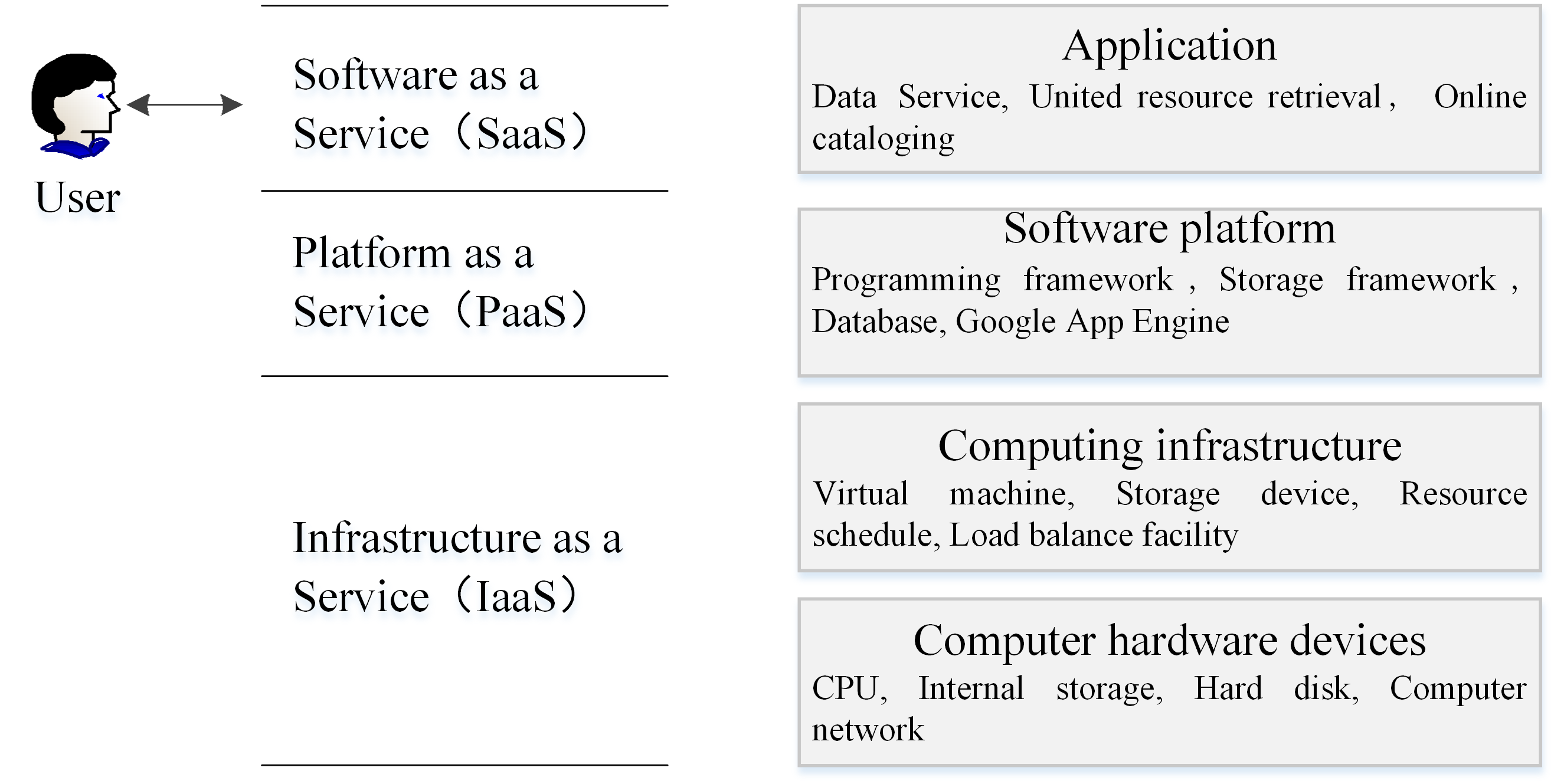
Figure 1. Tier Structure of Cloud Computing
3. Framework of Digital Libraries
In this section, a new distributed digital library framework based on cloud computing is proposed. In combination with the design concept and technology of the cloud computing platform, the framework separates the subsystems of different functions within the system into logically independent structures with a function level division method. Each subsystem is not only logically separated but also arranged in different computing nodes in different areas. The system has both the characteristics of a distributed structure and the capacity of integrated distributed service with good expandability. The overall framework of the system is loosely coupled, and information is exchanged by way of message queue communication middleware and XML document flow with service bus integration. The mash-up and other techniques are also introduced for effective integration of the geographically distributed library resources and services, formulating an integrated distributed digital library system.
In accordance with the different business logic functions, the computing service nodes in the overall framework can be divided into two subsystems: business subsystem and service integration subsystem. Both of them can operate in several computer clusters in different areas, united to form a common consolidated digital library framework as shown in Figure 2. The following is a detailed introduction to the functions and characteristics of the two kinds of subsystems.
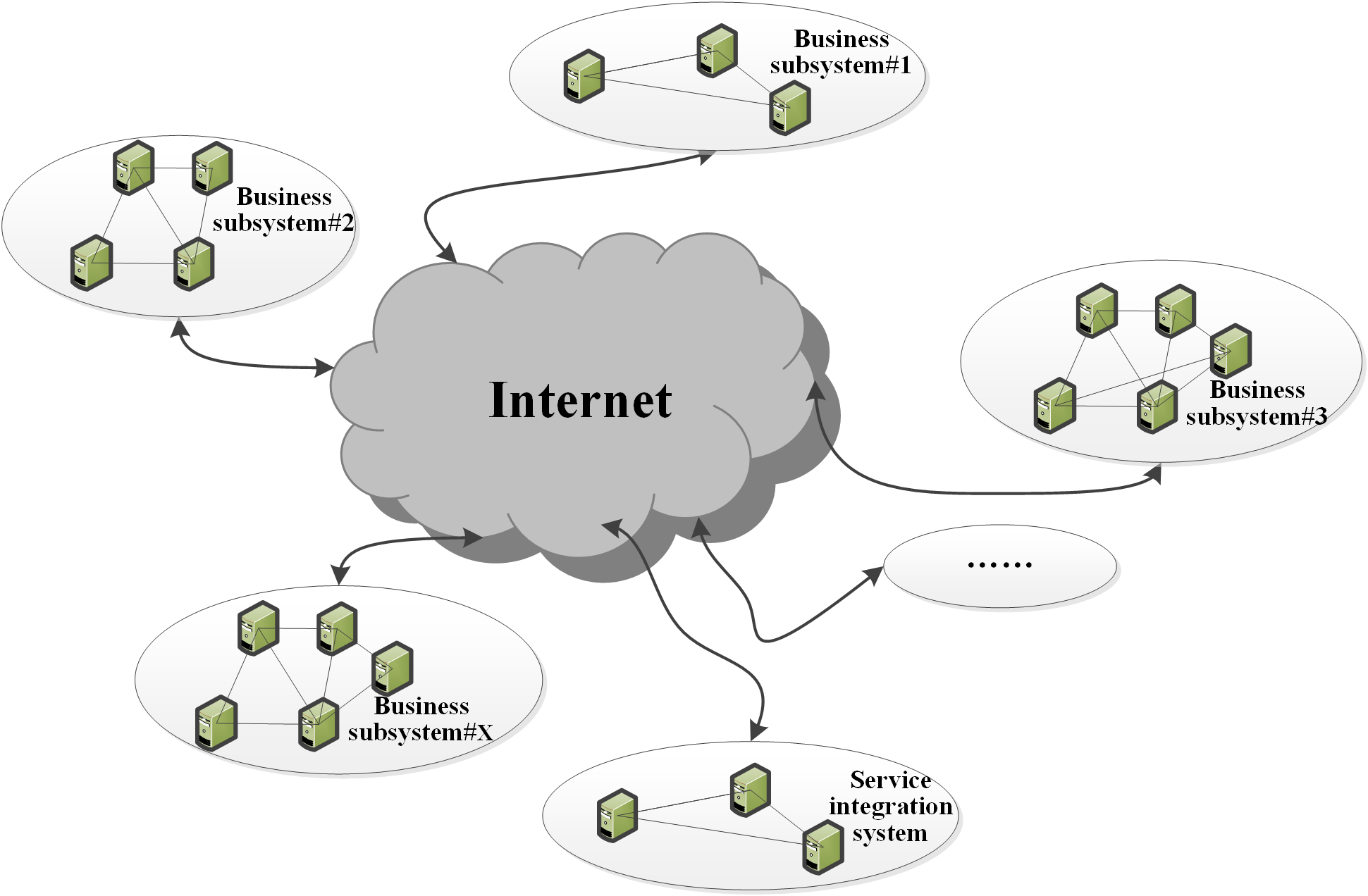
Figure 2. System Organization Framework
3.1 Business Subsystem
The business subsystem is made up of one or several geographically distributed or concentrated computer nodes, and a number of business subsystems form the business support and application centre of the overall distributed digital library system.
The base of the business subsystem is the hardware cluster supporting system operation, including the basic hardware device, cluster system management device, and logically complete digital library operation basic framework as well as relevant digital resources. Driving the hardware clusters of each business subsystem is the basic cluster operation system software, managing such operations as system load balance, system log, and cluster monitoring system, as well as the distributed computing organization framework built on this basis, such as the data storage framework and semi-structured data storage framework based on NoSQL [6]. The above mentioned distributed data management and storage system forms the basic cluster system of digital libraries, and makes up the complete base platform of individual business systems. The business system may prepare the basic cluster system with locally allocated distributed clusters or via a third party, that is, to build the basic cluster of the business subsystem by relying on the IaaS service or PaaS service provided by the third party.
Built on top of the cluster management system are the library data resources and application systems supporting the library business, including business systems of unified search, reference consultation, journal catalog, and online cataloging. Whether it is a locally allocated business system or via a third party, the structure and implementation mechanism are the same.
All of the functions and services of each business subsystem are kept complete and consolidated within the system, without influence or interference from other business subsystems. Different business subsystems operate independently by adopting a shared-nothing [7] framework, with the digital resources achieving independent data partitioning and application of different business subsystems by way of horizontal segmentation. In addition, the business subsystem includes the following two basic characteristics: (1) All business subsystems realize loose coupling and flexible expandability by way of modularization. Different business subsystems can offer services diversified in form but complementary in content. For instance, plentiful video data for distance education can be kept in some business subsystems to provide video teaching services, whereas relatively complete information on classic books is preserved in other business subsystems to offer literature-related research and services. (2) The business subsystem provides all services to users and realizes integration with third party services via open API. With service-oriented architecture (SOA) packaging, and by way of mash-up, data and services are integrated between different regions and various types of business subsystems, thus offering web-based services to the users.
3.2 Service Integration Subsystem
The service integration subsystem is a key component in integrating distributed services of digital libraries; it integrates and coordinates service functions, business logic, and organization and discovery of digital resources in different business subsystems, and provides the third party system or users with SaaS type library services. The service integration subsystem is compatible with all business subsystems via semantics and interfaces provided by open API, and provides open API trust service to all business subsystems. The individual business subsystem and service integration subsystem jointly form a new service system which is low coupling, highly cohesive, controllable, and self-adaptable. An integrated framework is achieved by way of SOA.
The service integration subsystem and business subsystem operate in different process spaces. Resources, services, and functions provided by different business subsystems are managed and made accessible by means of registration. Credible business subsystems first register service interfaces, data resource scale, data resource contents, URI information, and other contents provided by the service integration subsystem. When the service integration subsystem gets all the required information for registration, the relevant information is renewed in the business system database, and the available resource list of the system is refreshed by intermittent scanning in batch model. When users log on for a second time, they can see the newly added resources via Web page. In cases of failed automatic registration, system managers must make checks and manually add new resources at the front end. Moreover, the business subsystem can dynamically register, add, revise, or cancel the provided resources and services in accordance with its actual situation.
The service integration subsystem is the gateway for users to access and make use of library services. It provides cross-platform, cross-region, integrated, and one-stop library integration service by adopting Web sites via the Internet. Once the users gain access to the service integration subsystem, they are under the management of the access control mechanism. Once access has been gained to these resources, the functions and services provided by the platform can be fully utilized.
3.3 Integration with the Existing Digital Library System
An important criterion in judging whether an information system function is complete is its compatibility with the existing system, thus ensuring a smooth upgrading and transition process. Though the framework described in this paper is mainly applicable to a newly established distributed digital library system, there are two ways for the resources or services of existing digital libraries to be integrated into the system without influencing its normal function. (1) Integration at the metadata tier via the CALIS Nebula framework. Centralized management of metadata is realized by means of metadata partitioning, which leads to resource retrieval and browsing of multiple digital library systems, as well as integration and management of metadata information at the node tier. (2) Complete (large-grained) service integration by means of non-invasive proxy user. The system manager sets up a workable proxy account in the business subsystem and sets permissions to the available functions and accessible resources of the account. The account is used by the external system to access resources and services newly added to the digital libraries. Integration of resources and services is effectively gained between the new entry system and the entire system by way of this large-grained integration, without influencing the independent operation of the new entry system. As the new entry system represents the basic service-providing subsystem at the service integration subsystem tier, other users only need to control the user authentication when they use proxy accounts to access the entire system. The business subsystem tier is completely transparent to the other parts of the entire system.
4. Tiers and Key Technologies of Digital Libraries
4.1 Tiers
Figure 3 shows the function tiers of the entire system. The whole digital library framework includes five major tiers. They are bottom-up infrastructure device tier, digital resource tier, system management tier, business logic tier, and user interface tier. The multi-tier structure shapes a controllable, self-adaptable new digital library service system.
The infrastructure device tier provides the fundamental environment of the system platform, and its overall scale is decided by the size of the library and the number of users carried. Meanwhile, the use of system software operation environment and hardware device shall be taken into overall consideration with an eye to the expansion of digital resources and the expected increase in users over time. The construction of hardware devices includes network environment, communication and transmission equipment, servers and storage equipment, computer room conditions, and system software, as well as associated contents like network security, and system operation and maintenance. In combination with analysis on the above mentioned key components, the infrastructure device tier is distributed in different computer nodes of the business and service integration subsystems or in the trusted cloud service environment.
The digital resource tier includes information resources developed by libraries in accordance with standard specifications, introduced business databases, and other network information resources and open social resources. Each business subsystem owns independent digital resources, software, and basic hardware devices, and the digital resource tier is logically located in different business subsystems.
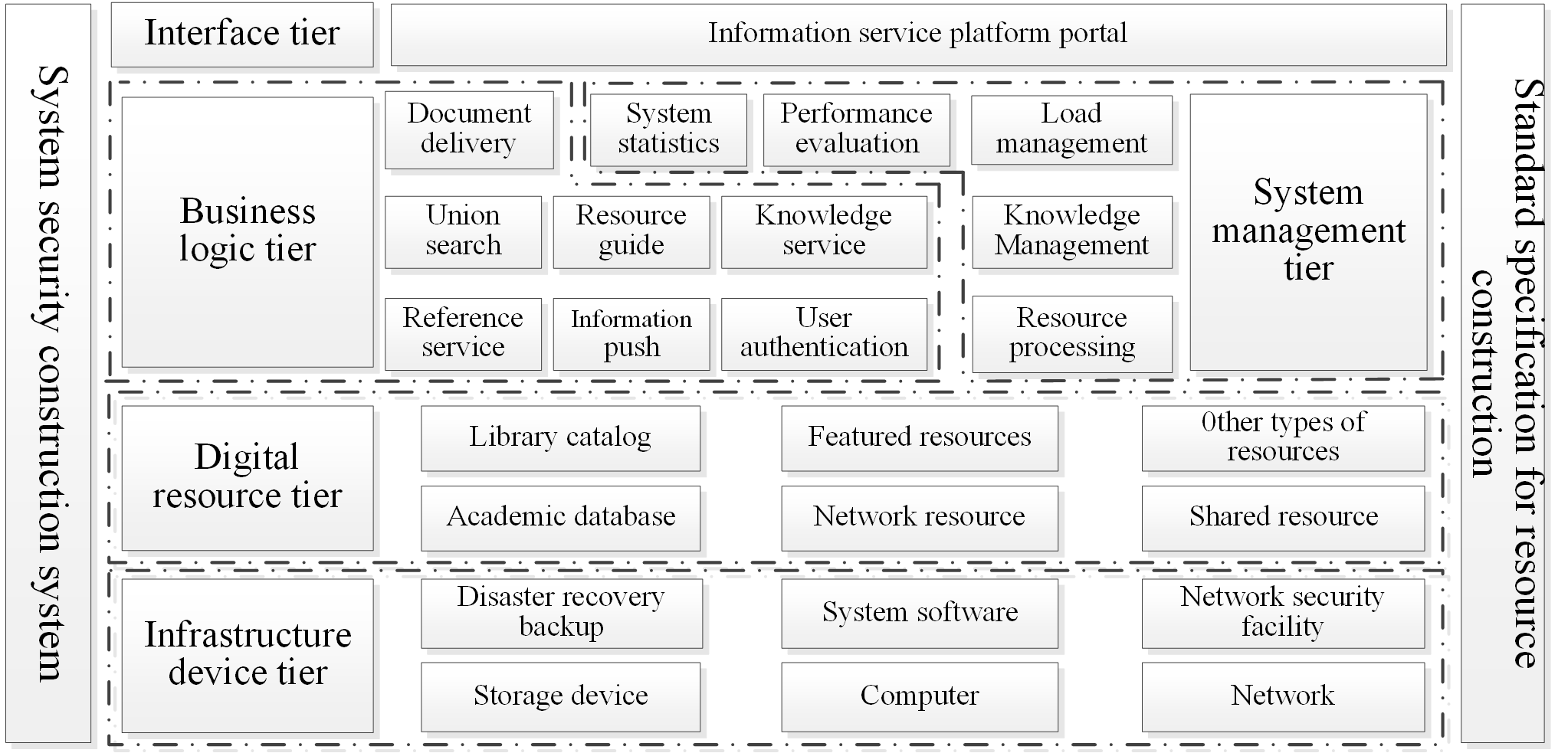
Figure 3. Function Tier Chart of Digital Libraries
The system management tier includes such application system modules as user authentication, resource processing, resource purchase, copyright protection, performance evaluation, resource scheduling, and system statistics. It is also logically distributed in different business subsystems because of the need to directly manage the corresponding hardware device and digital resources. In addition, certain functions of the system management tier are distributed in the service integration subsystems, such as the uniform authentication system, account management, log system, resource distribution control, data resource scheduling, secure data links, and so on.
In parallel to the system management tier is the business logic tier, which includes all the business functions and services of libraries. According to functional distinction, the business logic tier includes heterogeneous retrieval, remote access, union catalog, resource guide, reference service, document delivery, information push, My Library, and various kinds of services. The services provided by the business logic tier are specific user-oriented digital library service items, which are also the basis to realize resource integration, information organization, and online service of digital libraries. The business logic is established directly above and closely coupled with the digital resource layer.
On top of the system framework is the user interface tier It is the interface for users to access information resources and digital library services. Users’ authentication and authorization are done via a user management component at the system management tier. Once the user logs on, he can easily access the required resources and services, and customize individualized pages without repeatedly logging on to different business subsystems.
4.2 Key Technologies
Key technologies to materialize the overall framework described in this paper can be separated into the following five categories:
(1) Master-slave distributed architecture. The business subsystem is the slave, and the service integration subsystem is the master of the entire system. The master includes all the registered node information, meta information of business requirements, and corresponding business subsystem. The master-slave framework, simple in structure, is easy to be realized, but there is the possibility of single point of failure (SPOF) [8], that is, a breakdown in the master system could leave the entire system inoperable. To solve this problem, a hot standby or multi-machine backup mechanism can be adopted by the master. In consideration of the reality of more reading and less writing in the whole business process of the digital library system, the hot standby and checkpoint-based log management mechanism are quite able to overcome any SPOF weaknesses, thus preventing the failure of computing nodes in service integration subsystem from making errors in the overall services.
(2) One-stop authentication mechanism. The service integration subsystem provides a uniform user authentication mechanism. When users enter the system successfully, they can cut across the identification authentication processes of all business subsystems via the service integration subsystem. The API interface helps the service integration subsystem to complete the functions of safe call and identification authentication, and to ensure that all logged-in users can successfully pass the trusted access controlled service of the secure control mechanism. To the interfaces in need of identification authentication, any application system calling these interfaces must follow the standard specifications defined by the service integration subsystem. In addition, one-stop authentication requires all business subsystems match the authentication system of called service integration subsystem. Thus, seamless integration can be made in an effective way.
(3) VPN technology. VPN is a widely used secure communication mechanism. VPN technology can build a secure virtual private cloud in an open Internet environment. When combined with the one-stop authentication mechanism, VPN technology can help users gain secure and easy access to resources and services provided by digital libraries over the Internet wherever they are.
(4) Multi-channel business integration. The service integration subsystem offers multiple flexible methods of integration. For instance, users have creation and customization control over things like mash-up, and have such services as REST, RSS, and OAI integrated to control the scope and permission of integrated services. In this way, not only is security ensured for the integrated service, but also for the integrated results shared with the cooperative party.
(5) Integration of data and results. In terms of new entry system integrated to the entire system by way of proxy users, the mechanism of matching the results and data fusion is adopted to optimize the query results and to upgrade user experience because the non-invasive integration leads to a metadata black box, and the repetition of data and resources in different subsystems leads to overlapped query results.
5. Application
The China Central Radio & TV University (CCRTVU, aka “The Open University of China”, OUC) is developing Digital Library Project of Nationwide Open Universities. It aims to unify the OUC’s digital library and the 44 digital libraries from RTVUs (Open Universities) distributed in different provinces and cities into a uniform RTVU (OUC) digital library system to better serve the RTVUs (Open Universities), teachers, and students nationwide. In combination with CALIS third phase construction project [9], the CALIS application framework is taken as the main body framework of the RTVU (OUC) digital library system. A nationwide RTVU (Open University) digital library system is formed through sharing and connectivity of resources and services by open universities at all levels, and it joins the CALIS as an entity shared domain.
During the process of building the RTVU (Open University) digital library system, the system framework introduced in the thesis is used to build a prototype system, in which local RTVUs (Open Universities) set up business subsystems in harmony with local circumstances and their tasks for resource construction and service development. The CCRTVU (OUC) builds and maintains service integration subsystems, takes the responsibility of integrating and collaborating digital resources and service functions provided by all business subsystems, and offers the business subsystems leased SaaS services, such as inter-library lending and document delivery, combined reference and consultation, and thesis library system. Experience proves that the proposed distributed digital library framework model can operate effectively and provide constant and reliable service.
6. Conclusion
As a new distributed computing technology, cloud computing offers numerous advantages, including high scalability, easy access, low cost, and loose coupling, which offers new development thoughts and technical references for digital library construction. However, the application of cloud computing in a digital library is still a new topic, exposed to a series of technical difficulties, such as distributed liability, resource effectiveness, resource integration, and authentication control mechanism.
In this paper, a new distributed digital library framework is proposed in combination with such techniques as cloud computing platform, SOA, and VPN based on the contribution of the RTVU (Open University) digital library project. The framework is fully combined with the construction requirements of multi-layer management, distributed access, resource sharing, and service collaboration of the nationwide RTVU (Open University) digital libraries. It is universally applicable and can be favorably integrated with document information service systems like CALIS. The key nodes of the framework are divided into two categories, the business subsystem and service integration subsystem. The business subsystem is the specific implementation system of the digital library service, which is responsible for direct management and organization of digital resources, and provides basic digital library services. The service integration subsystem is in charge of integrating various types of resources and services provided by business subsystems and releasing them to users. Corresponding to the tiered system structure, the business subsystem includes all functions of the basic hardware and digital resource tier, as well as some functions of the business logic tier. In contrast, the service integration subsystem is in charge of system management, user interface, and other business logic. The multi-layered architecture forms a low coupling, highly cohesive, controllable, and self-adaptable new type of digital library service system, which better matches the diversified requirements of different types of users with differing levels of information resource access privileges.
References
[1] Qi Zhang, Lu Cheng, Raouf Boutaba. Cloud computing: state-of-the-art and research challenges[J]. J Internet Serv Appl. (2010) 1: 7-18.
[2] Zhang Zhenglu. A Review of Cloud Computing Research Among the Library and Information Circle in China [J]. Journal of The National Library of China.2010(3):73-76.
[3] Library Cloud Atlas: A Guide to Cloud Computing and Storage Stacking the Tech.[OL].[2011-6-1].
[4] Rochkind J. OCLC library management services. Bibliographic Wilderness. [OL].[ 2011-6-1].
[5] Kevin Liu. How Libraries Uprising with the Cloud Computing [J].Journal of Academic Libraries.2009(4):2-6.
[6] NoSQL.[OL].[2011-6-1].
[7] Shared-nothing Architecture.[OL].[2011-6-1].
[8] Single Point of Failure.[OL].[2011-6-1].
[9] Wang Wenqing, Chen Ling. The Model of CALIS Cloud Service Platform for Distributed
Digital Services [J]. Journal of Academic Libraries.2009(4):13-18.
In 2012, Massive Open Online Courses (MOOCs) have sparked great interest worldwide as an irresistible development trend. Renowned national and international universities and educational institutions set out to study and develop MOOC platforms one after another. Cooperation was carried out in the development of courses and platforms, in the mutual accreditation of certificates, and in credit transfer, and achievements were shared. MOOCs have brought great changes to online education and even traditional education. With further research and experience with MOOCs in the past two years, all the experts and scholars, universities and learners are becoming more informed in their choice of MOOCs. There is no doubt that MOOCs have promoted educational reform to some degree, and distance online education has been well publicized and popularized. More social public and educational institutions have realized the huge market potential and influence of online education. However, we should carefully consider whether the operation mode of the three major overseas MOOC platforms fit in with China’s traditional education concept, which emphasizes academic degrees over practical ability.